
500+ business plans and financial models

How to Write a Landscaping Business Plan: Complete Guide
- January 30, 2023

👇 Check all our resources on landscaping businesses 👇
Whether you’re looking to raise funding from private investors or to get a loan from a bank (like a SBA loan) for your landscaping business, you will need to prepare a solid business plan.
In this article we go through, step-by-step, all the different sections you need in your landscaping business plan. Use this template to create a complete, clear and solid business plan that get you funded.
1. Executive Summary
This is the first part and the most important section of your business plan. This is the first thing lenders and/or investors will have a look at.
Before we dive into the specifics, keep in mind the executive summary is a summary: keep it to 2 pages maximum. Indeed, your executive summary should briefly sum up the key sections of your business plan as well as presenting the funding ask.
Why do you need a business plan for your landscaping business?
The funding ask (or funding requirement), as explained below, is the reason why any business would have a business plan. Business plans are prepared for one of the 3 following objectives:
- Obtain financing from a bank or any other lender (a SBA loan for example)
- Obtain financing from private investors (business angels, investment funds, etc.)
- Get approval for a private or public grant
How to write an executive summary for a landscaping business plan?
The executive summary of your landscaping business plan should include the following important information:
- Business overview : the name of your company, its legal structure, the business model (franchise vs. independent landscaping business), the type of services you will offer (lawn maintenance, hardscaping, design, etc.), the customers you target (individuals or businesses, etc.)
- Market analysis : how big is the landscaping industry in your area? How many competitors are there? What services do they offer? etc.
- People : who is the management team? what is your/their experience in the landscaping industry?
- Financial plan : what is your expected revenue and profitability for the next 5 years? When do you expect to break-even? Simply include here a chart of your key financials (e.g. revenue, gross Profit, net profit , cash flow)
- Funding ask : what loan/investment/grant are you seeking? How much do you need? How long will this last?
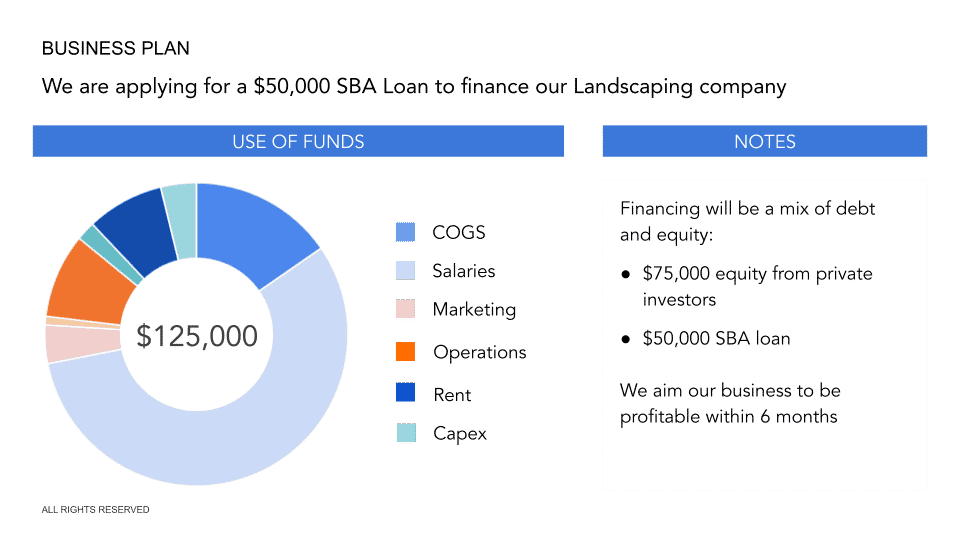
2. Landscaping Business Overview
The business overview section of your landscaping business plan highlights what services your landscaping company offers, to whom as well as how your business is structured legally.
Ideally, this section should include the following details about your business;
- The history of the project: why do you want to start this business today?
- The services you offer and their price range
- Your target customers: who are your customers (businesses or individuals?)
- Your company legal structure
a) History of the Project
Why did you decide to start your own landscaping business? Here a brief company history comes in handy if you want to outshine your competitors in the eyes of an investor (or a lender).
Use this section to mention 2 vital things about your landscaping business, including;
- Your interest and passion for getting into the landscaping business
- The rationale behind you starting a landscaping business today
For example, you might be an experienced landscaping worker and found out there was no company offering landscaping services to businesses in the area where you’re from.
b) Services
Landscaping companies have a number of services they offer to local customers, businesses or individuals. Ultimately, you should prioritize what suits your target audience depending on your market analysis. There are 2 main types of services for landscaping companies:
- Lawn maintenance: one of the most common services. It includes cleanups, pruning, fertilizing, aeration, lime application, mowing, and weed control
- Landscaping services instead include planting, mulching, landscape designing, hardscaping and foundation planting, to mention a few
Of course, there’s nothing wrong with offering both services if you have enough resources. You can also offer your landscaping services individually or as comprehensive packages based on your clients’ needs and budget.

c) Pricing Strategy
It’s crucial to outline your pricing list when writing a landscaping business plan. Focus on the most important details about your pricing structure without going overboard. For example, whilst lawn mowing costs on average $45 per week in the US, the cost of lawn care services ranges from $48 to $211 for homeowners .
Similarly, the cost of landscaping services may vary from one location to another, depending on the target audience. On an hourly basis, average landscaping services cost $50 to $100 per hour on average.
A clear pricing strategy can give you the upper hand when seeking financial support from potential investors and lenders, making it an important part of your landscaping business plan.
Also, it’s important to outline your pricing strategy in your business plan so investors can tie it into your financial projections later on (see more on that below).
d) Target Audience
What’s your target market ? Knowing your consumers will always play a key role in the success of your landscaping business. It also gives you a competitive advantage by helping you identify the existing market gap.
Are you targeting homeowners, commercial property managers, or businesses offices and headquarters? Understanding your target market will help you better define your marketing strategy and retain customers.
e) Legal Structure
Finally, your business overview section should specify what type of business structure you opt for. Is this a corporation or a partnership (LLC)? Who are the investors? How much equity percentage do they own? Is there a Board of Directors? If so, whom? Do they have experience in the industry?
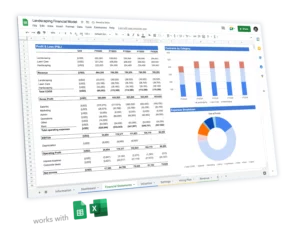
Landscaping Financial Model
Download an expert-built 5-year Excel financial model for your business plan
3. Landscaping Market Analysis
Now that we have covered all about your business, let’s now look at your industry, and more precisely the landscaping industry in your area, your competitors and target audience.
Indeed, before you reach out to lenders or investors, you must prove to them that you understand your market. This helps earn their trust and can make the difference fo them to invest in your business.
a) Landscaping Business Market Overview
You should present in this section the status quo of the landscaping industry in the US, as well as in your city / area. You must address 2 main points here:
How big is the landscaping industry in your area?
- How fast the market is growing?
How big is the landscaping industry in the US?
Before diving into your specific city or area, it’s always good to get a clear overview of the US market first. Indeed, getting national data will help you address all the factors that could affect your business, such as demographics, market demand, and environmental activities.
The landscaping industry has grown at a steady rate of 2.5% per year in the last few years, up to $105 billion in 2021 .
After the US, assess the status of the landscaping market in your city or area. Focus on the zone where you plan to offer your landscaping services.
Naturally, you might not be able to get the data for your specific city or region. Instead, you can estimate the size of your market, for more information on how to do it, read our article on how to estimate TAM, SAM and SOM for your startup . To give you an example, let’s assume you plan to operate in a radius where there are 40 competitors:
As we know the US landscaping industry is worth $105 billion today, and there are about 604,000 landscaping businesses (small and large) in the US in total, we can deduct that the average annual revenue per landscaping company is $175,000.
So we can safely assume the landscaping industry is worth $7,000,000 in the area where you plan to operate. Now, assuming there are 30,000 houses, this means each household that owns a house spend $195 per month in landscaping services, pretty close to the national average.
How fast is the landscaping industry growing in your area?
Growth is an important metric for assessing the status of the landscaping industry in your region.
Here if you don’t find information online or via your research, you can calculate growth using the total number of landscaping businesses in your area.
For instance, if there were 40 landscaping businesses in the region in 2019, which increased to 45 in 2022, it’s safe to assume that the market is growing at 4% per year.

b) Landscaping Competitor Analysis
At the very least, your competitor analysis should answer all or some of these questions:
- How many landscaping businesses are in your region?
- What services do your competitors offer? What’s their average price?
- How many employees do they have on the payroll?
- What’s the approximate number of customers/contracts they serve per month?
After answering these questions, it will be easier to tailor your services and prices to suit the target market.
c) Landscaping Business Customer Analysis
We presented in the Business Overview section who were your target customers. Here instead instead you must show in your business plan that these target customers actually live in the area and need the services you offer.
Indeed, it would be pointless to start a landscaping business in your region when nobody needs your services in the first place.
And having competitors doesn’t necessarily mean your target customers are there. For example, you might not focus on the same customer segment (e.g. individuals homeowners vs. businesses).
There are here a few important questions you must answer:
- What landscaping services do your target customers need?
- How many potential customers are there in the area (for example, if you focus on homeowners, you can use the number of houses in the area as a proxy)?
- How much does the average customer spend on landscaping in the area (if you can’t find the information for your city, use the national average instead)?
4. Sales & Marketing Strategy
The next section of your landscaping business plan gives you a chance to highlight your strategic plan for acquiring new clients.
Start by exploring your unique selling point, the suitability of the proposed marketing strategies, and the overall marketing budget.
a) Landscaping Marketing Channels
Here are a few examples of marketing channels landscaping businesses use:
- Email marketing
- Social media
- Website
- Local advertising (newspapers)
- Register with the online business directories (Yelp, Yellow Pages, etc.)
- Google Business profile and ratings
- Word-of-mouth recommendations
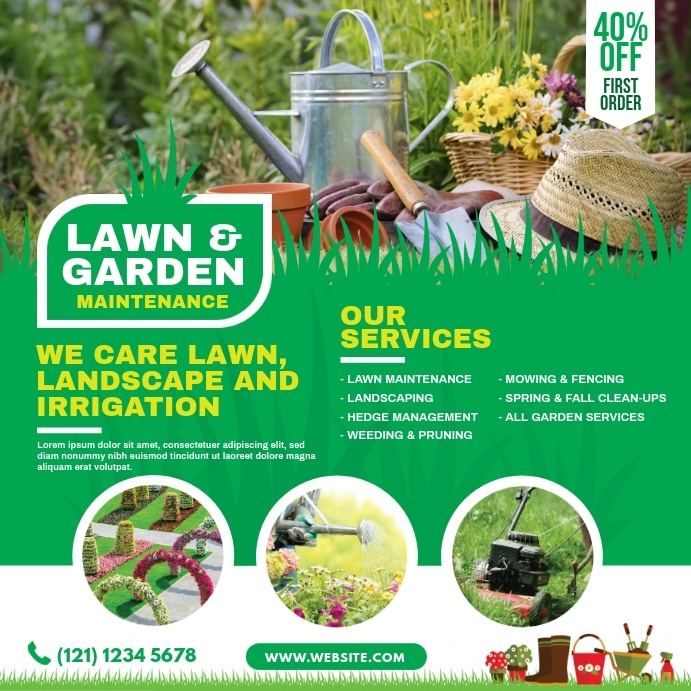
b) What are Your Unique Selling Points (USPs)?
A unique selling point makes you stand out in a competitive market. When getting started, it is the easiest way to win over multiple customers and one of the best strategies for edging out your biggest competitors. You can build your USPs around the following aspects;
- Price : affordable services will most likely appeal to most customers
- Specialization : choosing a specific service helps you stand out (for example, you might focus on landscape design and hardscaping)
- Additional services : you can provide extra services not available in the area
5. Management & People
The 5th section of your landscaping business plan should be about people. It should include 2 main elements:
- The management team and their experience / track record
- The organizational structure: what are the different teams and who reports to whom?
a) Management
Here you should list all the management roles in your company.
Of course, the amount of details you need to include here varies depending on the size of your company. For example, a landscaping business with a number of vehicles and teams would need more detail vs. a small landscaping business run by 1 or 2 persons.
If you plan on running your business independently, you may write a short paragraph explaining who are the co-founders and/or senior managers (if there are any in addition to yourself). It’s important to highlight their experience in the industry and previous relevant professional experiences.

b) Organizational structure
No matter how many leadership roles there are, you should now explain how you intend to run the company from a management standpoint.
What are the different teams (management, sales, operations, mechanics, finance, etc.)? Note that you should include these details even if you haven’t hired anyone yet. It will show lenders and investors that you have a solid hiring and management plan to run the business successfully.
A great addition here is to add an organizational chart that list all the roles, from Directors to managers, key supervisory roles, employees and contractors. Make sure to highlight with reporting lines who manages/supervises whom.
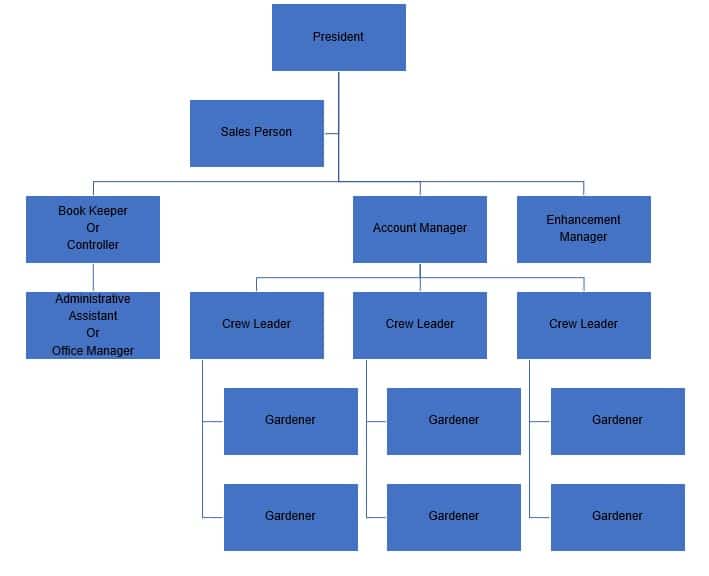
6. Financial Plan
The financial plan is perhaps, with the executive summary, the most important section of any business plan.
Indeed, a solid financial plan tells lenders that your business is viable and can repay the loan you need from them. If you’re looking to raise equity from private investors instead, a solid financial plan will prove them your landscaping business is an attractive investment.
There should be 3 sections to your financial plan section:
- Your historical financials (only if you already operate the business and have financial accounts to show)
- The startup costs of your project (if you start a new landscaping business or if you plan to purchase new equipment and vehicles, etc.)
- Your 5-year financial projections
a) Historical Financials (optional)
In the scenario where you already have some historical financials (a few quarters or a few years), include them. A summary of your financial statements in the form of charts e.g. revenue, gross profit and net profit is enough, save the rest for the appendix.
If you don’t have any, don’t worry, most new businesses don’t have any historical financials and that’s ok. If so, jump to Startup Costs instead.
b) Landscaping Startup Costs
Starting a small one-person landscaping business can cost as little as $500 , but most large-scale landscaping businesses need to spend more on equipment, marketing and staff. That’s why most landscaping businesses typically cost between $15,000 and $50,000 to start (excluding the cost of a vehicle).
As you can see, startup costs vary significantly according to factors like the size of your business, the number of employees, the quality of equipment, the services you offer and the tools needed, etc.
So, we have given you a clear overview below of all the essential costs you can expect to start a small landscaping business with 4 employees. There are 2 types of costs: startup costs and operating costs . For more information on how much it costs to start and run a landscaping business, read our complete guide here .
Note that these costs are for illustrative purposes and depend on several factors which might not fully apply to you.
c) Landscaping 5-Year Financial Projections
In addition to startup costs, you will now need to build a solid 5-year financial model as part of your business plan for your landscaping business.
Your financial projections should be built using a spreadsheet (e.g. Excel or Google Sheets) and presented in the form of tables and charts in your business plan.
As usual, keep it concise here and save details (for example detailed financial statements, financial metrics, key assumptions used for the projections) for the appendix instead.
Your financial projections should answer at least the following questions:
- How much revenue do you expect to generate over the next 5 years?
- When do you expect to break even?
- How much cash will you burn until you get there?
- What’s the impact of a change in pricing (say 20%) on your margins?
- What is your average customer acquisition cost?
You should include here your 3 financial statements (income statement, balance sheet and cash flow statement). This means you must forecast:
- The number of contracts (customers) you will win over time ;
- Your expected revenue ;
- Operating costs to run the business ;
- Any other cash flow items (e.g. capex, debt repayment, etc.).
When projecting your revenue, make sure to sensitize pricing and the number of contracts as a small change in these assumptions will have a big impact on your revenues.

7. Funding Ask
This is the last section of the business plan of your landscaping business. Now that we have explained what type of landscaping services your company offers and to whom, at what price, but also what’s your marketing strategy, where you go and how you get there, this section must answer the following questions:
- How much funding do you need?
- What financial instrument(s) do you need: is this equity or debt, or even a free-money public grant?
- How long will this funding last?
- Where else does the money come from? If you apply for a SBA loan for example, where does the other part of the investment come from (your own capital, private investors?)
If you raise debt:
- What percentage of the total funding the loan represents?
- What is the corresponding Debt Service Coverage Ratio ?
If you raise equity
- What percentage ownership are you selling as part of this funding round?
- What is the corresponding valuation of your business?
Use of Funds
Any business plan should include a clear use of funds section. This is where you explain how the money will be spent.
Will you spend most of the loan / investment to acquire the cost for the vehicles, tools and equipment? Or will it cover mostly the cost of the salaries of your employees the first few months?
Those are very important questions you should be able to answer in the blink of an eye. Don’t worry, this should come straight from your financial projections. If you’ve built solid projections like in our landscaping financial model template , you won’t have any issues answering these questions.
For the use of funds, we recommend using a pie chart like the one we have in our financial model template where we outline the main expenses categories as shown below.
Privacy Overview

How To Write a Successful Landscaping Business Plan + Template

Creating a business plan is essential for any business, but it can be especially helpful for landscaping businesses that want to improve their strategy and/or raise funding.
A well-crafted business plan not only outlines the vision for your company, but also documents a step-by-step roadmap of how you are going to accomplish it. In order to create an effective business plan, you must first understand the components that are essential to its success.
This article provides an overview of the key elements that every landscaping business owner should include in their business plan.
Download the Ultimate Landscaping Business Plan Template
What is a landscaping business plan.
A landscaping business plan is a formal written document that describes your company’s business strategy and its feasibility. It documents the reasons you will be successful, your areas of competitive advantage, and it includes information about your team members. Your business plan is a key document that will convince investors and lenders (if needed) that you are positioned to become a successful venture.
Why Write a Landscaping Business Plan?
A landscaping business plan is required for banks and investors. The document is a clear and concise guide of your business idea and the steps you will take to make it profitable.
Entrepreneurs can also use this as a roadmap when starting their new company or venture, especially if they are inexperienced in starting a business.
Writing an Effective Landscaping Business Plan
The following are the key components of a successful landscaping business plan:
Executive Summary
The executive summary of a landscaping business plan is a one to two page overview of your entire business plan. It should summarize the main points, which will be presented in full in the rest of your business plan.
- Start with a one-line description of your landscaping company
- Provide a short summary of the key points in each section of your business plan, which includes information about your company’s management team, industry analysis, competitive analysis, and financial forecast among others.
Company Description
This section should include a brief history of your company. Include a short description of how your company started, and provide a timeline of milestones your company has achieved.
If you are just starting your landscaping business, you may not have a long company history. Instead, you can include information about your professional experience in this industry and how and why you conceived your new venture. If you have worked for a similar company before or have been involved in an entrepreneurial venture before starting your landscaping firm, mention this.
You will also include information about your chosen landscaping business model and how, if applicable, it is different from other companies in your industry.
Industry Analysis
The industry or market analysis is an important component of a landscaping business plan. Conduct thorough market research to determine industry trends and document the size of your market.
Questions to answer include:
- What part of the landscaping industry are you targeting?
- How big is the market?
- What trends are happening in the industry right now (and if applicable, how do these trends support the success of your company)?
You should also include sources for the information you provide, such as published research reports and expert opinions.
Customer Analysis
This section should include a list of your target audience(s) with demographic and psychographic profiles (e.g., age, gender, income level, profession, job titles, interests). You will need to provide a profile of each customer segment separately, including their needs and wants.
For example, landscaping business customers may include residential homebuilders, commercial developers, and residential homeowners.
You can include information about how your customers make the decision to buy from you as well as what keeps them buying from you.
Develop a strategy for targeting those customers who are most likely to buy from you, as well as those that might be influenced to buy your products or landscaping services with the right marketing.
Competitive Analysis
The competitive analysis helps you determine how your product or service will be different from competitors, and what your unique selling proposition (USP) might be that will set you apart in this industry.
For each competitor, list their strengths and weaknesses. Next, determine your areas of competitive differentiation and/or advantage; that is, in what ways are you different from and ideally better than your competitors.
Below are sample competitive advantages your landscaping business may have:
- Established industry relationships
- Comprehensive services
- Wide range of landscaping services
- Customized services
- Use of the latest technology
Marketing Plan
This part of the business plan is where you determine and document your marketing plan. . Your plan should be clearly laid out, including the following 4 Ps.
- Product/Service : Detail your product/service offerings here. Document their features and benefits.
- Price : Document your pricing strategy here. In addition to stating the prices for your products/services, mention how your pricing compares to your competition.
- Place : Where will your customers find you? What channels of distribution (e.g., partnerships) will you use to reach them if applicable?
- Promotion : How will you reach your target customers? For example, you may use social media, write blog posts, create an email marketing campaign, use pay-per-click advertising, or launch a direct mail campaign. Or you may promote your landscaping business via a mix of these channels.
Operations Plan
This part of your landscaping business plan should include the following information:
- How will you deliver your product/service to customers? For example, will you do it in person or over the phone only?
- What infrastructure, equipment, and resources are needed to operate successfully? How can you meet those requirements within budget constraints?
The operations plan is where you also need to include your company’s business policies. You will want to establish policies related to everything from customer service to pricing, to the overall brand image you are trying to present.
Finally, and most importantly, in your Operations Plan, you will lay out the milestones your company hopes to achieve within the next five years. Create a chart that shows the key milestone(s) you hope to achieve each quarter for the next four quarters, and then each year for the following four years. Examples of milestones for a landscaping business include reaching $X in sales. Other examples include adding new services, expanding to a new location, or hiring new employees.
Management Team
List your team members here including their names and titles, as well as their expertise and experience relevant to your specific landscaping industry. Include brief biography sketches for each team member.
Particularly if you are seeking funding, the goal of this section is to convince investors and lenders that your team has the expertise and experience to execute on your plan. If you are missing key team members, document the roles and responsibilities you plan to hire for in the future.
Financial Plan
Here you will include a summary of your complete and detailed financial plan (your full financial projections go in the Appendix).
This includes the following three financial statements:
Income Statement
Your income statement should include:
- Revenue : how much revenue you generate.
- Cost of Goods Sold : These are your direct costs associated with generating revenue. This includes labor costs, as well as the cost of any equipment and supplies used to deliver the product/service offering.
- Net Income (or loss) : Once expenses and revenue are totaled and deducted from each other, this is the net income or loss.
Sample Income Statement for a Startup Landscaping Company
Balance sheet.
Include a balance sheet that shows your assets, liabilities, and equity. Your balance sheet should include:
- Assets : All of the things you own (including cash).
- Liabilities : This is what you owe against your company’s assets, such as accounts payable or loans.
- Equity : The worth of your business after all liabilities and assets are totaled and deducted from each other.
Sample Balance Sheet for a Startup Landscaping Company
Cash flow statement.
Include a cash flow statement showing how much cash comes in, how much cash goes out and a net cash flow for each year. The cash flow statement should include:
- Cash Flow From Operations
- Cash Flow From Investments
- Cash Flow From Financing
Below is a sample of a projected cash flow statement for a startup landscaping business.
Sample Cash Flow Statement for a Startup Landscaping Company
You will also want to include an appendix section which will include:
- Your complete financial projections
- A complete list of your company’s business policies and procedures related to the rest of the business plan (marketing, operations, etc.)
- Any other documentation which supports what you included in the body of your business plan.
Writing a good business plan gives you the advantage of being fully prepared to launch and/or grow your landscaping company. It not only outlines your business vision but also provides a step-by-step process of how you are going to accomplish it.
This guide has provided you with a basic outline of what should be included in your landscaping business plan. Use this as a starting point and tailor it to fit the specific needs of your company.
Finish Your Landscaping Business Plan in 1 Day!
Other helpful articles.
How To Develop Your Landscaping Mission Statement + Examples
How to write an effective landscaping business plan

Key takeaways
- An organized business plan paves the way to launch a successful landscaping company
- Landscaping business plans are just as important for new companies as they are for established companies seeking investors
- There are seven core sections of a landscaping business plan that can help you succeed and reach profitability
A landscaping business plan is a must if you’re thinking about starting your own landscaping company or seeking funds to grow your business. More than just a document, a business plan is a valuable tool all small business owners should rely on to plan a successful company.
Business plans benefit companies of all stages—whether you’re just launching your lawn care business or already have a few years under your belt. In fact, companies that take the time to write a business plan typically grow 30% faster than those that don’t .
Although writing a business plan takes a significant amount of planning and research, the process doesn’t need to be overly complicated. There are seven core sections to include. Learn how to write your landscaping business plan so you can set your company up for success and secure the funding you need from potential investors.
7 core sections of a landscaping business plan
A landscaping business plan allows you to set your company up for success. It helps you figure out if you have a viable business idea, creates a roadmap for launching your business, and organizes your thoughts.
Your landscaping business plan should include the following seven sections:
- Executive summary
- Business description
- Market analysis
- Services or product line
- Operations and management
- Marketing and sales
- Financial factors
Let’s review the specific details you should include in each section of your business plan.
1. Executive summary
An executive summary gives an overall description of your company and kicks off your business plan . It describes who you are, what you do, and why your landscaping company will succeed.
You can keep this section brief and high level, but make sure to include the following:
- Mission statement
- Description of your business
- Leadership team and number of employees
- Services you offer
- Where you’re doing business
- Why you’ll succeed
It’s good practice to write your executive summary after you’ve filled out all other sections of your business plan . This will help you first figure out all the details regarding your business, allowing you to then craft an effective executive summary .
2. Business description
The business description goes more in-depth and covers the finer details of your landscaping business . This is where you explain your competitive advantage, which problems you solve, and why your company will succeed in your market.
Highlight the value you bring to consumers and what sets you apart from your competition. Be clear about what makes you better than competitors and outline your company’s strengths.
Do you have employees who have many years of experience in the landscaping business ? Is there an opening in the market that makes you uniquely fit to fill a certain niche?
Also, discuss which customers you plan on serving. Is your target market more focused on residential customers, like homeowners ? Or will you go after commercial customers, such as offices and larger business accounts?
3. Market analysis
Before jumping into starting your own landscaping business , you must take a look at the overall industry and your competition . Analyzing the market helps you determine if there’s enough room in your area for another business like yours to be successful.
Take a look at the landscaping industry as a whole. Is consumer spending within the landscaping industry on the rise?
You can estimate market saturation by simply taking a count of how many landscaping businesses are operating in your area. Figure out where these landscaping companies serve and determine if there’s an opportunity for you to enter the market and win over new customers.
Analyze what these competitors are doing well and find areas for improvement. Reading through your competitors’ Yelp reviews is an easy way to figure out what their strengths and weaknesses are from a consumer standpoint.
Understanding the strengths and weaknesses of other landscaping companies will enable you to optimize your business practices and earn market share when first starting out.
4. Services or product line
The services and product line section of your landscaping business plan tells readers how you expect to make money. Specify the exact lawn care services you’ll provide customers and which niche you’ll serve.
Landscaping companies can offer more than only lawn mowing, but it’s best to choose only a few services you can adequately offer without overextending yourself. Service options may include:
- I nstalling sod or mulch
- Planting flowers and other plants
- Fertilizing
- Pest control
- Landscape design
- Ongoing lawn maintenance
Pick the landscaping services you’re qualified to offer and list them in this section. It’s also helpful if you discuss the frequency of your services. For example, are most customers receiving weekly lawn cutting or will you provide services on a bi-weekly basis?
5. Operations and management
The operations section of your landscaping business plan highlights what type of business structure you’re forming and how your leadership team is organized.
Explain what type of business you’re forming. You can choose between a sole proprietorship, partnership, limited liability company (LLC), or corporation. You can find more information by reading through our guide on registering your business .
You’ll then need to provide an organizational chart that introduces the leaders of your company and provides a hierarchy of your team. Detail who holds which responsibilities and the hierarchy of your leadership team. If you’re the only member of your company, you can give a professional overview of yourself.
Talk about each employee and give each person’s years of experience and qualifications. Highlight areas that show why they’re the right fit for the job and how they’ll help your business succeed. You can even include brief resumes of your key employees to strengthen this section.
6. Marketing and sales
The marketing and sales section of your landscaping business plan tells readers how you’ll find and retain customers. There are many different landscaping marketing strategies that can help you find new leads and build lasting relationships with current customers.
A professional-looking website is a significant aspect of your marketing strategy . It will serve as the face of your company online. Most marketing channels will direct potential customers to your website.
You’ll also need to find ways to capture the attention of potential customers and encourage them to visit your website or contact you directly via phone or email. Some effective marketing strategies include:
- Email marketing
- Referral program
- Pay-per-click digital advertising
- Social media marketing
- Claiming your Yelp Business Page
- Search engine optimization (SEO)
- Content marketing
Choose the appropriate strategies, create a marketing plan , and highlight them in this section. Explain how you expect to find new leads to grow your business and how you plan on building trust , retaining current clients and earning customer loyalty .
Get a free Yelp page
Promote your business to local customers.
7. Financial factors
The finance section of your lawn care business plan offers realistic financial projections for your company. You’ll need to show readers that your business will be financially stable, especially if you’re seeking funding .
Analyzing your financials will help you determine if a landscaping business is worth pursuing. It’s important that you’re realistic with your expectations and have the appropriate funds to launch your business.
List all of the startup costs you expect to encounter. This can include expenditures like a lawnmower , work vehicles, edgers , or trimmers . From there you can determine the pricing of your services.
You can include financial statements like income statements, balance sheets , and cash flow statements if you’ve already launched your business. This will give tangible evidence for potential investors or lenders to determine if you have a viable business idea they’re willing to put money into.
You can also add a funding request if you’re seeking investment from a third party. Just be sure to include how much capital you’ll need, what you intend on doing with the funds, and how long investors can expect for your company to reach profitability . The time it takes you to reach profitability will depend on startup costs, pricing, and how quickly you can build your customer base.
Build a strong foundation with your business plan
It’s in your best interest to write a business plan before you embark on your entrepreneurial endeavor. It will serve as the foundation of your company and guide your future decisions. A well-thought-out business plan allows you to confidently navigate uncharted waters with a roadmap to follow.
Once you’ve organized your landscaping business plan , you can hit the ground running. After your business starts picking up, claim your Yelp Business Page and begin receiving reviews from happy customers.
The information above is provided for educational and informational purposes only. It is not intended to be a substitute for professional advice and may not be suitable for your circumstances. Unless stated otherwise, references to third-party links, services, or products do not constitute endorsement by Yelp.
Related stories

How to write an effective cleaning services business plan
Discover the six key sections you need to include in your business plan template to set up your cleaning company for success.

The ultimate guide to starting a small business
This 9-step guide will help you learn what it takes to start your own small business and smoothly transition into entrepreneurship.
ZenBusinessPlans
Home » Sample Business Plans » Real Estate
How to Write a Landscaping Business Plan [Sample Template]
Are you about starting a landscaping company? If YES, here’s a complete sample landscaping business plan template & feasibility report to help you get started. Okay, so we have considered all the requirements for starting a landscaping business. We also took it further by analyzing and drafting a sample landscaping marketing plan template backed up by actionable guerrilla marketing ideas for landscaping businesses. So let’s proceed to the business planning section.
A Sample Landscaping Business Plan Template
1. industry overview.
It is not enough to own a property that is well designed and built; the hallmark of any property is the beauty of the lawns and gardens. Landscapers are in the business of giving total esthetic effect in and around our neighborhoods. It is not enough to plant flowers or have a lawn in your compound and just watch them grow; you need to hire a professional landscaping company to help you bring out the beauty in your environment.
Landscape architecture is all about the art, planning, designing, management, preservation and rehabilitation of the land and the design of a large man – made concepts; it beautifies our environment. Landscaping business just like Lawn care business is not one of those businesses that you can start and make big money from without truly working pretty hard and smart.
Any entrepreneur who intends to start his or her own landscaping business with the aim of making huge profits from it must be very creative and ready to go the extra mile to convince clients that he or she can deliver an excellent job. Furthermore, you have got to prove beyond every reasonable doubt that you are competent.
In a publication released by a Professional Land-care Network (PLANET), an international association serving landscaping professionals, lawn care professionals, exterior maintenance contractors, installation/design/building professionals, and interior scapers, there are approximately 12,000 landscapers in the united states of America.
This statistics covers independent operators, franchises and large corporate chains. They also stated that the number of professional landscapers could actually be considerably higher because there are so many people doing landscape maintenance on part – time and on a pay as you go basis.
Lastly, according to the Occupational Outlook Handbook, published in 2006-2007 (U.S. Department of Labor), is that almost 1 out of every 4 landscaping, grounds – keeping, nursery, greenhouse and lawn service workers is self-employed and provides maintenance services directly to customers on a contract basis. Of these, about 1 out of every 6 works part time.
Although, landscaping business might not be amongst the money spinning businesses in the US, but they have a very large market that is readily available for them if they can convince property owners to patronize their services.
As a matter of fact, statistics has it that the United States green industry (landscape and lawn maintenance, landscape contractors, landscape architects, irrigation contractors, and lawn and landscape product suppliers) generates roughly $67 billion to $69 billion annually. PLANET estimates that the landscaping services sector alone generates about 704,000 jobs and $35.6 million in value-added services annually in the US; it is indeed a growing industry.
Landscaping business also falls in the category of seasonal businesses. The industry experiences downtime during the winter period and in most states in the US. In general, the demand for landscaping services is usually at its peak in the spring and generally between April and October. Which is why landscaping companies are always everywhere sourcing for business deals within this period of the year.
If you are familiar with the landscaping industry, you will notice that most landscaping companies do not restrict their services to only landscape architecture et al; they ensure that they add additional services such as lawn care services, snow plowing services (during winter season), fumigation services and any other similar services just to ensure that they maintain steady in – flow of income during peak and off peak periods.
As such; any entrepreneur who wants to start a landscaping business in the US should be aware that the landscaping and lawn care industry is a closely regulated industry that requires practitioners to earn certifications that permit them to handle hazardous compounds; most especially when they also offer fumigation services.
2. Executive Summary
Glover and Greenhouse Landscape Company is a licensed landscape architecture company that will be based in Miami Beach, Florida –United States of America and will have active presence in other cities such as; Greenacres City, Miami, Jacksonville, Clearwater, Tampa, Fort Lauderdale, North Miami, West Palm Beach, Palm Harbor, Deltona, Orlando, Palm Bay and Panama City et al.
We chose to operate in these cities because we know that our services will be in high demand due to the geographical nature of Florida. Glover and Greenhouse Landscape Company is in the business of beautifying in our environment by offering professional landscape architecture services. We know that the beauty of a city or property is not complete if the gardens or lawns are not properly designed and managed.
We know the importance of networking with the right set of people, which is why we have form partnership with stake holders (landlord associations, property managers and relevant government agencies) in Florida.
Glover and Greenhouse Landscape Company is specialized in handling golf courses, beach houses, major roads and streets as well as residential buildings and public facilities et al. As a matter of fact, when it comes to giving golf course the professional outlook it deserves, we are on top of the game.
We have some of the finest landscapers, who are gifted and also have gone ahead to acquire the relevant trainings that will make them create esthetic effect in the environment that will be second to none.
Glover and Greenhouse Landscape Company is fully aware of the seasonal nature of the business which is why we have made provision to engage in complimentary services during off peak period. We will engage in snow plowing during winter, sale of flowers, tree cutting, fumigation and other related services.
We will also provide consultancy services to homeowners, property managers and the government when it comes to creating the esthetic effect that will bring out the beauty in our environment.
Glover and Greenhouse Landscape Company is a private registered company landscape company that is owned by Glover Carrington and family. The company will be fully and single handedly financed by the owner – Glover Carrington. The business will be managed by his son Gordon Carrington; he is a member of the American Society of Landscape Architects (ASLA).
Mr. Gordon Carrington (Master of Landscape Architecture – MLA) is a core professional who has experience in sensitivity to landscape quality, ability to analyze problems in terms of design and physical forms, understands the arts and humanistic approach to design and he has skills in all aspects of professional practice including management and professional ethics. He has well over 7 years of experience in the industry.
3. Our Products and Services
Glover and Greenhouse Landscape Company is in the business of bring out the beauty in our environment and our services will be carried out by highly trained professionals who know what it takes to give our highly esteemed customers value for their money.These are the services that Glover and Greenhouse Landscape Company will be offering;
- Landscape architecture services
- Landscape care/maintenance services
- Trimming Landscaping
- Landscape design/contracting services
- Lawn mowing/maintenance
- Sod installation/hydro – seeding
- Weeding or fertilizer and/or pest control application
- Weekly lawn cut
- Weeding Beds
- Sale of flowers
- Spring Cleanup
- Fall Cleanup
- Chemical Treatment
- Snow Plowing
- Consultancy and Advisory Services
4. Our Mission and Vision Statement
- Our Vision is to become the number one choice of homeowners, property managers and government agencies when it comes to landscaping services in Florida, U.S.
- Glover and Greenhouse Landscaping Company is a business positioned to be the become the leaders when it comes to bringing out the beauty (esthetics) in our environment by offering top notch landscaping architectural services and other related services in Miami Beach and other cities in Florida, U.S.
Our Business Structure
Glover and Greenhouse Landscaping Company will be headquartered in Miami Beach, but will operate in other cities in Florida which is why we designed our business structure to support the nature of our operations. We want to create a team of dedicated workforce that will help the organization achieve its aim of becoming the number one landscape company in the whole of Florida.
Because we don’t have the required finance to manage the numbers of workforce that we would need, we have made provisions to hire some freelance landscapers to help us handle some contracts when the need arises. Here is the business structure of Glover and Greenhouse Landscape Company;
- Chief Operating Officer (Owner)
- Sales and Marketing Executive
Landscape Architect / Landscapist
- Field Staff
- Front Desk Officer
5. Job Roles and Responsibilities
Chief Operating Officer:
- Responsible for providing direction for the business
- Creates, communicates, and implements the organization’s vision, mission, and overall direction – i.e. leading the development and implementation of the overall organization’s strategy.
- Responsible for the day to day running of the business
- Responsible for handling high profile clients and deals
- Responsible for fixing prices and signing business deals
- Responsible for signing checks and documents on behalf of the company
- Evaluates the success of the organization at regular interval
- Responsible for the planning, management and coordinating all projects on behalf of the company
- Supervises projects
- Ensures compliance during project executions
- Provides advice on the management of projects
- Responsible for carrying out risk assessment
- Uses IT systems and software to keep track of people and progress of ongoing projects
- Responsible for overseeing the accounting, costing and billing of every project
- Represents the organization’s interest at various stakeholders meetings
- Ensures that project desired result is achieved, the most efficient resources are utilized and different interests involved are satisfied. Responsible for preparing financial reports, budgets, and financial statements for the organization
- Responsible for overseeing the smooth running of HR and administrative tasks for the organization
- Handles all financial transactions for the company
- Defines job positions for recruitment and managing interviewing process
- Carries out staff induction for new team members
- Responsible for training, evaluation and assessment of employees
- Oversees the smooth running of the daily office activities.
Sales and Marketing Officer
- Identifies, prioritizes, and reaches out to new partners, and business opportunities et al
- Develops, executes and evaluates new plans for expanding increase sales
- Documents all customer contact and information.
- Represents the company in strategic meetings
- Helps increase sales and growth for the company
- Lists the property for rent / lease to the public
- Markets space; finds tenants; participates in lease negotiations.
- Provides property owners with a real property condition disclosure (if required by law) and other necessary forms.
- Prepares necessary papers describing the property for advertising, pamphlets, open houses, etc.
- Holds an open house to show the property.
- Serves as a contact available to answer any questions about the property and schedule showing appointments.
- Responsible for planning and designing of places such as residential development area, parks, campuses, cemeteries, resorts, commercial centers, water fronts and corporate and institutional centers.
- Responsible for designing and implementing projects that respect both the needs of people and our environment
- Offers training and consultancy services
- Responsible for analyzing problems in terms of design and physical form
- Responsible for translating designs into a built work
- Responsible from training of field workers and freelancers
Field Workers
- Responsible for Lawn mowing/maintenance
- Handles Sod installation/hydro – seeding
- Handles Landscape care/maintenance services
- Carries out task in line with the stated job description
- Handles snow plowing
- Handles tree cutting
- Assists in transport working tools and equipment from the office (store) to site and back to the office
- Handles any other duties as assigned my the line manager
Front Desk / Customer’s Service Officer
- Receives Visitors / clients on behalf of the organization
- Receives parcels / documents for the company
- Handles enquiries via e-mail and phone calls for the organization
6. SWOT Analysis
Glover and Greenhouse Landscape Company is in business for the purpose of making profits and building long lasting relationship with its clients and we know that in order for us to achieve these, we must be able to leverage on our strengths and take hold of all the opportunities that we come across.
We are aware that if effective strategies are not put in place, the weakness of a company and the threats that the business will be exposed to can strangulate the business which is why we have decided to take out time to conduct a SWOT analysis for Glover and Greenhouse Landscape Company.
As a company, we look forward to maximizing our strength and opportunities and also to develop strategies that will help us effectively handle our weaknesses and threats. Here is a summary from the result of the SWOT analysis that was conducted on behalf of Glover and Greenhouse Landscape Company;
Our strength as a landscape company is the fact that we have healthy relationships with key stakeholders in Florida. We have some of the latest equipment that will help us deliver neat and excellent jobs. Our management team and workforce are highly trained and qualified to deliver excellent jobs within record time. We are well positioned and we have active presence in major cities in Florida.
Our weakness could be that we are a new landscaping company in Miami Beach, Florida and it will require consistency for us to gain the confidence of our prospective clients (homeowners, property managers and even the government).
- Opportunities:
The opportunities that are available to us cannot be quantified; we know that there are loads of homeowners, property managers and government establishment that will require our services in Miami Beach and other cities in Florida.
Some of the threats that we are likely going to face as a landscaping company are global economic downturn that can impact negatively on household spending, bad weather cum natural disasters and the arrival of a competitor ( a company that offer same service as we do ) within same location. There is hardly anything we could do as regards these threats other than to be optimistic that things will continue to work for our good.
7. MARKET ANALYSIS
- Market Trends
It is a common trend in landscaping and lawn care industry to see loads of landscapers struggle to meet ends meet. This is so because a larger percentage of people who are supposed to patronize their services are reluctant when it comes to paying the true worth of the services rendered.
It is also a common trend to see landscape companies engage in other complimentary services to makes meet. The fact that there are off peak periods in the business makes it of necessity for landscape companies to look for other sources of income in order to maintain steady flow of income throughout the year.
If you are conversant with the landscape industry, you will realize that one of their major challenges is the challenge of accurately pricing services It takes a landscape company that has been in the business for a while to effectively charge clients in such a way that they will have enough resources to carry out the project, pay for labor and still make enough profits. It is important for any landscape company to first inspect the area they are to carry out their job so that they will be able to properly submit a quotation that will be favorable to both parties.
Usually, most landscaping companies ensure that they send their quotations to prospective clients only when they have been able to do their calculations based on per square foot of the property. Over and above, the creativity of the landscape architect will go a long way to determine the amount that can be charged and the inflow of business.
8. Our Target Market
Glover and Greenhouse Landscape Company was deliberately located in Miami Beach simply because we have a wide range of people and businesses that can hire our services; the geographical nature of Miami Beach is highly suitable for the kind of services we render. Our target market as a landscape company is not just restricted to only homeowners and property managers but also government establishment.
We are quite aware that the state government is one of the biggest clients in the industry, which is why we have structured our business to meet the expectations and requirements of the government when it comes to bidding for government contracts. This is the group of people that we will market our landscape business to;
- Facility managers for botanical gardens, historic buildings, municipalities and other government entities, universities, cemeteries and other public places with green spaces
- Homeowners who plan to put their home on the market and want to improve its curb appeal with fresh or updated landscaping
- Builders of both residential and commercial properties who don’t already have their own landscaper or staff
- New homeowners who wish to update the existing landscape of their property
- Homeowners who are frequently out of town on business
- Retirees who don’t care to do their own maintenance any longer
- “Snowbirds” with winter homes in warmer climates
- Golf course managers who may need help with maintenance
- Rental property or condominium association managers who are personnel-impaired
- Homeowners who don’t have the vision, skill or tools to design their own landscaping
- Managers of public facilities
- Government establishment
Our Competitive Advantage
Glover and Greenhouse Landscape Company is fully aware that there is competition in the industry, which is why we decided to carry out thorough research and draft a killer landscaping marketing plan; so as to know how to take advantage of the available market in the cities where we want to operate.
We have done our homework and we have been able to highlight some factors that will give us competitive advantage in the marketplace; some of the factors are competence, trust, honesty, good network and excellent relationship management. One of the positive that we have as a company is the fact that we have some of the best hands in the industry under our payroll; our manager has a robust experience in the industry.
Another competitive advantage that we are bringing to the industry is the fact that we have designed our business in such a way that we can comfortably work with both the highly placed clients and the lowly placed clients; our prices are designed to fit into the budget of the lower class, the middle class and the upper class.
We are quite aware of the importance of taking proper care of our workforce which is why we have created welfare packages that will make all our employers willing to stay longer with us and also to always put in their best when carrying out their jobs.
9. SALES AND MARKETING STRATEGY
- Sources of Income
Glover and Greenhouse Landscape Company will ensure that we do not only generate income from our core service delivery but also from complementary services that we will render. Below are the sources we intend exploring to generate income for Posh Lawn Care and Landscape Company;
- Tree Cutting
10. Sales Forecast
From the survey conducted, we were are able to discover that the average landscaping business owner rakes in about $5,000 to $ 50,000 in their first year of active business, and a steady increase of $160,000 to $250,000 from subsequent year as long as they are consistent in what they do and have been able to create additional sources of income.
Glover and Greenhouse Landscape Company have perfected her sales and marketing strategies and we are set to deliver excellence services and designs. We know that if we structure our business properly and we have highly trained and motivated employees, we are likely going to meet or even surpass our set target of generating enough income / profits from our first three months of operations.
With the help of experts, we have been able to critically examine the landscape industry with more emphasis on Miami Beach, Florida and we have analyzed our chances in the industry and we have been able to come up with the following sales forecast. The sales projection is based on information gathered on the field and some workable assumptions as well.
Below are the projections that we were able to come up with for the first three years of operations;
- First Year-: $150,000
- Second Year-: $250,000
- Third Year-: $500,000
N.B : This projection is done based on what is obtainable in the industry and with the assumption that there won’t be any major economic meltdown and natural disasters within the period stated above.
- Marketing Strategy and Sales Strategy
Glover and Greenhouse Landscape Company will do all it can to ensure that we become the preferred choice as far as landscaping services is concerned in Florida. We know the effectiveness of properly positioning a business which is why we have chosen a corner piece location in a busy road in Miami Beach to locate our business.
We will ensure that we leverage on all available networks to source for business deals. In view of that, we will continue to find local real estate clubs and connect with them and also we will locate gathering where we can find homeowners within the locations where we intend operating and then connect with them.
We will ensure that we bid at the appropriate time whenever there is the opportunity to handle government contracts both at the community and state level. We will also enter business partnership with local contractors and property managers since they also interface with property owners regularly; through them we can secure business deals.
Over and above, we have perfected strategies to network with people who are likely to refer business our way. In summary, Glover and Greenhouse Landscape Company will adopt the following strategies in sourcing for clients for our business;
- Introduce our business by sending introductory letters alongside our brochure to stake holders in the real estate industry, government institution and also property owners.
- Promptness in bidding for contracts
- Advertise our business in real estate / properties magazines and websites
- List our business on yellow pages ads
- Attend related real estate expos, seminars, and business fairs et al
- Create different packages for different category of clients in order to work with their budgets and still deliver quality job for them.
- Leverage on the internet to promote our business
- Direct marketing
- Word of mouth marketing (referrals)
11. Publicity and Advertising Strategy
We are quite aware that any business that wants to grow beyond the corner of the street they are operating from must be ready and willing to utilize every available means (conventional and non – conventional means) to advertise and promote the business.
We intend growing our business which is why we have perfected plans to build our brand via every available means. Below are the platforms Glover and Greenhouse Landscape Company intend to leverage on to promote and advertise her business;
- Encourage our loyal customers to help us use Word of Mouth mode of advertisement (referrals)
- Advertise our landscaping business in relevant magazines (real estate magazines), local newspaper, local TV stations and local radio station
- Promote our landscaping business online via our official website
- List our landscaping business on local directories (yellow pages ads)
- Leverage on the internet and social media platforms like; Instagram, Google+, LinkedIn, Badoo, Facebook , twitter, et al to promote our landscaping business
- Install our Bill Boards on strategic locations around Miami Beach and other key cities in Florida.
- Direct coupon mailing approach to introduce our landscaping business to residence and property managers
- Engage in road show from time to time to create awareness of our landscaping business.
- Distribute our fliers and handbills in target areas in Miami Beach, and other key cities in Florida
- Maximize our company’s website to promote our business
- Attend landlord and residence association meetings with the aim of networking and introducing our landscaping business.
These are some of the equipment that we would need to fully launch our lawn care and landscaping business;
- String Trimmer
- Edging Shears
- Turfing Iron
- Half Moon Cutter
- Leveling Rake
- Spring – tined Rake
- Wheel Barrow
12. Our Pricing Strategy
From our findings, the average cost of landscape services varies and it is dependent on loads of factors. For example, normal landscaping services include prices for services such as regular lawn maintenance which includes edging, mowing and blowing, fertilization, weeding beds, hedge trimming, shrub removal, replacement or moving, grass replacement, lawn care, irrigation among other landscape related services that may be required by a client.
Usually, these services are priced separately in most cases and in some instances; they may be priced together into one monthly service price.
We have been able to conduct effective survey and we were able to adopt a price format that is ideal for the kind of services we are going to be rendering. Part of our business strategy is to ensure that we work within the budget of our clients to deliver excellent landscape services. At Glover and Greenhouse Landscape Company, every client will find packages that will suite their budget.
- Payment Options
The payment policy adopted by Glover and Greenhouse Landscape Company is all inclusive because we are quite aware that different people prefer different payment options as it suits. Here are the payment options that are available to all clients of Glover and Greenhouse Landscape Company;
- Payment via bank transfer
- Payment with cash
- Payment via online bank transfer
- Payment via check
- Payment via bank draft
In view of the above, we have chosen banking platforms that will enable our client make payment for services rendered to them without stress on their part.
Generating Funding / Startup Capital for Glover and Greenhouse Landscape Company ®
Glover and Greenhouse Landscape Company is a privately owned business and it will be financed by the owner of the company; Mr. Glover Carrington. These are the areas where we intend sourcing for fund for Glover and Greenhouse Landscape Company;
- Generate part of the start – up capital from personal savings and sale of his stocks
- Generate part of the start – up capital from family members and friends (soft loans and gifts et al)
- Generate a larger chunk of the startup capital from the banks (loan facility).
N.B: Mr. Glover Carrington has been able to generate $30,000 ($20,000 from his personal savings and $10,000 as soft loan from his family members and friends. 50% of the start – up capital ($30,000 will be generated from the bank as loan)
13. Startup Expenditure (Budget)
- The Total Fee for incorporating the Business in Florida: $750.
- The budget for Liability insurance, permits and license: $1,500
- The Amount needed to acquire a small Office facility with space for storage of working tools and equipment in Miami Beach, Florida for 6 months (Re – Construction of the facility inclusive): $30,000.
- The Cost for equipping the office (computers, printers, fax machines, furniture, telephones, filing cabins, safety gadgets and electronics et al): $3,000
- The cost for acquiring the required working tools and equipment (walk-behind mower, a back pack blower, an edger, a weed eater and hand tools): $10,000
- The Cost of Launching our official Website: $600
- Additional Expenditure (Business cards, Signage, Adverts and Promotions et al): $1,000
Going by the report from our research and feasibility studies, we will need about $60,000 to set up a standard landscaping business in Long Beach, CA.
14. Sustainability and Expansion Strategy
Although Mr. Glover Carrington is the founder if the business, he is over 60 years old and since he intends building a business that will last, grow and expand, he decided to invest in training his son who is going to be the manager of the business. That is part of his sustainability and expansion strategy.
Glover and Greenhouse will ensure that the right foundation, structures and processes are put in place to ensure that staff welfare is well taken of. Our company’s corporate culture is designed to drive our business to greater heights and training and re – training of our workforce is at the top burner.
Integrity, competence, trust and good relationship management are major factor that can guarantee steady growth for any business and we will ensure that we are known for such qualities.
Check List / Milestone
- Business Name Availability Check:>Completed
- Business Incorporation: Completed
- Opening of Corporate Bank Accounts various banks in the United States: Completed
- Opening Online Payment Platforms: Completed
- Application and Obtaining Tax Payer’s ID: In Progress
- Application for business license and permit: Completed
- Purchase of All form of Insurance for the Business: Completed
- Renting of Office Facility in Miami Beach, Florida: Completed
- Conducting Feasibility Studies: Completed
- Start – up Capital Generation: Completed
- writing of business plan: Completed
- Drafting of Employee’s Handbook: Completed
- Drafting of Contract Documents and other relevant Legal Documents: In Progress
- Design of The Company’s Logo: Completed
- Graphic Designs and Printing of Packaging Marketing / Promotional Materials: Completed
- Recruitment of employees: In Progress
- Purchase of the Needed furniture, office equipment, electronic appliances and facility facelift: In progress
- Purchase of the needed working tools and equipment: Completed
- Creating Official Website for the Company: In Progress
- Creating Awareness for the business (Business PR): In Progress
- Health and Safety and Fire Safety License Arrangement: In Progress
- Establishing business relationship with key players in the industry (networking and membership of relevant real estate bodies, landlord association): Completed
More on Real Estate
Upmetrics AI Assistant: Simplifying Business Planning through AI-Powered Insights. Learn How
Entrepreneurs & Small Business
Accelerators & Incubators
Business Consultants & Advisors
Educators & Business Schools
Students & Scholars
AI Business Plan Generator
Financial Forecasting
AI Assistance
Ai Pitch Deck Generator
Strategic Planning
See How Upmetrics Works →
- Sample Plans
- WHY UPMETRICS?
Customer Success Stories
Business Plan Course
Small Business Tools
Strategic Planning Templates
E-books, Guides & More
- Sample Business Plans
Landscaping Business Plan

Beautiful and well-maintained lawns are a treat to look at. But with today’s hectic lifestyle, few people have the time and energy required to maintain one.
And with more income at their disposal, people like to outsource this task to professionals who can manage their gardens well and design them in a way that enhances their house’s beauty.
With artistic lawns cropping up at every corner of our cities, the demand for landscaping architects is at its peak. Be it offices, residential spaces, or public areas, every space needs an aesthetically pleasing lawn.
But not everyone has the amount of creativity and precision that goes into maintaining beautiful gardens. And if you have it, then a landscaping business might be the right choice for you.
All you need is a little bit of groundwork and a proper landscaping business plan .
Industry Overview
According to recent statistics, the landscaping industry employs over 1 million people and has grown 4.9 percent since 2020.
So, if you are a creative individual who can think out of the box, a landscaping business can help you reach your maximum potential. The best part about the landscaping business is that it takes minimum entry conditions and minimal costs to set up.
Now, you may wonder, why do so many landscaping businesses owned by highly creative individuals fail? The reason is as simple as it gets; The lack of a proper business plan.
Although creativity is essential to help you stand out, a landscaping business plan is of utmost importance for the sustenance of your business.
Here, we’ll share a few tips to make your setup process smoother.
Say goodbye to boring templates
Build your business plan faster and easier with AI
Plans starting from $7/month

Things to Consider Before Writing a Landscaping Business Plan
Decide what services you want to offer.
Landscaping comes with a lot of sub-niches and additional services. Deciding what you can and should offer as per the needs and requirements of your target audience is essential.
It helps you stay prepared for the service, including getting the right equipment and hiring the right people. Picking your niche is also a great help while formulating business strategies.
Get the required permits
Although the landscaping business does not have strict entry conditions, there are a few licenses and permits that you should have before getting started.
The easiest way of doing this is by checking out all the permits required by your state and area and making a checklist for keeping track of what you have got and what not.
Having all the necessary permits helps you stay on the right side of the law.
Develop a pricing strategy
As you have a service that is mostly based on skill and equipment cost, you’ll have to give your pricing strategy a serious thought before getting started.
It is essential to ensure that your pricing is neither too much for your customers nor too little for your business to make any profit. There are several ways you can set a pricing strategy, depending on your competitor’s pricing, your market position, and the demand for your services.
Know your target audience
Knowing your target audience is crucial to business success. Researching who your target audience is, what are their motivations to avail landscaping services, how they avail such services, what kind of service they prefer (This can also help in deciding your niche and additional services), what prices they are willing to pay, etc.
How Can a Landscaping Business Plan Help You?
A business plan can become a constant guide in your business journey. It’ll aid you while sailing through the roadblocks, prevent you from having chaotic finances, help you in knowing the market and your competitors better, and save you from the trap of having a static business model that becomes irrelevant as the industry changes.
Apart from that, in the landscape business, it would help you in developing your unique style and technique that sets you apart from your peers.
How to Write a Landscaping Business Plan?
As we have discussed the benefits of a business plan , it brings us to our next question.
How do you write one? Moreover, how do you know if you have written a good one?
Don’t worry! There are several quick and cost-effective solutions to your problem.
If you find writing a business plan intimidating, there are several options like business consultants, premade templates, and online business plan software which can help you create a complete and evolving business plan anywhere and at any time.
We have created this sample landscaping business plan for you to get a good idea of what a perfect landscaping business plan should look like and what details you need to include in your stunning business plan.
Landscaping Business Plan Outline
This is the standard landscaping business plan outline which will cover all important sections that you should include in your business plan.
- Mission Statement
- Vision Statement
- 3 Year profit forecast
- Products and Services
- Startup cost
- Market Trends
- Target Market
- Market share
- Sales Strategy
- Marketing strategies
- Personnel Plan
- Average Salary of Employees
- Important Assumptions
- Brake-even Analysis
- Profit Yearly
- Gross Margin Yearly
- Projected Cash Flow
- Projected Balance Sheet
- Business Ratios
Now Let’s Understand How You Should Complete Each Section.
1. Executive Summary
The executive summary is one of the most crucial sections of your business plan, as it is the first and foremost document in it and serves as a pitch to your prospective investors. Hence, this section should sum up your business idea and function with utmost precision.
It should also consist of a mission statement and clearly state your vision for the business. For a landscaping business, it would consist of your growth model, your source of labor and raw material, as well as how your style of design sets you apart from the others.
2. Description of your niche
Next up, you’ll need to define the niche your business functions in. As landscaping consists of several areas like,
- Commercial Landscaping
- Residential Landscaping
- Art-based designs(for public and tourist spaces)
It is necessary to define what kind of services you’ll offer and who would be your primary client base. So, how can you select a niche? We’ll discuss that in the competitive and market analysis section.
3. Competitive and Market Analysis
Before you enter any market, it is the wisest thing to carry out an analysis of the current market situation and the recent trends in the industry. Also, it is a good practice to know what your competitors are doing, because if you are aware of what’s going on, deciding what you should do and what gaps you can fill through your services becomes easier. Hence, this helps you in identifying what your niche would be.
For example, if there is a dearth of good landscape architects for office spaces in your area, you can accordingly modify your skills and marketing strategy to serve the purpose of capturing that market.
4. Website Strategy
In today’s fast-paced environment, most people prefer getting their work done online. Hence, having a website is necessary for your business to be discovered. Thus, including a website strategy in your plan is essential. Also, as a creative business, your website needs to lean on a more artistic side and represent what your style stands for.
5. Management Summary
In this section, you are supposed to include important information about people responsible for a company’s management, the tasks they have been delegated, their roles and responsibilities, etc. As a landscaping business has a large scale of functioning, you need to include this section in your plan.
6. Financial Plan
Writing a financial plan is a necessary step toward creating a well-rounded business plan. A financial plan helps your business in becoming cost-effective and profitable. It also helps you pre-plan and stay afloat in times of recession and instability in the market. Hence, this section is necessary for the sustenance of your business.
Download a sample landscaping business plan
Need help writing your business plan from scratch? Here you go; download our free landscaping business plan pdf to start.
It’s a modern business plan template specifically designed for your landscaping business. Use the example business plan as a guide for writing your own.
The Quickest Way to turn a Business Idea into a Business Plan
Fill-in-the-blanks and automatic financials make it easy.
Landscaping Business Plan Summary
In conclusion, a business plan can turn to conduct your landscaping business a hassle-free activity. Moreover, a well-planned business with clearly defined goals and dynamic strategies has a higher chance of succeeding than one which doesn’t have either of these things.
Besides the above things, in the landscaping business, it is also important to have a thorough knowledge of advanced technology and newly improved techniques to improve the efficiency of your business’s day-to-day activities.
After getting started with Upmetrics , you can copy this sample landscaping business plan template into your business plan and modify the required information and download your landscaping business plan pdf or doc file. It’s the fastest and easiest way to start writing your business plan.
So, are you ready to reach far and wide in the landscape market with your well-written business plan?
Related Posts
Amusement Park Business Plan
Campground Business Plan
400+ Sample Business Plans Template
General Contractor Business Plan
About the Author

Vinay Kevadiya
Vinay Kevadiya is the founder and CEO of Upmetrics, the #1 business planning software. His ultimate goal with Upmetrics is to revolutionize how entrepreneurs create, manage, and execute their business plans. He enjoys sharing his insights on business planning and other relevant topics through his articles and blog posts. Read more
Plan your business in the shortest time possible
No Risk – Cancel at Any Time – 15 Day Money Back Guarantee
Popular Templates

Create a great Business Plan with great price.
- 400+ Business plan templates & examples
- AI Assistance & step by step guidance
- 4.8 Star rating on Trustpilot
Streamline your business planning process with Upmetrics .

How to Start a Landscaping Business: 10 Key Steps
As long as there are homes with yards and gardens, there will be a need for landscapers. Landscaping businesses are relatively future-proof, making them a good choice for entrepreneurs. Yet, as with any new business, there are challenges. Having a good plan of attack helps.
If you’re interested in starting your own landscaping business, this article outlines 10 steps to take to get your company underway.
You’ll learn why landscaping is so appealing as a business venture. There is a ton of variety in the profession, as well. With a little direction, you can begin your journey with our actionable tips, even if you’re not fully up and running yet.
Benefits of Starting a Landscaping Business
Landscaping as an industry is growing steadily. Between 2017 and 2022, the field grew at an average rate of 4.2% per year . That’s pretty remarkable, considering how the pandemic affected other industries.
Landscaping is an attractive profession for many reasons:
- The profession has a low barrier to entry.
- You can be your own boss with more flexibility.
- You can work outdoors in nature.
- It’s healthier than sitting at a desk.
- Different jobs bring different tasks and challenges.
- Landscaping can be a great creative outlet.
- You may collaborate with interesting professionals.
- Income is steady, with lots of repeat business.
- Your revenue is potentially uncapped.
Property owners are realizing the benefits of hiring a service to maintain their yards. They can come home from a hard day’s work to find the lawn manicured, the hedges trimmed, and the flower beds neatly mulched.
With the advent of social media, these homeowners also expect a certain level of quality. They are inspired by beautiful gardens they see on YouTube or Instagram, then they want the same look for their own homes.
As the demand has grown, the number of working landscapers has increased, too. This makes the market more competitive. It forces companies to produce exceptional results to stay ahead of the competition.
There are many different types of successful landscaping businesses. Some of the services they provide include:
- Lawn mowing and edging
- Flower bed planting and care
- Tree pruning and hedge trimming
- Fish pond installation
- Mulching and weed control
- Yard and leaf cleanup
- Irrigation system maintenance
- Fertilizing, dethatching, and overseeding
- Sod lawn installation
- Seasonal garden preparation
- Tree planting and tree/stump removal
- Xeriscaping and drought-friendly planting
- Sustainable landscaping solutions
- Winter snow and ice removal
- Landscaping and hardscaping consultation
You can be a generalist and offer all or most of these services if you live in an area with few professional landscapers. If you live in a more densely populated area, you can hone in on a specialty. Specialization tends to be more profitable in a competitive environment.

10 Key Steps to Start Your Landscaping Business
If you know you’re ready to start your own landscaping business, it’s best to tackle it methodically. Follow the steps below to make sure you have everything covered.
1. Decide on Your Specialty and Target Customer
These two business elements are closely intertwined. What kinds of landscaping jobs do you enjoy most? Is there a need for that in your area?
For instance, in places like Florida and Southern California, some landscapers only deal with palm trees. There is a demand for this work, especially from affluent property owners.
But clearly, this wouldn’t fly further north. Winterizing lawns and beds might do really well, though. You need to match the demand for your services with your skills and interests.
When you’ve nailed your services down, create a profile for a hypothetical perfect customer. Where do they live? How much do they spend on landscaping services? Give them a name and write down all their details. Let that profile inform your services and marketing.
2. Study the Competition and Set a Pricing Schedule
No matter where you are, you likely have a few competitors. Do a little research on their services and pricing compared to your ideal structure. If you price services much higher, customers may go elsewhere. Too low, and you won’t turn a profit. It’s a fine balance.
Your pricing should be determined by multiple factors:
- Your landscaping niche
- Demand for landscapers in your area
- Pricing for the competition
- Seasonal fluctuations
You’ll need to be competitive with other landscaping companies. But at the end of the day, you still need to make a profit.
You’ll also need to calculate your monthly expenses (overhead) like:
- Staff payroll
- Loan payments
- Rental equipment
To do more than break even, you want to charge enough to cover them and still have money left to pay yourself.
FROM ONE OF OUR PARTNERS: How to Price Landscaping Jobs
3. Decide on a Business Structure
How will your business be structured? Will you be a sole proprietor or hire helpers? Will they be employees or 1099 independent contractors?
You may want to form an LLC or S-corp to protect yourself and receive certain tax advantages. At this point, it’s smart to invest some money in a certified public accountant consultation to see which one is best for you.
Then, file for whichever type of incorporation you decide on.
4. Write a Business Plan for Your Company
Once you get the tasks above checked off, you can start creating an official business plan. Your plan will be your company’s roadmap for the next year or two. It will also be necessary if you intend to apply for any business financing.
A business plan includes the following components:
- An overview, called the executive summary
- Description of structure and employees
- Market analysis and demand for services
- Marketing strategy to attract clients
- Services offered and prices
- Financial projections by month, quarter, or year
Your financial projections are your best estimates for income, growth, and what you need to break even. Ideally, you want to do more than just break even, though.You need to show you can make a profit.
FROM ONE OF OUR PARTNERS: Creating Your Own Landscaping Business Plan
5. Obtain any Business Licenses or Permits Required
Proper licensure is critical to operating your landscaping business. It lends you credibility, but it’s also legally required in many areas.
Every state and municipality has different requirements for credentialing. Check with your area to see what’s required and get the proper documentation.
Permitting requirements can also vary depending on the kind of work you’re doing. Things like irrigation systems or lighting installation may require permits, while simple lawn mowing does not. You’ll still need to check your local regulations.
6. Open a Bank Account and Apply for Any Necessary Financing
You want a business account that’s separate from your personal account. Be prepared to show your articles of incorporation to open a business account at some banks.
If you need financing for your venture, it’s smart to open your account where you have the best chance of getting approved. We use the word “bank” here loosely. Don’t forget to check out credit unions as well. Both will want to see your business plan before offering you a loan, line of credit, or business credit cards.
7. Purchase Equipment and Vehicles
Now, it’s time to invest in the equipment and trucks you need to conduct business. You’ll likely need lawnmowers, edgers, and protective equipment. You may also need certain items related to your specialty, like pruning shears or drop spreaders.
How many vehicles will you need? You’ll need transportation that can hold all your gear and stand up to dirt, water, and other landscaping abuse.
8. Buy Landscaping Business Insurance
You cannot operate your landscaping truck or van under your personal insurance policy, even if you use your own vehicle. You must have a commercial insurance policy.
Your company should also have these kinds of insurance:
- Property insurance in case of loss, theft, or damage to equipment
- Workers' compensation , if required by your state for employees
- Cyber insurance , if you intend to take online payments from clients
- General liability insurance in case of a non-worker accident or injury
9. Hire and Train Staff as Needed
If you plan to take on workers, you’ll need to advertise for them, screen them, and do the hiring.
Be sure to train them on any equipment they’re unfamiliar with. Also, go over safety, customer service and etiquette expectations. You want stellar client reviews for things like punctuality, cleanliness, and manners.
10. Start Marketing Your Services
The final thing you need to do is bring in customers through marketing . Marketing can be informal, like networking with friends and neighbors about your new business.
Marketing can also entail:
- Creating a professional website
- Setting up social media accounts
- Paying for client leads through a service
- Joining groups like the local chamber of commerce
The idea is to balance keeping current customers happy with bringing in new clients.
FROM ONE OF OUR PARTNERS: How to Make an Invoice for Landscaping Jobs (with Free Template)

Startup Tasks You Can do Today to Get Your Landscaping Business Off the Ground
If you use the list above, you’ll be able to get your business off the ground sooner and with fewer problems. Here are a few final tips as you get started:
- Don’t forget to network with other home service providers for business. Professionals like contractors and pool specialists can refer you to clients. Property management companies are another great source of customers.
- When you build your website, use search engine optimization (SEO) to help it rank higher in online searches. This is simply including keywords people use when looking for landscapers. Also, include your city, county, and some area landmarks for local SEO.
- One of the best ways to connect with clients on social media is to join your town’s Facebook group page. You can advertise for free just by interacting with local residents. There will always be people with landscaping questions you can answer. You don’t even have to be officially in business to start networking there.
- If buying some equipment is too costly at first, consider renting it. This gives you the added advantage of trying out different models to see which ones are best for your needs.
- Always think about where you want your business to be in a year or two. Are there services you cannot provide right now but would like to? Figure out how to invest in the required equipment or training you need. The actions you take now will pay off in your profits in the future.

The Importance of Customer Service in Home Services: Enhancing the Journey to Customer Satisfaction
Customer service is essential to building a loyal customer base and fostering long-term business growth.

10 Tips for Marketing Your Home Service Business
Overall, a marketing strategy is a roadmap for your home service business to drive brand growth, increase customer engagement, and secure sustainable success.
Never miss a post.
Get notified of new content
How to write the business plan for a landscaping company

Having a well-crafted business plan is essential for any landscaping company, regardless of whether it's a startup or an existing business.
A comprehensive and effective business plan will help you to assess the feasibility of your venture, as well as provide potential investors with the data they need to make informed decisions.
This in-depth guide provides all the necessary information you need to write a successful business plan for your landscaping company. It covers why writing a business plan is important, what should be included in it, and what tools can be used to create one.
Let's get started!
In this guide:
Why write a business plan for a landscaping company?
Information needed to create a business plan for a landscaping company, how do i build a financial forecast for a landscaping company, the written part of a landscaping company business plan, what tool should i use to write my landscaping business plan.
There are several reasons to write a landscaping business plan. Below, we cover some of the most important ones!
To draw up a clear roadmap
Writing a business plan for a landscaping company helps you focus on key objectives, assess the competitive landscape, and create strategies for achieving success over the next 3 to 5 years.
For existing businesses already established in the landscaping industry, it can be used as a tool to review progress and set new goals.
A well-crafted business plan will guide how best to allocate resources across all aspects of operations – from marketing activities to staff recruitment and training – allowing you to maximize your chances of success.
To help compare financial performance
It also helps you compare your financial performance with what was planned in the budget and recalibrate your financial forecasts if needed.
Having such a tool also makes forecasting easier since you'll already have an idea of where your business should be in the future (financially).
This can help you adjust quickly to changes in the market or other external factors that may affect future profitability.
To help raise investor or bank financing
If you're looking to secure financing from equity investors or banks, having a well-written business plan is essential.
Investors will be expecting to see healthy growth, profitability and cash generation in the business plan to increase the likelihood that their investment will generate a good rate of return.
Therefore, any potential investor must have access to all the necessary information about your landscaping company's proposed operations, financial projections and competitive analysis.
With this information at hand, they can make informed decisions about whether or not to invest in your business.
Having an understanding of why a business plan is important for a landscaping company is the first step, but now it’s time to look at what information you need to create one.
Create your landscaping business plan online!
Think your landscaping business could be profitable? Find out how with a business plan!

Writing a landscaping business plan requires research so that you can project sales, investments and cost accurately in your financial forecast.
In this section, we cover three key pieces of information you should gather before drafting your plan.
Carrying out market research for a landscaping company
Carrying out market research before writing a business plan for a landscaping company is essential to ensure that the financial projections are accurate and realistic.
Market research helps entrepreneurs gain insight into their target customer base, competitors, pricing strategies and other key factors which can have an impact on the success of the business.
In particular, it is useful in forecasting revenue as it provides valuable data regarding potential customers’ spending habits and preferences.
This information can then be used to create more accurate financial projections which will help investors make informed decisions about investing in your landscaping company.
Developing the marketing plan for a landscaping company
Creating a marketing plan for a landscaping company is crucial when writing up a business plan.
This is because sales and marketing expenses need to be incorporated in the financial projections. Having a sales and marketing plan in place before creating the business plan will ensure the right level of resources are allocated to these activities in your budget.
This plan should provide an accurate prediction of how much needs to be spent on promotions, advertising, public relations and other initiatives.
The staffing and equipment needs of a landscaping company
When considering the creation of your landscaping business plan, you should factor in the financial investments needed for adequate recruitment and budget planning.
You will need to think about the equipment (vehicles, gardening tools, etc.) and how many people will need to be recruited to deliver the plan. This will serve as the foundation for creating a realistic financial forecast.
Once you have gathered all the necessary information, you can move on to creating a financial forecast for your landscaping company.
A financial forecast is an estimation of how successful the business will be financed over a certain period.
It involves analyzing and predicting key financial metrics such as sales revenues, expenses, cash flow and profits.
The four key outputs of any financial forecast include:
- Profit and loss statement (P&L)
- Balance sheet
- Cash flow statement
- Sources & uses table
The projected P&L statement
The projected P&L statement for a landscaping company helps us to understand how much money it will make (expected profitability) and how much it will grow in the future.
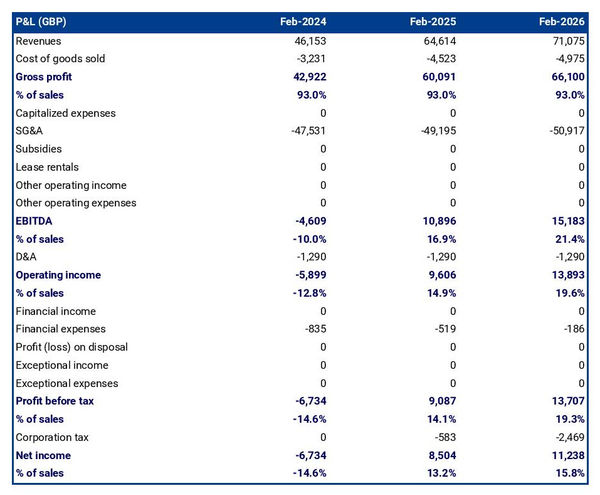
The projected balance sheet of your landscaping company
The balance sheet is a financial statement that provides an overview of a landscaping company’s assets, liabilities, and equity at any given point in time.
- Assets are items that the company owns and can be used to produce income or generate cash.
- Liabilities are obligations owed by the company, such as loans or taxes.
- Equity is the difference between assets and liabilities and is a proxy of the net worth of the owners.
The balance sheet is useful to lenders, investors, and the business owner as it provides a snapshot of the financial structure of the company.
It can help lenders and investors assess the company’s solvency and liquidity, which is important when considering whether to extend credit or invest in the company.
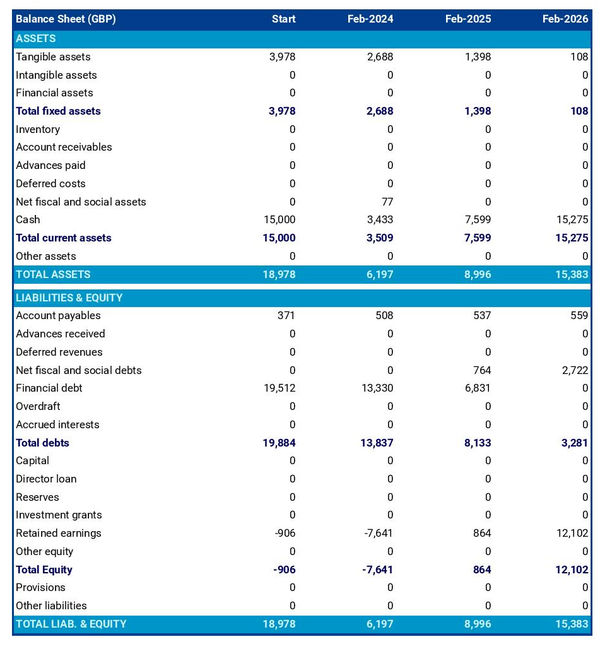
The projected cash flow statement
A cash flow forecast for a landscaping company is a document that shows when cash is expected to come in or out of the business and what it will be used for.
It helps you ensure the company as enough cash on balance sheet to operate and to anticipate potential funding requirements.
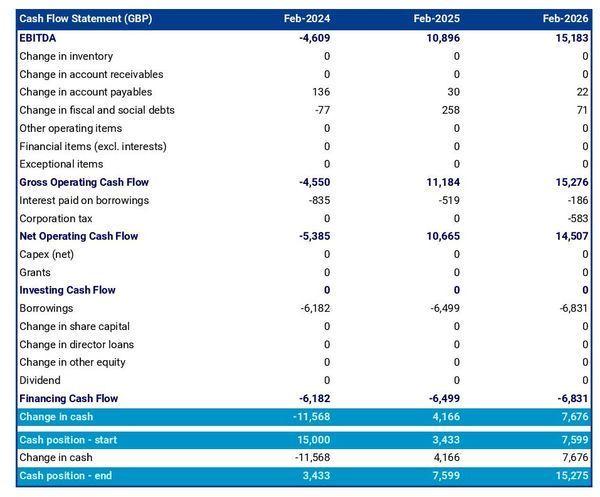
The initial financing plan
An initial financing plan is a table that shows the sources of money and how it will be used when starting a landscaping company.
It helps you see how much money you need to start the business, where it will come from, and what it will be used for.
This can help you make sure that your business has enough of a starting cash position to get started so that you don't run out of funds before the business gets going.

Now that you have an understanding of the financial forecast for your landscaping business, it's important to understand how to properly convey this information in the written part of your business plan.
The written part of a landscaping company plan is composed of 7 main sections:
- The executive summary
- The presentation of the company
- The products and services section
- The market analysis section
- The strategy section
- The operations section
- The financial plan
1. The executive summary
The executive summary of a landscaping business plan should provide an overview of the company, its goals, and the industry it operates in.
It should contain information about the market landscape and key financials, as well as any competitive advantages or unique services the company may have.
It should also provide insight into why investors and customers might be interested in the company's offerings and how the company plans to implement its strategy.
Finally, the executive summary should include a clear statement of what the company is asking for in the business plan.
2. The presentation of the company
When writing the presentation of a landscaping company, there are three main parts you should focus on: structure & ownership, location and the management team.
Structure & ownership is an important part of the presentation as it provides a clear understanding of the legal structure and financial ownership of the company, who are the major stakeholders and how much each of them holds.
Location is also an important part of the presentation as it helps to determine your serviceable area.
Finally, the management team section should include detailed information on key personnel who are responsible for the daily operations of the business such as the managing director or CEO.
3. The products and services section
When writing a business plan for a landscaping company, it is important to include an accurate and thorough description of the products and services offered.
You should provide potential investors or lenders with a clear picture of the scope of work that will be done by the company.
To do this effectively, it is necessary to list each type of service provided in detail as well as any specialized equipment used in those services.
For example, if your company provides lawn care services such as mowing, edging, trimming shrubs, fertilizing, etc., you should list each one individually along with what types of tools or skills are needed for each job.
You should also mention any other related landscaping tasks that may be requested on occasion by customers such as leaf removal or snow ploughing so prospective investors can get an idea of how comprehensive your offerings are.
Additionally, make sure to describe any unique features or specialities that set your business apart from others in the same field.

4. The market analysis
When presenting the conclusions of your market analysis in a landscaping company business plan, you need to include key information about demographics and segmentation, target markets, competition, barriers at entry and regulation.
The demographics and segmentation will provide useful insight into who may be interested in using your services as well as what areas you should focus on marketing-wise.
It can also give you ideas for new products or services to offer clients based on observed trends within certain market segments.
Knowing your target market helps with budgeting since it allows you to more accurately calculate how much money needs to be set aside for advertising and campaigns geared towards customer segments (resorts, homeowners etc.).
Additionally, understanding what type of customers prefer which service or product can help inform decisions when creating new offerings.
Giving an insight into the level of competition in both the local and national markets is also essential because it gives investors a better picture of what already exists in the market. You can then create unique selling points to differentiate your business from them.
Lastly, looking into barriers to entry imposed by local authorities will allow you to identify any potential roadblocks before starting operations which could save time down the line.
5. The strategy section
When writing the strategy section of your landscaping company business plan, you should focus on several key elements to ensure that it appeals to potential investors. These include competitive edge, pricing strategy, marketing plan, milestones and risks and mitigants.
Your competitive edge could include having access to superior technology or experience with a certain type of landscaping project.
The pricing strategy should also be outlined so that potential investors are aware of how much money can potentially be made from each job completed.
In addition, the marketing plan must demonstrate how your company plans to acquire new customers as and retain existing ones.
Milestones also need to be included so that investors can track progress over time and feel confident about investing in the venture.
Finally, any risks associated with starting up or running your landscaping business must be addressed along with possible ways these risks can be minimized or eliminated.
6. The operations section
The operations section of a landscaping company business plan provides key information about the nuts and bolts of how the business will be run.
First, the plan should outline the staffing team and staff members roles within the organization. For example, it should list the titles and responsibilities of staff members, including any independent contractors or subcontractors.
It should also include a recruitment plan that outlines how the company intends to select and train new employees.
You should also indicate the opening hours of the business and key assets needed for operations, such as specialized tools or intellectual property.
In addition, it is important to include information about the suppliers the company plans to work with. Key contacts might include businesses that provide equipment repair (for example, if your chainsaw stops working and you need it fixed quickly).
7. The presentation of the financial plan
This is where you will present the financial forecast that we talked about earlier in this guide.
Now that you have a better understanding of what should be included in the content of your landscaping business plan, it’s time to look at the tools that can help you create one.
There are 3 main solutions to write a landscaping company business plan:
Create your landscaping company plan using Word or Excel
Hire a consultant to write your landscaping company business plan.
- Use an online business plan software for your car landscaping company plan
Creating a business plan for a landscaping company using Microsoft Office programs like Word and Excel is an attractive option given their affordability. But, there are also drawbacks to this approach that should be considered.
One of the main advantages of using Word and Excel to write a landscaping business plan is the cost - both programs are relatively cheap and widely available.
However, creating a financial forecast in Excel can be difficult without expert knowledge in accounting and modelling.
Furthermore, financiers may not trust the accuracy of the plan created in Excel by an inexperienced business owner.
Additionally, it takes longer to create a financial forecast using Excel and updating it as required is also challenging.
Outsourcing a landscaping company plan to a consultant or accountant is an attractive option for many business owners.
On the plus side, consultants are well-versed in writing business plans and both consultants and accountants have a knack for creating accurate financial forecasts.
On the other hand, accountants lack industry expertise to estimate sales accurately and their services cost significantly more than doing it yourself.
Plus, entrepreneurs who outsource a business plan may have less control over the final product compared to writing it themselves.
For example, not all consultants are experts in landscaping company business planning, thus potentially limiting their value.
Ultimately, business owners need to be aware of the pros and cons associated with outsourcing their landscaping company plan before making a decision.
It may cost more but can be worth it if the right consultant or accountant is hired who truly understands the entrepreneur’s goals and objectives.
Use an online business plan software for your landscaping company plan
Another alternative is to use online business plan software. There are several advantages to doing so:
- You are guided through the writing process by detailed instructions and examples for each part of the plan
- You can be inspired by already-written business plan templates and examples
- You can easily make your financial forecast by letting the software take care of the financial calculations for you
- You get a professional document, formatted and ready to be sent to your bank or investors
- You can easily compare your forecast against your accounting data to make sure you are on track to deliver your plan, or make adjustments if needed
If you're interested in using this type of solution, you can try our software for free by signing up here .
We hope that this article has helped you to better understand how to write the business plan for your landscaping company. Do not hesitate to contact us if you still have questions!
Also on The Business Plan Shop
- How investors analyse business plans
- How to do a market analysis for a business plan
- Business plan vs budget: what's the difference?
Know someone in the landscaping industry? Share this article with them!

Founder & CEO at The Business Plan Shop Ltd
Guillaume Le Brouster is a seasoned entrepreneur and financier.
Guillaume has been an entrepreneur for more than a decade and has first-hand experience of starting, running, and growing a successful business.
Prior to being a business owner, Guillaume worked in investment banking and private equity, where he spent most of his time creating complex financial forecasts, writing business plans, and analysing financial statements to make financing and investment decisions.
Guillaume holds a Master's Degree in Finance from ESCP Business School and a Bachelor of Science in Business & Management from Paris Dauphine University.
Create a convincing business plan
Assess the profitability of your business idea and create a persuasive business plan to pitch to investors

500,000+ entrepreneurs have already tried our solution - why not join them?
Not ready to try our on-line tool ? Learn more about our solution here
Need some inspiration for your business plan?
Subscribe to The Business Plan Shop and gain access to our business plan template library.

Need a professional business plan? Discover our solution
Write your business plan with ease!

It's easy to create a professional business plan with The Business Plan Shop
Want to find out more before you try? Learn more about our solution here
Free Landscape Business Plan Template (+PDF Download)
Read Time 6 minutes
Author Stephanie Figy
Published February 21, 2023
Download the Guide
Table of Contents
1. Executive summary
2. company overview, 3. landscaping services, 4. landscaping pricing, 5. market analysis, 6. competitor analysis , 7. marketing plan and sales strategy , 8. management plan, 9. financial plan, set up your landscaping business for success.

A landscape business plan is essential for securing bank loans, managing startup costs, and maintaining cash flow. Even the most seasoned landscape business owner needs a dynamic roadmap to guide operations and inform goal-setting.
Annually reviewing and adjusting your company’s business plan helps you to scale your landscape business strategically.
This article describes what to include in a landscape business plan and provides a free landscape business plan template to get started.
>> Download Aspire’s FREE landscape business plan template.
The executive summary serves as a strategic snapshot of your landscape business plan. It should be compelling to capture the attention of potential partners and lenders.
The executive summary briefly describes the new business, its mission, and its goals. Summarize the most critical aspects of the plan, such as:
Market opportunities
Services offered
Financial projections
If you’re applying for funding, specify the amount , how you intend to use it , and, more importantly, how it will increase your profit margins .
Even though the executive summary comes first in the plan, write it last to identify and highlight the most crucial elements of your plan, ensuring that it presents a well-rounded and compelling case for your landscape business.
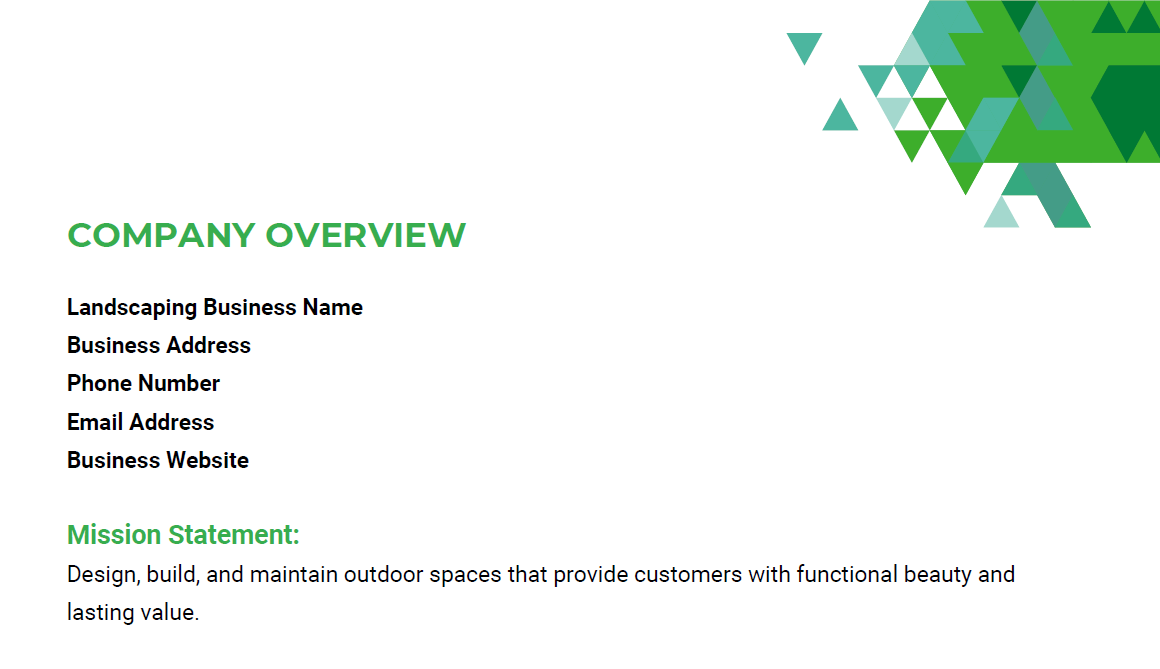
The company overview is where you start to dig into the details of your landscaping or lawn maintenance business. It should include specifics, such as:
Landscaping business name
Business address
Phone number
Email address
Business website
In addition to the nuts and bolts, a company overview is where business owners state their mission statement , vision statement , and core values . This gives the reader a comprehensive understanding of the company’s business identity.
In this section, list your various landscaping services, such as routine lawn care services, landscape design, or mulch installation. For each service type, detail the:
Potential profitability
Scalability
Industry relevance
Strategic importance
List any specialized equipment or certifications that enable you to perform unique services or differentiate you in the marketplace. Also, determine whether you plan to provide these services to homeowners, commercial clients, or both.
Some landscape companies in colder climates pivot to snow removal during the winter. If that’s a part of your business model, include the related services in this section. This demonstrates your capacity to diversify and sustain your business during off-peak seasons, contributing to overall revenue stability and client retention.
Next, outline your pricing strategy, including the pricing model or models your business uses, such as flat-rate , project-based , or hourly pricing. Note that pricing depends on factors like:
Market demand
Competition
You may also list prices from a few competitors to show where your business stands in the marketplace. Include how your pricing strategy positions your business, whether as a cost leader , a premium service provider , or a value-driven option .
Explain if your pricing strategy allows flexibility, such as offering package deals or customizing services based on client preferences. If applicable, discuss strategies to attract and retain clients, such as:
Discount programs
Seasonal promotions
Membership programs
Referral incentives
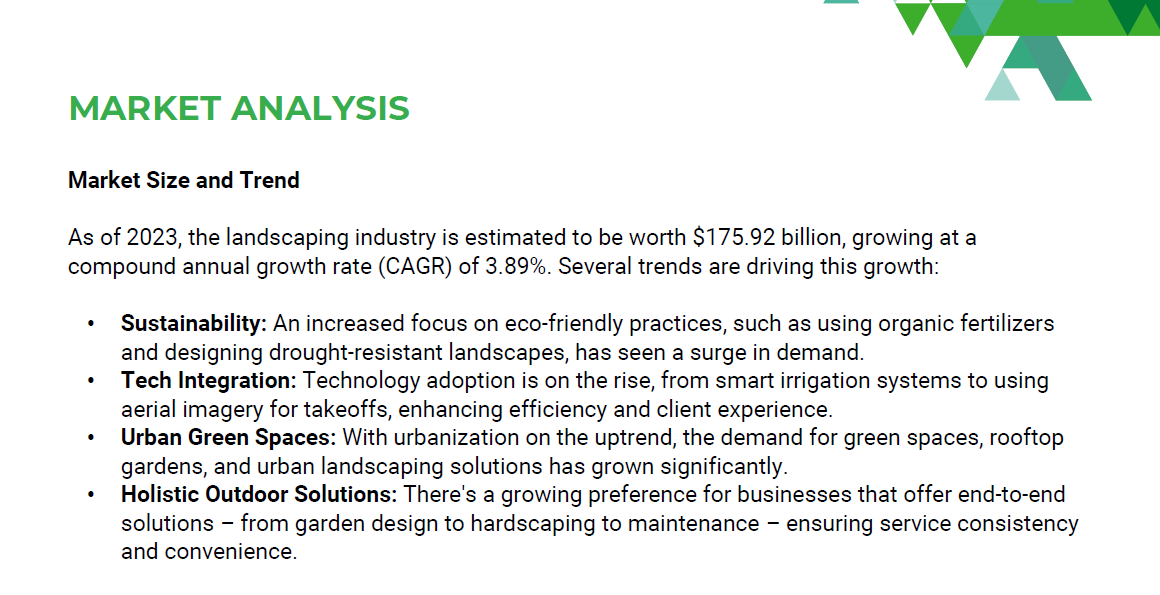
Include a market analysis within your business plan to show potential investors and partners what the landscape industry looks like in your area, such as:
Market size
Growth trends
Opportunities
Identify market gaps, whether certain services are not offered, or areas are not sufficiently served.
Discuss emerging trends and innovations within the landscaping industry. This could encompass:
Eco-friendly practices
Sustainable landscaping
Advancements in technology and equipment
Your awareness of industry trends indicates your readiness to adapt and stay competitive.
In addition, outline your target audience or buyer persona , including demographics and psychographics. If your key target market includes discerning families, this could help determine specific service offerings, such as organic cleaning products and methods.
In the competitor analysis section of your business plan, list the top landscape industry players in your service area and their strengths and weaknesses. Discuss competitive advantages that set the business apart and strategies for outperforming competitors, which may include capitalizing on the weaknesses of your peers.
→ When performing a competitive analysis, due diligence requires consulting market research and industry benchmarks. This guides strategic decision-making .
In addition, detail the marketing and promotional tactics employed by competitors, including their:
Online presence
Social media engagement
Advertising campaigns
Customer acquisition strategies
Explain how your marketing efforts aim to stand out or compete effectively.
You’ve already established your target audience. Now, outline how you plan to reach potential customers and convert them into new customers. List your marketing channels and tactics, like direct mail, email marketing, and social media marketing.
When crafting a marketing strategy , consider each step of the buyer journey and how your company will effectively target customers through those steps, which include:
For your sales strategy, define your approach, such as value-based or consultative selling .
In addition, define your follow-up strategy for unsold estimates–consider what will convert them–and how to utilize customers you’ve serviced to garner reviews and referrals.
Your management plan provides an overview of the company’s business structure and key personnel responsible for executing the business plan. It acts as a roadmap for:
Making staffing decisions
Defining internal processes
Developing leaders
You may start with an organizational chart, which provides an overview of the company hierarchy from the management team on down. Then, go into further detail, listing the roles and responsibilities of each team member.
A company’s recruitment and retention relies on quality management. Discuss strategies for attracting and retaining talent and your plans for talent development and growing your landscape business . This could include mentorship programs , career pathing , and feedback mechanisms .
The financial plan breaks down the numbers side of your landscaping business, outlining the company’s economic viability and the leadership’s financial acumen.
For businesses seeking funding, outline the capital requirements to start the company and how the money will be used. Include personal income statements for each owner and major stockholder, showing assets and liabilities outside the business and personal net worth.
A financial plan should include financial statements, such as:
12-month profit-and-loss projection
Cash flow statement projection
Projected balance sheet
Break-even calculation
Take into account the average profit margins for a landscaping business . Also, list financial risks and mitigation strategies.
→ Your financial plan is a moving target, as you can’t always predict and plan for changing economic landscapes. Regularly r evisiting and updating this section of your business plan is crucial .
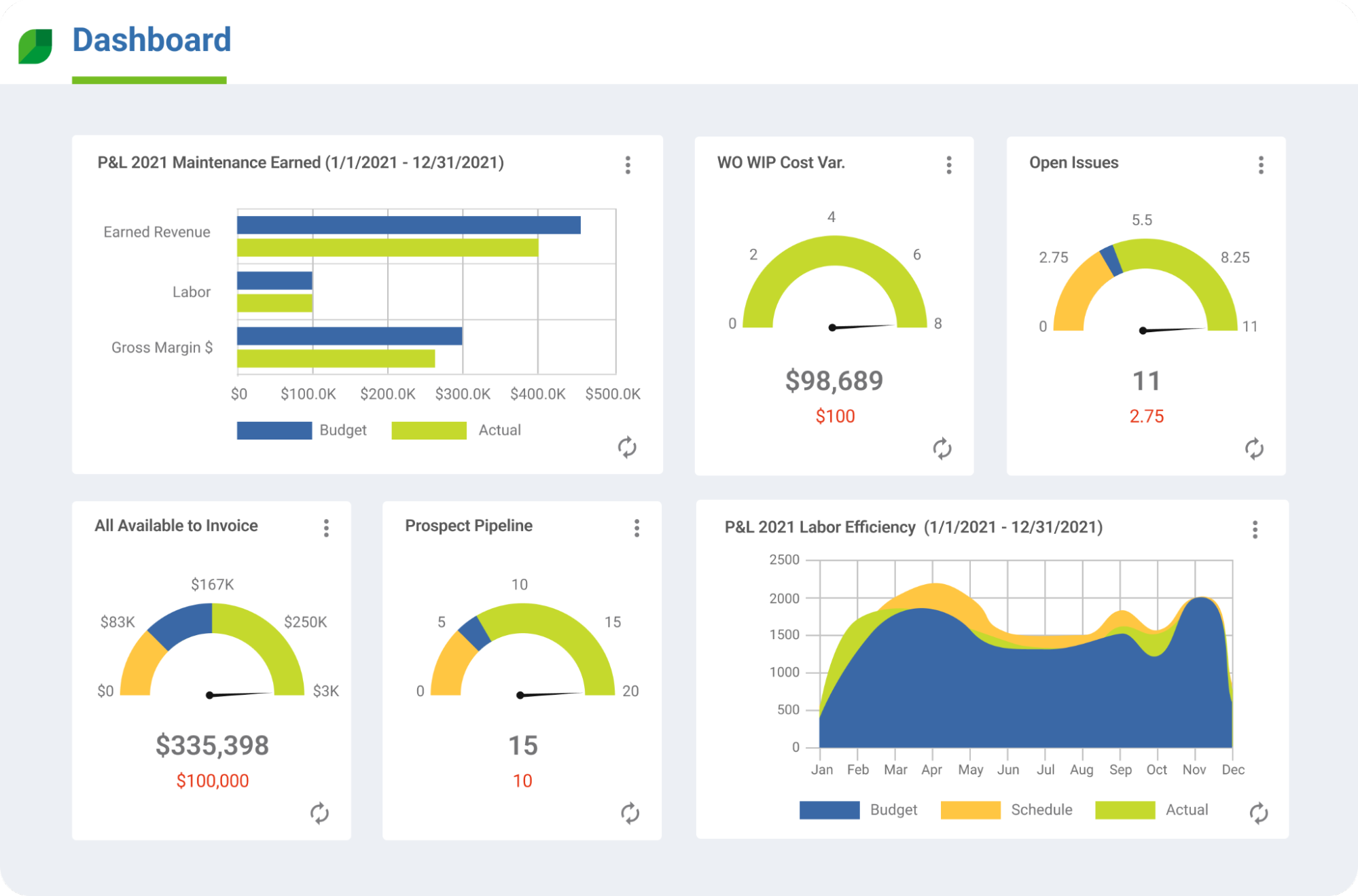
You might use resources to help implement your financial plan, such as landscape business software like Aspire, which provides visibility into every aspect of operations.
With real-time data readily accessible via custom reports and dashboards , and features to accurately and immediately calculate job costs, Aspire helps landscaping businesses make informed decisions to improve:
Productivity
Accountability
A landscape or lawn care business plan helps secure funding, uncover your business differentiators, and guide day-to-day landscape business operations. Check out our sample business plan to get started.
Field service software helps implement the business plan, leading to growth, profitability, and landscape business success .
Aspire ’s end-to-end business management software delivers industry-leading features for:
Job costing
Labor management
Purchasing
For more than a decade, landscape contractors have trusted Aspire’s tools to help them operate profitably and efficiently.
The latest articles from Aspire Software
Practical advice and tools to help you run your field service business.
Commercial cleaning

March 29, 2024 5 min read
Cleaning Subcontractor Agreement Template (+Free PDF Download)
Streamline your cleaning business with a comprehensive subcontractor agreement template, ensuring top-quality service and...

March 29, 2024 8 min read
Cleaning Business Plan Template (+Free PDF Download)
Discover the essential elements of a cleaning business plan and leverage our free cleaning...

March 26, 2024 5 min read
Cleaning Inventory Template (+Free PDF Download)
Optimize your inventory management with a free template that allows you to track and...

March 6, 2024 5 min read
Cleaning Estimate Template (+Free PDF Download)
Download our free cleaning estimate template to streamline your estimating process and ensure accurate...

February 28, 2024 8 min read
Landscaping Equipment List: Top 21 Essential Tools (Hand Picked)
Explore our curated list of key landscaping tools and equipment, from hand tools and...

January 17, 2024 5 min read
Cleaning Work Order Template (+Free PDF Download)
Download this free template to automate your cleaning work order process and improve workflow...

December 13, 2023 8 min read
Landscaping Equipment Maintenance Checklist Template (+Free PDF Download)
Keep your landscaping equipment in top condition with our free downloadable landscaping equipment maintenance...

December 13, 2023 5 min read
Cleaning Invoice Template (+Free PDF Download)
Get this free cleaning invoice template and improve monthly cash flow with professional-looking, accurate...

December 11, 2023 5 min read
Landscaping Appointment Reminder Template (+ Free PDF Download)
Nothing is more frustrating than a property owner who doesn’t attend the scheduled appointment.

December 6, 2023 5 min read
Landscaping Subcontractor Agreement Template (+Free PDF Download)
Using subcontractors helps landscaping companies to scale, overcome labor shortages, and meet demand during...

November 11, 2023 6 min read
Free Cleaning Proposal Template (+PDF Download)
The profitability of a commercial cleaning business relies on the precision and detail of...
Quality Control

November 3, 2023 4 min read
Commercial Cleaning Checklist Template (+Free PDF Download)
Commercial cleaning contractors who deliver consistent high-quality service improve client satisfaction, grow their client... boost business growth .
Subscribe to Aspire news & insights
- Crew Control
- PropertyIntel
- Landscaping
- Job Costing
- Accounting & Payroll
- Implementation
- Events & Webinar
- Case Studies
- Comparisons
- Partner Marketplace
- Integrations
©2024 Aspire Software. All rights reserved.
Landscaping Business Plans
Construction irrigation business plan.
Hass Irrigation Systems is a subcontractor providing home and yard irrigation systems for residentail new home construction.
Lawn Landscaping Business Plan
Greens Manicure Service is a start-up company providing residential lawn-care services.
Wholesale Landscape Products Business Plan
Glen Mar Forest Products will use forest wood by-products to manufacture and wholesale a color enhanced mulch/landscape ground cover.
Landscape Design and Maintenance Business Plan
Emerald Outdoor Design is a full-service landscape design and implementation firm with the goal to bring beauty to your home that adds to serenity in your life.
If you’re ready to take your landscaping knowledge and turn it into a business, you need a plan. Before you start writing a business plan for your business, though, take a look at a few sample business plans for nurseries, landscaping, and lawn and garden businesses.

The quickest way to turn a business idea into a business plan
Fill-in-the-blanks and automatic financials make it easy.
No thanks, I prefer writing 40-page documents.

Discover the world’s #1 plan building software
- svg]:stroke-primary"> 826K
- svg]:stroke-primary"> 622K
- svg]:stroke-primary"> 246K
- svg]:stroke-primary"> 45K
How to Start a Lawn Care Business: A Step-by-Step Guide for Budding Entrepreneurs
By Amber Guetebier
Posted on Mar 19, 2024 9:56 PM EDT
10 minute read
Photo: istock.com
We may earn revenue from the products available on this page and participate in affiliate programs. Learn More ›
When it comes to types of businesses an entrepreneur can start, opting for a lawn care business can be full of benefits. Overall, lawn care business start-up costs are relatively low and the industry has the potential for high revenue; some lawn care businesses can bring in six figures annually. Add to that the perks of independence and spending time outdoors, and starting a lawn care business becomes even more appealing. To offer customers individualized, reliable lawn care, the best lawn care services start with a comprehensive, executable lawn care business plan. Those interested in starting a lawn care business will find the steps listed can help them on their path to a flourishing lawn care business.
Before You Begin…
When entrepreneurs are researching how to start a lawn care business, there are a number of key factors to take into consideration. Before launching a new venture, aspiring business owners will want to consider any existing lawn care businesses in their marketplace, what those businesses have done to be a success, and how a new lawn care business can compete.
In many locations, lawn care isn’t a year-round business, so taking the weather and climate into consideration will help an entrepreneur formulate the right plan. Many lawn care businesses offer winter snow or ice removal in areas with heavy snowfall. Those with milder winters may be able to work nearly year-round if they plan to offer lawn care preparation and seasonal cleanup as part of their services.
Tips for Starting a Lawn Care Business
- Create a well-researched business plan and set a budget.
- Decide on a business structure, such as sole proprietorship or limited liability company (LLC).
- Research required licenses and permits, such as those required for pesticide application.
- Invest in necessary equipment and software.
- Create a targeted marketing plan to create brand awareness and reach a wider client base.
- Recruit and hire employees to help the lawn care business scale.
STEP 1: Write a comprehensive lawn care business plan.
Writing a business plan is a logical first step for any entrepreneur, and it’s no different for a lawn care business. In order to create a robust, actionable business plan for lawn care companies, the owner needs to start off with market research and make decisions about the scope of the lawn care business they want to run. Many lawn care companies begin as a small lawn care business but may scale into a larger operation, so thinking about company structure is important. For example, will this be an LLC or a sole proprietorship? Is the goal to be a solo operation or to eventually become a franchise? A strong lawn care business plan includes a list of the equipment and tools the owner will need from the start, the start-up and operational budget for the business, and a marketing plan that includes outreach to let new customers know that the business is up and running.
STEP 2: Choose a business structure and register your business name.
There are several different structures an entrepreneur can choose for their business, including a sole proprietorship, a partnership, a corporation, an S corporation, or a limited liability company (LLC). For each of these structures, there are different requirements to register with the state or local government. Business structure affects taxes, paperwork requirements, personal liability, and where potential funding comes from. Aspiring entrepreneurs will want to consider their lawn care business structure carefully, as choosing to restructure in the future may come with restrictions and complications. The U.S. Small Business Administration (SBA) website offers business owners information to help them determine which structure is best for their company. Entrepreneurs can also choose to work with a professional to register their business; for example, they may choose to work with one of the best LLC services , such as LegalZoom or Northwest Registered Agent , to register their business as an LLC.
STEP 3: Get the necessary business licenses and permits as required by your state or local government.
Business owners typically need to register their lawn care business name with state and local governments. They’ll also want to consider the adjacent states where the company may conduct business and research whether the business needs to be registered there as well. Generally, if the company is an LLC, corporation, or partnership, the business owner may be required to register in any state where the company will regularly conduct business. Business names do not need to be registered on a federal level, but paying taxes to both state and federal tax agencies is a requirement.
In addition, the business owner will likely need to get a business license , though the specifics will depend on their location. There are a number of different types of business licenses , and new lawn care business owners will want to research what licenses are required in their area. For example, some states may only require a general business license for lawn care companies to operate legally. Others, however, may require lawn care businesses to obtain special pesticide application certification or permits.
STEP 4: Obtain business insurance coverage.
Lawn care companies frequently work with equipment such as riding lawn mowers or rototillers on clients’ property. They may work on drainage and irrigation as well as lawn care and maintenance. Because of this, purchasing the best insurance for lawn care businesses (such as a policy from NEXT Insurance or Thimble ) is a critical investment for any lawn care business. In many cases, a certain amount of insurance coverage is required by law in order for a business to acquire a license and operate legally in the state in which it’s located.
The good news is, the cost of lawn care business insurance is relatively affordable, with the national average at about $45 a month. Having lawn care business insurance can help protect the company in the event of an accident, damage to a client’s property, injuries to a client, and in some cases, stolen or damaged equipment.
STEP 5: Get financing and open a business bank account.
The national average lawn care business start-up cost is $6,900, which includes a business license, taxes, insurance, equipment, and operating supplies. This amount can fluctuate depending on location, existing equipment, and other factors such as number of employees and vehicles. Commercial lawn care companies may need to invest in larger and more powerful equipment, such as one or more of the best riding lawn mowers , rather than basic push mowers, and this can be a larger investment up front. Creating and finalizing a budget, possibly with the help of an accountant, will help a business owner see the profit they need to succeed and help secure the right amount of financing. It’s also essential to have a business bank account to help manage income and outgoing expenses.
STEP 6: Invest in software to help run and organize the business.
With so many moving parts involved in starting a lawn care business, investing in accounting or other business management software can provide a new business owner with the support they need to manage the daily operations of a lawn care business, including scheduling, invoicing, and budget tracking. The best lawn care scheduling software programs (such as Jobber ) can help address the specific needs associated with operating a lawn care business.
STEP 7: Purchase quality lawn care tools and equipment.
Starting a lawn care business requires a business owner to invest in certain types of equipment, not the least of which is a lawn mower. Purchasing the best lawn mowers will help any new lawn care business operate successfully. If the lawn care company will operate as a commercial business, with clients that could include golf courses, sports stadiums, or parks, the owner may want to consider larger mowing equipment such as a zero-turn or tractor-style riding lawn mower . Riding lawn mowers are a greater initial investment, but they enable the lawn care business to serve more clients in less time. Entrepreneurs will want to keep in mind that some equipment, such as rototillers or skid-steer loaders, can be rented on an as-needed basis until the business grows.
“Investing in quality equipment and tools will allow you to apply [lawn care products] faster and more efficiently while putting less wear and tear on your body,” says Mark Marino, owner of Lawn Phix , a lawn care company based in Bellingham, Massachusetts. “I now primarily use a ride-on spreader/sprayer with a walk-behind fertilizer spreader and two battery backpack sprayers (one for herbicides and one for liquid nutrition). This setup has instantly doubled the number of properties I complete daily…compared to [using] the push spreader and battery backpack sprayer alone. Plus, I’m less tired at the end of the day, and it’s a lot of fun to ride around, too.”
STEP 8: Invest in top-quality lawn care products.
In addition to having quality tools, a new lawn care business will need to have a selection of quality lawn care products, such as fertilizer, weed control, and pest control products. Lawn care businesses can keep these types of products on hand to make it easier to maintain and beautify clients’ yards.
There are several factors for aspiring lawn care business owners to keep in mind while researching the best lawn care products for their company. First, they’ll want to consider safety. There is a lot of value in choosing a company that offers environmentally friendly products, and doing so could give a lawn care company an edge against the competition if other companies in the area aren’t using eco-friendly products. Second, they’ll want to think about the reputation of the company providing the lawn care products they’re considering. Entrepreneurs can research the different brands available, asking local companies what products they recommend and reading reviews on the effectiveness of each type of product.
Lawn care products are a critical component of any lawn care business, so it’s vital that an entrepreneur include them in their budget and shop around to find the best products for their money.
STEP 9: Choose and price the services your lawn care business will offer.
It’s common for many lawn care companies to offer up-front pricing on their website and on flyers or advertisements. By researching the lawn care cost in the area in which the lawn care business will operate, new lawn care companies can remain competitive in their local market. The national average cost for lawn care services is $124, with a range between $48 and $206. Pricing can be dependent on many factors including geographic location, frequency of service, lawn size, and any additional services the lawn care business will offer, such as pesticide application, additional landscaping services, or seasonal cleanups. In areas with heavy snowfall, many lawn care businesses pivot to offer snow removal and holiday lights installation.
STEP 10: Create a marketing plan to build a solid client base.
A marketing plan is an integral part of cultivating and maintaining a client base. Marketing includes everything from lawn care business cards to a dynamic website. It also includes targeted advertising, such as flyers and door hangers, in neighborhoods businesses wish to serve. The use of social media outreach is also important to build brand identity and interact with customers.
Another way for a lawn care business owner to get more clients is to tap into their existing customer base. “Something that’s worked really well for us is simple word-of-mouth advertising,” says Jeremy Yamaguchi, founder of Lawn Love . “We’ve gathered tons of new customers simply through being recommended by satisfied customers. We make it a habit to always ask our satisfied customers to recommend us after completing a job for them, and we also run lots of promotions where we will offer discounts to people who recommend and get others to do business with us. Lawn care is one of those services that is inherently personable and connection-focused, which is why this has always been an effective approach for us.”
Additionally, entrepreneurs will want to consider purchasing vehicle wraps or magnets with their business name, logo, and contact information and place them on their business vehicles. This helps the business become more visible in the community, which can attract more customers. Finally, business owners can ask their current customers if they can place a yard sign with their business info on the customer’s property—this way, passersby can see the business’s contact information while also admiring their handiwork.
STEP 11: Hire employees to help you run your lawn care business.
While a small lawn care business may start out with a single owner and operator, the workload will grow alongside the client base. In order to effectively scale a business, many lawn care companies will reach a point at which they will need to hire employees. Investigating the average wage and benefits will be a big step in the process for the business owner. Offering employees a fair wage and good benefits will help with employee retention, and it can help ensure trust and loyalty between employer and employee.
“I have seen wages increase steadily over the past 10 years. For instance, an inexperienced crew member started at about $11 per hour in 2014 compared to $18 per hour today,” says Jennifer Nichols, president of GreenWeaver Landscapes in Lenni, Pennsylvania. “Along with wage increases, benefits have grown over the years, and we now offer health and dental insurance, a retirement plan, and liberal vacation and education benefits for all new hires…Landscaping is a skilled profession and our employees deserve a living wage, just like all the other trades. I believe the public is beginning to understand and accept this. This simply means that wages will most likely continue to increase in the near future, and they should.”
When learning the ins and outs of how to start a lawn care business, from writing an initial business plan and securing funding to marketing and hiring employees, entrepreneurs can create a thriving business that helps beautify the neighborhood while earning a living wage. By dedicating the time up front to create a well-researched business plan, the grass really will grow greener.
Anker’s New Home Battery Tower Is a Sleek, Modular Step Toward Complete Energy Independence Anker’s New Home Battery Tower Is a Sleek, Modular Step Toward Complete Energy Independence
By: Chase Brush
The 20 Best Lawn Care Products for a Lush and Healthy Lawn The 20 Best Lawn Care Products for a Lush and Healthy Lawn
By: Deirdre Mundorf
How to prepare a lawn care business plan

If you consider yourself an expert on lawn care, starting a business only seems natural. However, creating a successful lawn care business involves more than just skill. You’ll have to consider equipment, licenses, and insurance, among other things. While entering the lawn care industry is not as easy as you might think, a bit of careful planning and execution will give you the best chances of success.
Coming up with a lawn care business plan can help you prepare for the future and tap into thousands of potential customers. You’ll learn all about how to write a lawn service business plan and why it matters.
- What you’ll learn in this guide
Before jumping into the planning process, here’s a closer look at what you’ll learn in this article.
Table of Contents
Why do you need a lawn care business plan, pros of starting a lawn business, traditional vs. modern business plans, how a lawn care business plan sets you up for success, executive summary, business overview, lawn care services, market analysis, business strategy, marketing and sales, personnel plan, financial plan, how do you create a lawn care business plan, how much is insurance for a landscaping business, how much do landscaping businesses make every year, is starting a landscaping business worth it, how do you get lawn care customers, final thoughts on lawn care business plans.
A comprehensive plan is necessary for all lawn care business owners. Not only does it help you stay organized, but it also allows you to set your goals, maintain focus, and pinpoint areas of improvement.
A good plan outlines how you think about your work’s financial, sales, marketing, and technical aspects and how you can use them to succeed. They are also helpful for getting a better grasp of competitors and identifying unique opportunities to get ahead – remember, work within the landscaping industry is often seasonal, so being on top of your game is crucial.
Many people need their lawns mowed and gardens fertilized, so you can rest assured that starting a lawn care company is profitable! Plus, you’ll get to enjoy these benefits.
- Many service opportunities: Unlike other businesses with clearly defined responsibilities, the options with a lawn care service business are vast. For instance, you can work primarily in residential areas or expand your services into commercial spaces. Not to mention, you can work with all kinds of customers.
- Flexible costing: Being your own boss means you get to price your services accordingly. By considering your existing costs, equipment, the average time you spend on a project, and other factors, you can come up with numbers that make sense.
- Choosing your own clients: Customizing your client list means working with dependable customers during good working hours and in areas not too far from your headquarters. You can also prioritize higher-paying or return customers for more stable income.
Traditional business plans are lengthier, more detailed, and present more concrete, plausible outcomes than the structures you see today. On the other hand, modern plans are more flexible and focus more on creating a vision than making a detailed financial model.
While traditional plans include a detailed executive summary about the business involved, modern start-up plans offer a value proposition instead, outlining how to gain a competitive advantage in your target market. Start-up plans also require developing growth rates and revenue models from the ground up, especially if the business in question lacks historical data.
What type of business model best suits your lawn care company will depend on your goals and the most critical aspects of your potential growth.

Now that you know having a lawn care business plan is necessary, it’s time to take a closer look at the benefits you can gain from having one.
- Stable work: Depending on your geographical location, coming across yard work can be challenging. Fortunately, business plans can help you develop alternative ways to profit even with low demand for your particular service.
- Custom solutions: Business plans are easy to customize to your specific needs. You can alter your plan to suit goals like introducing new services, opening a new location, or providing options for commercial customers.
- Seasonal employees: Maintaining a regular workforce can quickly become time-consuming and expensive. The good news is, your business plan can cater to employees with seasonal professions like snow removal.
- Flexible goals: Not sure where you want your business to go? Use your business plan to scale your goals accordingly.
Key elements of a lawn care business plan
A complete lawn care business plan includes the following sections.
Your cover page should clearly state your company name and include your logo. You should also include your company role, business address, and other contact information.
As the title suggests, executive summaries should summarize your entire plan in a few short paragraphs. In it, you should include your mission and vision, business goals, factors that set you apart, and a brief company history. It is best to write your executive summary last when you have a complete understanding of what the entire document includes.
Your business overview is a look into all the aspects of your lawn care and landscape company. These include:
- Ownership type: Determine whether your business is a sole proprietorship, partnership, corporation, or other structure. Doing this will help you adhere to government regulations such as tax implications.
- Assets: List out the equipment you already have, such as a lawn mower, a fleet, additional tools, or laptops, and list the assets you’ll need in the future. Include how much money you have already invested in your business.
- Start-up costs: Create an overview of what you spent to launch your business. Include items like the cost of office supplies, employee compensation (if any), rent, marketing materials, etc.
Provide a list of the services you want to offer according to your existing assets and current budget. Common lawn care services include:
- Lawn mowing.
- Pest control application.
- Lawn fertilization application or weed control.
- Tree and plant services.
- Aeration or dethatching.
- Grass and leaf blowing.
- Landscape design.
- Tree trimming.
What you can offer will ultimately depend on your existing equipment, your competition, and what your customers need.
Creating a market analysis is similar to crafting a buyer persona. In this section, you’ll want to define your target market, what solutions they need, and how you fit into the equation. When taking a closer look at your target market, list their characteristics such as:
- Income level and occupation.
- Geographical location.
- Size of property.
Then, include an analysis of your top competitors. Consider factors like:
- What services they offer.
- Who they cater to.
- What they charge for their services.
- What competitive advantages and disadvantages do they have.
This section of your business plan is where everything comes together. Think of it as a road map to success that outlines your:
- Financial objectives: Create financial goals that take into account your projected profits and investors.
- Pricing: You can’t expect to profit just by pricing your services high. You’ll have to consider your hourly rate, how much you’re paying your employees, overhead for equipment, taxes, and additional fees. You may need to consider pricing your services lower for your first few customers. Use this pricing formula to get started.
Operational objectives: Create short and long-term objectives that break down your mission and vision into actionable goals. For instance, if you want to increase brand loyalty, your goals might be to engage clients or improve customer service channels.

This part of your business plan should outline how you intend to market and sell your products and services. Ultimately, it should provide a summary of your:
- Marketing strategies .
- Pricing plans.
- Competitive advantage.
- Sales strategies.
You can also use this information to ensure you’re not spending more than you can afford. Once you’ve determined your financial goals, you can identify how many potential customers you’ll need to meet them.
Not sure where to start? Try these lawn care marketing ideas .
As your company grows, so will your need for more employees. In most cases, labor costs take anywhere between 30-35% of your revenue. To keep these costs down, you’ll need a strategy for improving productivity, efficiency, and communication.
Before you start hiring more employees, you’ll want to consider:
- How much you should pay yourself and your employees.
- How many employees you need to achieve your business goals.
- How much work load can one employee handle per day.
This stage of your business plan is where investing in lawn care software might come in handy. These programs can automate repetitive administrative tasks and keep everyone on your team accountable. This allows you and your admin team to focus on adding value to the business instead of doing menial, repetitive tasks.
If maintaining regular employees ends up costing your business too much, you might want to enlist contracting services instead. Working with specialists on a contract basis can reduce your overall costs, as you’ll pay for labor only when you need it.
Finally, it’s time to think about how you will bring revenue into your business. Especially if you are applying for a lawn care business grant, you’ll want to make this section as detailed as possible. Your financial plan should outline:
- Financial statements (and an analysis of them).
- Sales forecasts.
- Personnel costs.
- Overall budget.
- Cash flow projections (incoming and outgoing costs).
Lawn care business plan FAQs
Starting a lawn care and landscape company from the ground up is no easy feat. Having a lawn mowing business plan in place can make the process far more manageable. You can create one by following these steps:
- Decide what kind of lawn care and landscape company you want to run. Knowing what kind of services you want to offer can help narrow your customer base and influence the rest of your decision-making processes.
- Study your target market and direct competition. Consider whether you have potential clients in your area or if other services might suit them better. Be realistic about how many prospective clients you can serve per month. Then, create a competitor analysis and think about your competitive edge – what can you offer that they can’t? Where can you get ahead of the game?
- Think about how much work you can do in a day and how much you’ll charge for it. If you’re going into the landscaping industry as a sole proprietor, you may have to invest in legal and accounting services. If you’re not quite ready to hire regular employees, you can work with specialists on a contractual basis.
- Consider your potential income and expenses. Create best and worst-case scenarios for each month and what you’ll need to do to break even on your costs. Consider factors like business insurance, tax deposits, maintenance and storage fees, and accounting.
How much you pay for business insurance will depend on the services you offer and the risks involved. For general liability insurance, which covers property damage and employee injuries, you can expect to pay an average of $45 per month. However, you may need to purchase more insurance depending on how you operate your business.
Some policies only cover claims on a per-occurrence limit, restricting coverage to only one incident. If your business is growing, you may have to expand policy limits.
Furthermore, you’ll also have to get commercial auto insurance, which costs lawn care and landscaping companies an average of $150 per month. If you employ company-owned vehicles, this type of insurance is necessary. Otherwise, you can purchase hired and non-owned auto insurance for rented vehicles.
How much your lawn care and landscaping company can earn each year will depend on what type of services you offer and how broad your customer base is. According to the Bureau of Labor Statistics , average landscapers’ salaries can range between $33,000 – 73,000. However, top performers can expect to earn up to $97,910 a year.
Whether or not starting a lawn care and landscaping company is worth it will rely on the pros outweighing the cons. For instance, if you’re operating out of an area that requires lawn care services year-round, starting a business might seem logical. However, some contractual landscapers choose not to start a business because of the seasonal nature of lawn care and the economic risks involved. However, creating a lawn care and landscaping company also comes with high earning potential. It all depends on how much work you’re willing to put into your business and how prepared you are.
There are many effective channels for generating potential lawn care leads. Some of the best ways to obtain potential clients fast are through:
- Paid advertising.
- Social media marketing.
- Referral systems.
- Subcontracting.
- Collaborating with key industry players.
- User-generated content and testimonials.
- Investing in organic search.
- Word-of-mouth.
If this is your first time looking for customers, don’t hesitate to ask your family and friends – they might even promote your business to other people who need your services. We’ve also put together some lawn care ad ideas to help you get started.

Starting a lawn care and landscaping company takes a lot of work. However, crafting a detailed lawn care business plan can help you get ahead of your competitors and stand out as an industry leader. Using these tips, you can worry less about how much starting a business will cost you and focus more on high-earning business tactics that will make your hard work pay off!
Take your lawn care business plan to new heights with Method:Field Services !
Image credit: Alvaro Reyes via Unsplash
About The Author
Sarah Iranca
Related posts.
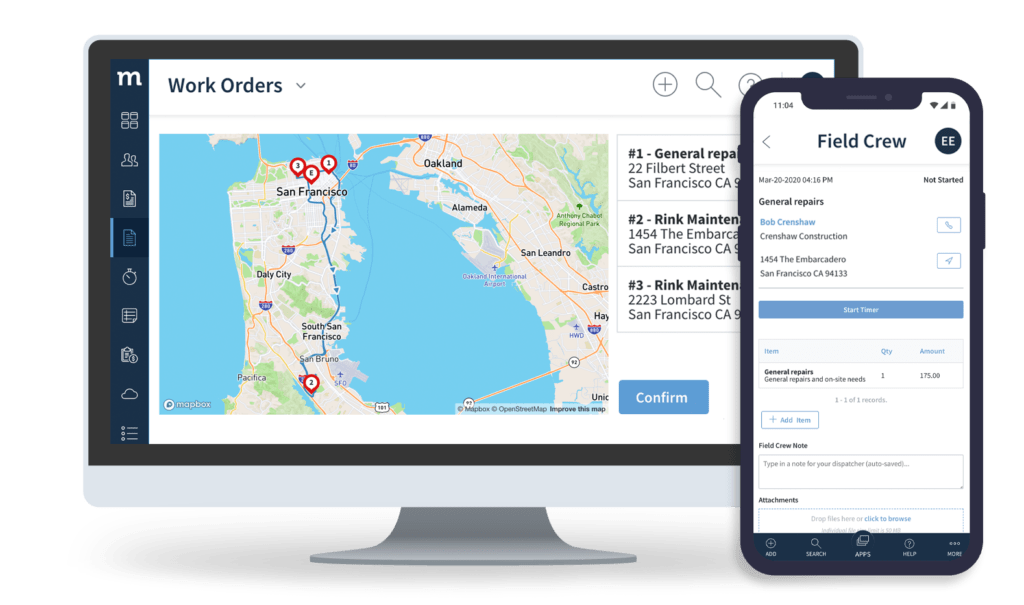
New Method:Field Services features are live
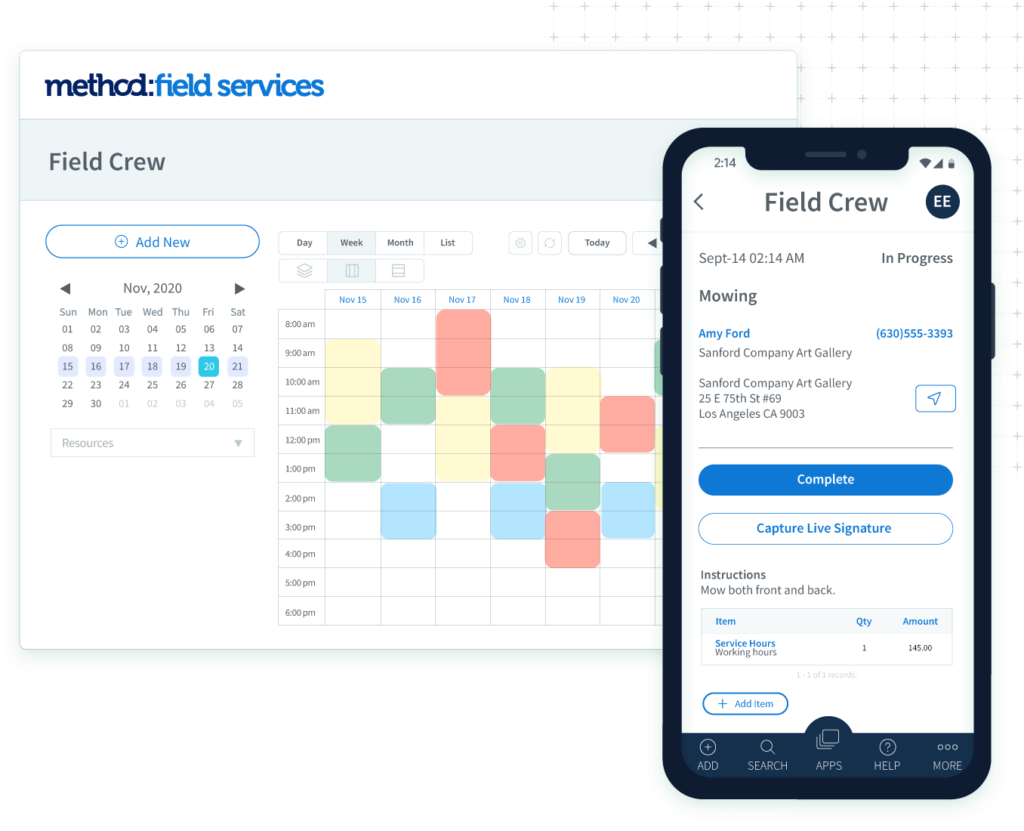
5 features that make Method:Field Services a must-have solution
Streamline your business with method.
Start your free trial — no credit card, no contract.
Landscaping Business Plan Template & Guidebook
Starting a landscaping business can be a great way to break into the green industry, but it can also be overwhelming. Without a clear plan and the right guidance, it's hard to know where to start. Thankfully, there's now an easy-to-use template and guidebook designed to make crafting your business plan a breeze. Introducing The #1 Landscaping Business Plan Template & Guidebook—the essential package for anyone launching or wanting to grow an established landscaping business.

Get worry-free services and support to launch your business starting at $0 plus state fees.
- How to Start a Profitable Landscaping Business [11 Steps]
- 10+ Best & Profitable Landscaping Business Ideas [2023]
- 25 Catchy Landscaping Business Names:
- List of the Best Marketing Ideas For Your Landscaping Service:
How to Write a Landscaping Business Plan in 7 Steps:
1. describe the purpose of your landscaping business..
The first step to writing your business plan is to describe the purpose of your landscaping business. This includes describing why you are starting this type of business, and what problems it will solve for customers. This is a quick way to get your mind thinking about the customers’ problems. It also helps you identify what makes your business different from others in its industry.
It also helps to include a vision statement so that readers can understand what type of company you want to build.
Here is an example of a purpose mission statement for a landscaping business:
Our mission at ABC Landscaping is to create a beautiful and healthy outdoor environment for our clients that is both functional and affordable. We strive to provide excellent customer service and the highest quality of innovative landscaping design solutions to ensure that our clients' landscapes exceed their expectations.

2. Products & Services Offered by Your Landscaping Business.
The next step is to outline your products and services for your landscaping business.
When you think about the products and services that you offer, it's helpful to ask yourself the following questions:
- What is my business?
- What are the products and/or services that I offer?
- Why am I offering these particular products and/or services?
- How do I differentiate myself from competitors with similar offerings?
- How will I market my products and services?
You may want to do a comparison of your business plan against those of other competitors in the area, or even with online reviews. This way, you can find out what people like about them and what they don’t like, so that you can either improve upon their offerings or avoid doing so altogether.

3. Build a Creative Marketing Stratgey.
If you don't have a marketing plan for your landscaping business, it's time to write one. Your marketing plan should be part of your business plan and be a roadmap to your goals.
A good marketing plan for your landscaping business includes the following elements:
Target market
- Who is your target market?
- What do these customers have in common?
- How many of them are there?
- How can you best reach them with your message or product?
Customer base
- Who are your current customers?
- Where did they come from (i.e., referrals)?
- How can their experience with your landscaping business help make them repeat customers, consumers, visitors, subscribers, or advocates for other people in their network or industry who might also benefit from using this service, product, or brand?
Product or service description
- How does it work, what features does it have, and what are its benefits?
- Can anyone use this product or service regardless of age or gender?
- Can anyone visually see themselves using this product or service?
- How will they feel when they do so? If so, how long will the feeling last after purchasing (or trying) the product/service for the first time?
Competitive analysis
- Which companies are competing with yours today (and why)?
- Which ones may enter into competition with yours tomorrow if they find out about it now through word-of-mouth advertising; social media networks; friends' recommendations; etc.)
- What specific advantages does each competitor offer over yours currently?
Marketing channels
- Which marketing channel do you intend to leverage to attract new customers?
- What is your estimated marketing budget needed?
- What is the projected cost to acquire a new customer?
- How many of your customers do you instead will return?
Form an LLC in your state!

4. Write Your Operational Plan.
Next, you'll need to build your operational plan. This section describes the type of business you'll be running, and includes the steps involved in your operations.
In it, you should list:
- The equipment and facilities needed
- Who will be involved in the business (employees, contractors)
- Financial requirements for each step
- Milestones & KPIs
- Location of your business
- Zoning & permits required for the business

What equipment, supplies, or permits are needed to run a landscaping business?
In order to run a landscaping business, you’ll need a variety of supplies and equipment, as well as permits from local and state governments.
- Tools: shovels, hand tools, power tools, rakes, hoes, machetes, lawn mowers, edgers, trimmers, blowers
- Supplies: Fertilizer, Weed Killers/pre-emergent herbicides, mulch/stone/decorative materials
- Transportation: Pick-up truck and or trailer
- Permits: Business license from your local government and certifications from the state if applicable
5. Management & Organization of Your Landscaping Business.
The second part of your landscaping business plan is to develop a management and organization section.
This section will cover all of the following:
- How many employees you need in order to run your landscaping business. This should include the roles they will play (for example, one person may be responsible for managing administrative duties while another might be in charge of customer service).
- The structure of your management team. The higher-ups like yourself should be able to delegate tasks through lower-level managers who are directly responsible for their given department (inventory and sales, etc.).
- How you’re going to make sure that everyone on board is doing their job well. You’ll want check-ins with employees regularly so they have time to ask questions or voice concerns if needed; this also gives you time to offer support where necessary while staying informed on how things are going within individual departments too!
6. Landscaping Business Startup Expenses & Captial Needed.
This section should be broken down by month and year. If you are still in the planning stage of your business, it may be helpful to estimate how much money will be needed each month until you reach profitability.
Typically, expenses for your business can be broken into a few basic categories:
Startup Costs
Startup costs are typically the first expenses you will incur when beginning an enterprise. These include legal fees, accounting expenses, and other costs associated with getting your business off the ground. The amount of money needed to start a landscaping business varies based on many different variables, but below are a few different types of startup costs for a landscaping business.
Running & Operating Costs
Running costs refer to ongoing expenses related directly with operating your business over time like electricity bills or salaries paid out each month. These types of expenses will vary greatly depending on multiple variables such as location, team size, utility costs, etc.
Marketing & Sales Expenses
You should include any costs associated with marketing and sales, such as advertising and promotions, website design or maintenance. Also, consider any additional expenses that may be incurred if you decide to launch a new product or service line. For example, if your landscaping business has an existing website that needs an upgrade in order to sell more products or services, then this should be listed here.
7. Financial Plan & Projections
A financial plan is an important part of any business plan, as it outlines how the business will generate revenue and profit, and how it will use that profit to grow and sustain itself. To devise a financial plan for your landscaping business, you will need to consider a number of factors, including your start-up costs, operating costs, projected revenue, and expenses.
Here are some steps you can follow to devise a financial plan for your landscaping business plan:
- Determine your start-up costs: This will include the cost of purchasing or leasing the space where you will operate your business, as well as the cost of buying or leasing any equipment or supplies that you need to start the business.
- Estimate your operating costs: Operating costs will include utilities, such as electricity, gas, and water, as well as labor costs for employees, if any, and the cost of purchasing any materials or supplies that you will need to run your business.
- Project your revenue: To project your revenue, you will need to consider the number of customers you expect to have and the average amount they will spend on each visit. You can use this information to estimate how much money you will make from selling your products or services.
- Estimate your expenses: In addition to your operating costs, you will need to consider other expenses, such as insurance, marketing, and maintenance. You will also need to set aside money for taxes and other fees.
- Create a budget: Once you have estimated your start-up costs, operating costs, revenue, and expenses, you can use this information to create a budget for your business. This will help you to see how much money you will need to start the business, and how much profit you can expect to make.
- Develop a plan for using your profit: Finally, you will need to decide how you will use your profit to grow and sustain your business. This might include investing in new equipment, expanding the business, or saving for a rainy day.
Frequently Asked Questions About Landscaping Business Plans:
Why do you need a business plan for a landscaping business.
A business plan for a landscaping business provides a roadmap for success, outlining goals and strategies for the future. It can help provide clarity on how to grow the business, identify potential challenges, and set realistic objectives and timelines. A business plan also helps to attract investors, secure financing, and build relationships with key vendors and stakeholders.
Who should you ask for help with your landscaping business plan?
An experienced business consultant, a financial advisor, an accountant, or a small business mentor are all good resources you could contact for help with your landscaping business plan.
Can you write a landscaping business plan yourself?
Yes, it is possible to write a landscaping business plan yourself. Writing a business plan requires researching the local market and competition, assessing the financial needs of the business, and creating a strategy for achieving success. Depending on how comprehensive the plan needs to be, it is possible to create a basic vision for the business and its finances without the help of an experienced consultant. However, for more specific or complex information, it is recommended to seek professional assistance.
Related Business Plans

Home Inventory Business Plan Template & Guidebook

Home Inspection Business Plan Template & Guidebook

Home Decor Business Plan Template & Guidebook

Health And Wellness Business Plan Template & Guidebook

Hauling Business Plan Template & Guidebook

Hardware Business Plan Template & Guidebook

Handyman Business Plan Template & Guidebook

Hair Extension Business Plan Template & Guidebook

Handbag Business Plan Template & Guidebook
I'm Nick, co-founder of newfoundr.com, dedicated to helping aspiring entrepreneurs succeed. As a small business owner with over five years of experience, I have garnered valuable knowledge and insights across a diverse range of industries. My passion for entrepreneurship drives me to share my expertise with aspiring entrepreneurs, empowering them to turn their business dreams into reality.
Through meticulous research and firsthand experience, I uncover the essential steps, software, tools, and costs associated with launching and maintaining a successful business. By demystifying the complexities of entrepreneurship, I provide the guidance and support needed for others to embark on their journey with confidence.
From assessing market viability and formulating business plans to selecting the right technology and navigating the financial landscape, I am dedicated to helping fellow entrepreneurs overcome challenges and unlock their full potential. As a steadfast advocate for small business success, my mission is to pave the way for a new generation of innovative and driven entrepreneurs who are ready to make their mark on the world.
Landscaping Company Business Plan Template
Written by Dave Lavinsky
Landscaping Business Plan
You’ve come to the right place to create your landscaping business plan.
We have helped over 10,000 entrepreneurs and business owners create business plans and many have used them to start or grow their landscaping companies.
Landscaping Business Plan Example
Below is a sample landscaping business plan and template to help you create each section of your landscaping business plan.
Executive Summary
Business overview.
Beautiful Gardens Landscaping Service is a startup landscaping business located in Dallas, Texas. The company is founded by John Martinez, an experienced entrepreneur who has gained valuable knowledge on how to manage a landscaping business during the past five years while working as the manager at Lake Landscaping & Lawn Care. Now that John has experienced managing a landscaping business, he is ready to start his own company, Beautiful Gardens Landscaping Service. John is confident that his landscaping skills, combined with his understanding of business management, will enable him to run a profitable landscaping company of his own. John is recruiting a team of highly qualified professionals to help manage the day-to-day complexities of residential landscaping – sales and marketing, scheduling, customer service, financial management, and landscaper training and support.
Beautiful Gardens Landscaping Service will provide a variety of professional landscaping and lawn care services for residential customers in Dallas, Texas. Beautiful Gardens will be the go-to landscaping business in Dallas for high quality landscaping services of all kinds. The company will be the ultimate choice for prompt, reliable, and courteous customer service that goes above and beyond the competitors.
Product Offering
The following are the services that Beautiful Gardens Landscaping Service will provide:
- Lawn Care and Chemical Application
- Landscape Maintenance
- Landscape Design
- Landscape Construction
- Trimming and Pruning
- Trees and Ornamental Planting and Care
- Perimeter Pest Control
- Vegetation Management
- Gardening and Plant Care Consulting Services
Customer Focus
Beautiful Gardens Landscaping Service will target homeowners in Dallas. The company will also target owners of multi-family residential buildings such as apartment complexes and condominiums. No matter the customer, Beautiful Gardens Landscaping Service will deliver the best communication, service, and high quality landscaping.
Management Team
Beautiful Gardens Landscaping Service will be owned and operated by John Martinez. John is a graduate of Texas University with a Bachelor’s degree in Business Management. He has over five years of experience working as a manager for another local landscaping business. John will be the company’s Chief Executive Officer. He will steer the vision of the business and provide direction for the other managers and executives of the company.
John has recruited a landscaping expert, Lisa Smith, to be the company’s Chief Operating Officer and help oversee the business operations. Lisa will handle the day-to-day operations, including training the landscape personnel, providing consultation services, and overseeing the landscape design process. Lisa is a graduate of California University with a degree in Landscaping Design.
John and Lisa have recruited an experienced marketing director, Robert Johnson, to become a member of the Beautiful Gardens Landscaping Service management team. Robert is a graduate of the University of Maine with a Master’s degree in Sales and Marketing. John and Lisa rely on Robert’s expertise to execute the company’s marketing plan and advertising strategies.
Success Factors
Beautiful Gardens Landscaping Service will be able to achieve success by offering the following competitive advantages:
- Skilled team of landscaping experts who will oversee the process and conduct inspections regularly to ensure all landscapers are adhering to stringent quality standards.
- Beautiful Gardens Landscaping Service makes it easy for customers to obtain its services. The company uses a proprietary software application to engage with customers and ensure transparency throughout the process. Customers can use the app to schedule service, pay their bill, monitor the work being done, leave feedback, and receive customer support. For customers who prefer to communicate in person or over the phone, the company maintains an office space with a customer support representative available during regular business hours every day of the week.
- The company offers competitive pricing and discounts for regular customers.
Financial Highlights
Beautiful Gardens Landscaping Service is seeking $350,000 in debt financing to launch its landscaping business. The funding will be dedicated towards securing the office space and purchasing landscaping equipment and supplies. Funding will also be dedicated towards three months of overhead costs to include payroll of the staff and marketing expenses. The breakout of the funding is below:
- Office space build-out: $120,000
- Landscaping equipment, supplies, and materials: $80,000
- Three months of overhead expenses (payroll, utilities): $130,000
- Marketing costs: $10,000
- Working capital: $10,000

Company Overview
Who is beautiful gardens landscaping service.
Beautiful Gardens Landscaping Service is a newly established landscaping company in Dallas, Texas. Beautiful Gardens will be the go-to landscaping business in Dallas for high quality landscaping services performed by expertly trained professionals. The company will be the ultimate choice for prompt, reliable, and courteous customer service that goes above and beyond its competitors. Beautiful Gardens Landscaping Service will be able to provide a wide variety of landscaping and lawn care services for homeowners who value high quality, reliable service and easy-to-use communication systems.
Beautiful Gardens Landscaping Service will be able to guarantee the quality of its services thanks to the latest and most innovative landscaping project management technology and stringent quality control standards. The company’s team of highly qualified professionals are experienced in landscaping, lawn care, and gardening, thus will be able to provide exceptional results for a wide variety of services from routine maintenance to new landscape design and build-out. Beautiful Gardens also provides consulting services in the areas of landscaping, gardening, and lawn care.
Beautiful Gardens Landscaping Service History
Beautiful Gardens Landscaping Service is owned and operated by John Martinez, an experienced entrepreneur who has gained valuable knowledge on how to manage a landscaping business during the past five years while working as the manager at Lake Landscaping & Lawn Care. Now that John has experienced managing a landscaping business, he is ready to start his own company, Beautiful Gardens Landscaping Service. John is confident that his landscaping skills, combined with his understanding of business management, will enable him to run a profitable landscaping company of his own. John is recruiting a team of highly qualified professionals to help manage the day-to-day complexities of residential landscaping – sales and marketing, scheduling, customer service, financial management, and landscaper training and support.
Since incorporation, Beautiful Gardens Landscaping Service has achieved the following milestones:
- Registered Beautiful Gardens Landscaping Service, LLC to transact business in the state of Texas.
- Has signed a lease to rent the office space.
- Reached out to numerous contacts to include previous employees, landscapers, friends, family, and professional networks to inform them of the new business.
- Began recruiting a staff of accountants, landscapers, and sales personnel to work at Beautiful Gardens Landscaping Service.
Beautiful Gardens Landscaping Service Services
Industry analysis.
The United States Landscaping Services industry is valued at $128.8B and is expected to increase by 2.3% this year. There are more than 600,000 businesses and over 1M people working in the industry nationwide. The states of Florida, California, and New York have the most landscaping businesses of all the states, while Texans spend the most on landscaping services of all states.
Households with higher than average levels of disposable incomes (over $100,000 per year) spend the most on landscaping services for their homes. While these households reduce their spending on non-essential items during times of economic downturns, they are still more consistently spending on landscaping during these times versus lower income households. The number of households in the U.S. in this higher income bracket is expected to increase this year, resulting in growth opportunities for operators in the landscaping industry. Additionally, there is a rising demand for residential landscaping services from millenials and Gen Z consumers as more of them are participating in gardening activities.
The industry faces several challenges including shortage of quality labor, numerous price-based competitors, economic downturns, and high insurance costs. Industry operators can overcome these challenges and find success by researching their competitors, providing quality service by capable personnel, implementing a targeted marketing campaign, and charging fair prices for customers and employees.
Customer Analysis
Demographic profile of target market.
The precise demographics for Dallas, Texas are:
Customer Segmentation
Beautiful Gardens will primarily target the following customer profiles:
- Homeowners with annual household incomes of $100,000 or more
- Owners of multi-family residential properties such as apartment complexes and condominiums
- Millennials and Gen Z homeowners who need help starting their own gardens
Competitive Analysis
Direct and indirect competitors.
Beautiful Gardens Landscaping Service will face competition from other companies with similar business profiles. A description of each competitor company is below.
Leif’s Lovely Landscaping Service
Leif’s Lovely Landscaping Service has been operating in the Dallas area for over ten years and has gained a loyal customer base for its excellent service and low prices. Leif’s provides residential homeowners with general landscaping and lawn care services. The company is a small operation and the founder does most of the landscaping work himself. Customers come to Leif’s for reliable, friendly service and the lowest prices in Dallas. The company offers lawn care and chemical application, mulching, tree trimming, and debris cleanup services.
Lake Landscaping & Lawn Care
Founded in 1990 by Henry Lake, Lake Landscaping & Lawn Care is a well-known landscaping and lawn care business that serves all of Dallas-Fort Worth and surrounding areas. The company offers a wide variety of landscaping services for residential homeowners. Services include regular lawn care, trimming, and maintenance, design, construction, and maintenance of landscaping features, and pool service. Lake Landscaping & Lawn Care is owned and operated by Henry Lake, an experienced contractor who designed some of the most prominent outdoor spaces in the area before starting his own business over 30 years ago.
Pete’s Perfect Landscaping
Pete’s Perfect Landscaping is a new Dallas-Texas based company providing landscaping services to customers throughout the city. The company was founded by Peter Smith, an experienced gardener who has been working in the landscaping industry for over 20 years before deciding to start his own landscaping company. Pete’s Perfect Landscaping provides a variety of landscaping services including pruning, trimming, planting, mulching, debris removal, and lawn maintenance.
Competitive Advantage
Beautiful Gardens Landscaping Service will be able to offer the following advantages over its competition:
- Beautiful Gardens Landscaping Service uses a proprietary software application to engage with customers and ensure transparency throughout the process. Customers can use the app to schedule service, pay their bill, monitor the work being done, leave feedback, and receive customer support.
Marketing Plan
Brand & value proposition.
Beautiful Gardens Landscaping Service will offer the unique value proposition to its clientele:
- Beautiful Gardens Landscaping Service makes it easy for customers to obtain its services. The company uses a proprietary software application to engage with customers and ensure transparency throughout the process. Customers can use the app to schedule service, pay their bill, monitor the work being done, leave feedback, and receive customer support.
- For customers who prefer to communicate in person or over the phone, the company maintains an office space with a customer support representative available during regular business hours every day of the week.
Promotions Strategy
The promotions strategy for Beautiful Gardens Landscaping Service is as follows:
Social Media Marketing
The company’s marketing director will create accounts on social media platforms such as LinkedIn, Twitter, Instagram, Facebook, TikTok, and YouTube. He will ensure Beautiful Gardens maintains an active social media presence with regular updates and fun content to get customers excited about the company’s landscaping services.
Professional Associations and Networking
Beautiful Gardens Landscaping Service will become a member of professional associations such as the Landscaping Association, American Gardening Society, and the Texas Lawn Care Association. The leadership team will focus their networking efforts on expanding the company’s vendor and client network.
Print Advertising
Beautiful Gardens Landscaping Service will invest in professionally designed print ads to display in programs or flyers at industry networking events. The company will also invest in ads to display in industry publications and local newspapers.
Website/SEO Marketing
Beautiful Gardens Landscaping Service will utilize the in-house marketing director that designed the print ads to also design the company website. The website will be well organized, informative, and list all the services that Beautiful Gardens is able to provide. The website will also list information on the company’s events and testimonials from satisfied clients.
The marketing director will manage Beautiful Gardens’s website presence with SEO marketing tactics so that when someone types in a search engine “Beautiful Gardens” or “landscaping business near me”, Beautiful Gardens Landscaping Service will be listed at the top of the search results.
The pricing of Beautiful Gardens Landscaping Service will be moderate, but higher than low-end competitors so customers feel they receive value when purchasing the Company’s services.
Operations Plan
The following will be the operations plan for Beautiful Gardens Landscaping Service.
Operation Functions:
- John Martinez will be the CEO of the company. He will oversee the management team and lead the direction of the business. John has spent the past year recruiting the following staff:
- Lisa Smith – Chief Operating Officer who will manage the design and build process, train landscapers, and oversee the activities of the staff.
- Sam Garcia – Bookkeeper who will provide all accounting, tax payments, and monthly financial reporting.
- Robert Johnson – Marketing Director who will oversee all marketing strategies for the company and manage the website, social media, and outreach.
- Joe Williams – Quality Control Manager who will oversee all inspections of the landscapers to ensure stringent compliance with quality standards are met.
Milestones:
Beautiful Gardens Landscaping Service will have the following milestones complete in the next six months.
11/1/2022 – Finalize lease on office space.
11/15/2022 – Finalize employment contracts for the Beautiful Gardens Landscaping Service management team.
12/1/2022 – Begin build-out of the office and purchase equipment.
12/15/2022 – Begin networking at industry events and implement the marketing plan.
1/15/2023 – Finalize contracts for initial landscaping product suppliers and employment contracts for landscapers.
2/15/2023 – Beautiful Gardens Landscaping Service officially opens its office up to customers and starts taking appointments.
Financial Plan
Key revenue & costs.
The revenue drivers for Beautiful Gardens Landscaping Service are the fees charged to customers in exchange for the company’s services. When it comes to pricing, the business will monitor operational costs, average prices charged by competitors, and local market demand to ensure its prices will generate a healthy profit margin.
The cost drivers will be the overhead costs required in order to staff a landscaping business. The expenses will be the payroll cost, utilities, landscaping equipment and supplies, and marketing materials.
Funding Requirements and Use of Funds
Key assumptions.
The following outlines the key assumptions required in order to achieve the revenue and cost numbers in the financials and in order to pay off the startup business loan.
- Average number of appointments per month: 600
- Average fees per month: $15,000
- Overhead costs per year: $400,000
Financial Projections
Income statement, balance sheet, cash flow statement, landscaping company business plan faqs, what is a landscaping company business plan.
A landscaping company business plan is a plan to start and/or grow your landscaping company business. Among other things, it outlines your business concept, identifies your target customers, presents your marketing plan and details your financial projections.
You can easily complete your landscaping company business plan using our Landscaping Company Business Plan Template here .
What are the Main Types of Landscaping Companies?
There are a number of different kinds of landscaping companies , some examples include: Commercial, Residential, and Arborists.
How Do You Get Funding for Your Landscaping Company Business Plan?
Landscaping companies are often funded through small business loans. Personal savings, credit card financing and angel investors are also popular forms of funding. This is true for a business plan for landscaping and a lawn care business plan.
What are the Steps To Start a Landscaping Company Business?
Starting a landscaping company business can be an exciting endeavor. Having a clear roadmap of the steps to start a business will help you stay focused on your goals and get started faster.
1. Develop A Landscaping Company Business Plan - The first step in starting a business is to create a detailed landscaping company business plan that outlines all aspects of the venture. This should include potential market size and target customers, the services or products you will offer, pricing strategies and a detailed financial forecast.
2. Choose Your Legal Structure - It's important to select an appropriate legal entity for your landscaping company business. This could be a limited liability company (LLC), corporation, partnership, or sole proprietorship. Each type has its own benefits and drawbacks so it’s important to do research and choose wisely so that your landscaping company business is in compliance with local laws.
3. Register Your Landscaping Company Business - Once you have chosen a legal structure, the next step is to register your landscaping company business with the government or state where you’re operating from. This includes obtaining licenses and permits as required by federal, state, and local laws.
4. Identify Financing Options - It’s likely that you’ll need some capital to start your landscaping company business, so take some time to identify what financing options are available such as bank loans, investor funding, grants, or crowdfunding platforms.
5. Choose a Location - Whether you plan on operating out of a physical location or not, you should always have an idea of where you’ll be based should it become necessary in the future as well as what kind of space would be suitable for your operations.
6. Hire Employees - There are several ways to find qualified employees including job boards like LinkedIn or Indeed as well as hiring agencies if needed – depending on what type of employees you need it might also be more effective to reach out directly through networking events.
7. Acquire Necessary Landscaping Company Equipment & Supplies - In order to start your landscaping company business, you'll need to purchase all of the necessary equipment and supplies to run a successful operation.
8. Market & Promote Your Business - Once you have all the necessary pieces in place, it’s time to start promoting and marketing your landscaping company business. This includes creating a website, utilizing social media platforms like Facebook or Twitter, and having an effective Search Engine Optimization (SEO) strategy. You should also consider traditional marketing techniques such as radio or print advertising.
Learn more about how to start a successful landscaping company business and how to write landscape business plan :
- How to Start a Landscaping Company Business
Where Can I Get a Landscaping Business Plan PDF?
You can download our free landscaping business plan template PDF here . This is a sample landscaping business plan template you can use in PDF format.

Sample Landscaping Business Plan

Writing a business plan is a crucial step in starting a landscaping business. Not only does it provide structure and guidance for the future, but it also helps to create funding opportunities and attract potential investors. For aspiring landscaping business owners, having access to a sample landscaping business plan can be especially helpful in providing direction and gaining insight into how to draft their own landscaping business plan.
Download our Ultimate Landscaping Business Plan Template
Having a thorough business plan in place is critical for any successful landscaping venture. It will serve as the foundation for your operations, setting out the goals and objectives that will help guide your decisions and actions. A well-written business plan can give you clarity on realistic financial projections and help you secure financing from lenders or investors. A landscaping business plan example can be a great resource to draw upon when creating your own plan, making sure that all the key components are included in your document.
The landscaping business plan sample below will give you an idea of what one should look like. It is not as comprehensive and successful in raising capital for your landscaping as Growthink’s Ultimate Landscaping Business Plan Template , but it can help you write a landscaping business plan of your own.
Landscaping Business Plan Example – GreenScape Artistry
Table of contents, executive summary, company overview, industry analysis, customer analysis, competitive analysis, marketing plan, operations plan, management team, financial plan.
Welcome to GreenScape Artistry, a dynamic and innovative landscaping business based in Mesa, AZ. As a local enterprise, we’re excited to fill the significant market gap for premium landscaping services in our community. Our mission is ambitious yet simple: to exceed our customers’ expectations with unmatched landscaping solutions. We understand the unique needs of the Mesa community and are dedicated to offering a broad spectrum of services, including Landscape Design, Lawn Maintenance, Hardscaping Installation, Planting and Garden Maintenance, and Irrigation System Installation and Maintenance. Our headquarters, nestled in the heart of Mesa, positions us perfectly to serve our neighbors with the excellence they deserve.
Our optimism for GreenScape Artistry’s success is built on solid ground. With a foundation laid by our founder’s extensive experience in landscaping and a commitment to exceptional service at competitive prices, we stand out from the competition. Since our launch as an S Corporation on January 5, 2024, we’ve achieved notable milestones, including the development of a brand identity, securing a prime operational base, and beginning to establish our presence in Mesa. These accomplishments signal the start of our journey to becoming Mesa’s preferred landscaping service provider, and we look forward to the growth and challenges ahead.
The landscaping industry in the United States is flourishing, boasting a market size of over $99 billion as of 2020. It’s an industry on the rise, thanks in part to an increasing interest in outdoor living spaces and sustainable landscaping practices. GreenScape Artistry is poised to capitalize on these trends, offering environmentally friendly landscaping solutions and creative designs for outdoor living spaces. Our location in Mesa, AZ, places us in the heart of a market that values sustainability and innovation, making our services particularly relevant and in demand.
GreenScape Artistry targets Mesa’s residents and small businesses, focusing on those who prioritize both aesthetic appeal and functionality in their outdoor spaces. Our services are tailored to meet the unique needs of homeowners seeking personalized landscaping that reflects their style while accommodating the Mesa climate. Additionally, we serve small businesses and real estate developers in Mesa, offering solutions to enhance their exterior appeal and property values. Our comprehensive approach ensures we meet the diverse needs of our customer base, from simple makeovers to extensive landscape designs.
Our main competitors include Just Right Lawn Maintenance, Francysco Landscaping, and Shady Tree Services and Landscaping. These companies have their strengths, from customer service to innovative designs and specialized tree care. However, GreenScape Artistry sets itself apart with superior landscaping services at competitive prices, a focus on sustainability, and a customer-centric approach that offers personalized solutions. Our experienced team and innovative techniques ensure we deliver exceptional quality and value, establishing us as a leading choice for landscaping services in Mesa, AZ.
At GreenScape Artistry, we offer a wide range of landscaping services designed to enhance any outdoor space. From landscape design to lawn maintenance and irrigation system installation, our services are tailored to meet our clients’ specific needs, ensuring satisfaction and sustainability. Our marketing strategy employs a mix of online and traditional methods, including a user-friendly website, active social media engagement, local SEO, and community involvement. We aim to build strong customer relationships through these channels, supported by email marketing campaigns, local events participation, and a referral program to attract and retain customers in the Mesa, AZ area.
To ensure GreenScape Artistry’s success, we prioritize efficient day-to-day operations, including customer communication, project planning, supply management, and team coordination. Our focus on quality control, billing accuracy, and ongoing maintenance services supports our commitment to excellence. Marketing and feedback collection are integral to our operations, allowing us to adapt and improve continually. Key milestones for our growth include establishing a strong brand, developing a comprehensive service portfolio, securing client contracts, and achieving operational efficiency, all aimed at reaching $15,000/month in revenue and adjusting our strategy for continued success.
Zoey Campbell, our President, brings invaluable experience and a proven track record from her previous landscaping business to GreenScape Artistry. Her leadership is defined by strategic growth, operational efficiency, and a relentless pursuit of quality and customer satisfaction. Zoey’s comprehensive understanding of the landscaping industry and her vision for incorporating sustainable practices make her an ideal leader to steer GreenScape Artistry toward becoming an industry leader in Mesa, AZ.
Welcome to GreenScape Artistry, a fresh and vibrant landscaping business newly established to serve the community of Mesa, AZ. As a local venture, we have identified a significant gap in the market for high-quality landscaping services. Our mission is to fill this void by offering unparalleled landscaping solutions that not only meet but exceed our customers’ expectations. We pride ourselves on being a local business that understands the unique landscaping needs and preferences of the Mesa community.
At GreenScape Artistry, our portfolio of services is designed to cater to a wide range of landscaping needs. From the initial design phase to regular lawn maintenance, we are equipped to handle all aspects of your landscaping project. Our services include Landscape Design, where we bring your vision to life with innovative and sustainable designs; Lawn Maintenance, ensuring your outdoor space remains pristine and vibrant; Hardscaping Installation, adding structure and elegance to your garden with stone pathways, patios, and more; Planting and Garden Maintenance, where we select and care for plants that thrive in the Mesa climate; and Irrigation System Installation and Maintenance, to keep your garden lush and healthy with efficient water management systems. Located right in the heart of Mesa, AZ, we are committed to serving our local community with these top-notch landscaping services.
Our confidence in the success of GreenScape Artistry is rooted in several key factors. Firstly, our founder brings a wealth of experience from previously running a successful landscaping business, ensuring that we have the knowledge and expertise required to excel in this industry. Additionally, we are committed to providing superior landscaping services at competitive prices, setting us apart from our competitors. Our approach is customer-centric, focusing on delivering exceptional quality and value to every project we undertake.
Since our inception on January 5, 2024, as an S Corporation, we have made significant strides in establishing our brand presence in Mesa, AZ. Our accomplishments to date include the creation of our logo, which encapsulates our brand’s identity and values, the development of our company name that resonates with our mission and vision, and securing a prime location that serves as the base for our operations. These milestones mark the beginning of our journey towards becoming the go-to landscaping service provider in Mesa, and we are excited about the opportunities and challenges that lie ahead.
The landscaping industry in the United States is thriving, with an estimated market size of over $99 billion in 2020. This industry includes businesses that provide a range of services such as lawn care, tree trimming, and landscape design. With an increasing focus on outdoor living spaces and sustainable landscaping practices, the market is expected to continue growing in the coming years.
One of the key trends driving growth in the landscaping industry is the increasing demand for environmentally friendly and sustainable landscaping solutions. Consumers are becoming more conscious of their environmental impact and are seeking out companies that can provide eco-friendly landscaping services. This trend bodes well for GreenScape Artistry, as a new landscaping company serving customers in Mesa, AZ, that specializes in using sustainable practices and materials in their designs.
In addition to the focus on sustainability, another trend in the landscaping industry is the growing interest in creating outdoor living spaces that serve as extensions of the home. This includes features such as outdoor kitchens, fire pits, and seating areas. As more homeowners look to enhance their outdoor spaces for both relaxation and entertainment purposes, there is a growing need for landscaping companies like GreenScape Artistry that can provide creative and functional designs to meet these demands.
Below is a description of our target customers and their core needs.
Target Customers
GreenScape Artistry will target local residents who are keen on enhancing their outdoor living spaces. These customers typically value a combination of aesthetic appeal and functionality in their gardens, yards, or patios. The company will tailor its services to meet the unique desires of homeowners looking for customized landscaping solutions that reflect their personal style and the arid Mesa climate.
Aside from local homeowners, GreenScape Artistry will also cater to small businesses in Mesa seeking to improve their exterior appearance. First impressions are crucial in the business world, and a well-maintained landscape can attract more customers and improve the overall perception of a business. Services will be customized to create welcoming and professional environments that stand out in the local community.
Additionally, GreenScape Artistry will target real estate developers and property managers looking for landscaping services that can increase property values and curb appeal. This segment understands the importance of landscaping in selling homes or maintaining attractive rental properties. The company will offer scalable solutions to fit the varied needs of this customer segment, from simple makeovers to comprehensive landscape designs.
Customer Needs
GreenScape Artistry caters to the desires of residents seeking high-quality landscaping services and lawn maintenance. Customers can expect not only aesthetically pleasing landscapes but also sustainable solutions that enhance their outdoor living spaces. This commitment to excellence ensures that every project meets the highest standards of functionality and design.
In addition to regular maintenance, customers have access to customized landscaping solutions that reflect their personal style and the unique characteristics of their property. GreenScape Artistry understands the importance of creating outdoor environments that are both beautiful and practical. Whether it’s installing water-efficient irrigation systems, selecting drought-tolerant plants, or crafting serene garden spaces, the company meets diverse customer needs with creativity and expertise.
Moreover, GreenScape Artistry recognizes the growing desire for outdoor spaces that serve multiple purposes – from relaxation and entertainment to gardening and play. By offering flexible design options and innovative landscaping techniques, the company helps customers maximize the use and enjoyment of their outdoor areas. This holistic approach to landscaping ensures that every project not only looks great but also adds value to the property and enhances the quality of life for its inhabitants.
GreenScape Artistry’s competitors include the following companies:
Just Right Lawn Maintenance offers a range of services including lawn care, trimming, and seasonal cleanups. Their price points cater to both middle and high-end markets, aiming to provide value through comprehensive maintenance packages. They report moderate revenues, indicating a solid customer base within their operational geography which primarily encompasses the wider Mesa, AZ area. Their key strengths lie in their customer service and reliability. However, they face weaknesses in the breadth of their landscaping design services, which are more limited compared to others in the market.
Francysco Landscaping specializes in landscape design, installation, and maintenance services. They serve both residential and commercial customers, offering competitive pricing that appeals to a broad market segment. Their revenues are on the higher end, reflecting a strong presence in Mesa, AZ, and surrounding areas. Francysco Landscaping is known for its innovative designs and use of sustainable practices, positioning it as a leader in eco-friendly landscaping solutions. The main weakness identified is the occasional longer lead times for project commencement due to high demand.
Shady Tree Services and Landscaping provides comprehensive tree care, including pruning, removal, and emergency services, alongside traditional landscaping services. Their pricing strategy is aligned with industry standards, ensuring accessibility for a wide range of customers. Operating primarily in Mesa, AZ, they have built a reputation for prompt and efficient service, contributing to their steady revenue stream. A key strength is their specialized expertise in arboriculture, making them a go-to for tree-related services. However, they have a weakness in marketing and online presence, limiting their visibility to potential customers outside of word-of-mouth referrals.
Competitive Advantages
At GreenScape Artistry, we pride ourselves on delivering superior landscaping services at the most competitive prices in the market. Our commitment to quality ensures that every project we undertake is executed with the utmost precision and creativity, setting us apart from the competition. By leveraging the latest landscaping techniques and technologies, we can offer innovative solutions that not only meet but exceed our customers’ expectations. This dedication to excellence and innovation positions us as a leader in the landscaping industry, providing our clients with exceptional value for their investment.
Furthermore, our customer-centric approach is a significant competitive advantage. We understand that each client has unique needs and visions for their outdoor spaces. Therefore, we offer personalized consultations and tailor our services to align with their specific requirements and budget constraints. This flexibility and attention to detail ensure a seamless and satisfying experience for our customers, fostering long-term relationships and a strong reputation in the Mesa, AZ community. In addition, our skilled and experienced team is committed to sustainability and eco-friendly practices, making us an ideal choice for clients looking to enhance their landscapes while minimizing their environmental footprint.
Our marketing plan, included below, details our products/services, pricing and promotions plan.
Products and Services
GreenScape Artistry offers a comprehensive range of services tailored to enhance the beauty and functionality of any outdoor space. With a focus on creativity, sustainability, and client satisfaction, they ensure every project, big or small, is handled with utmost care and professionalism. Below is a detailed look at the key products and services they offer, along with the average selling price for each service.
Landscape Design stands at the forefront of GreenScape Artistry’s offerings. This service encompasses a detailed planning and design process, where clients can expect personalized solutions that blend aesthetics with functionality. Whether it’s a serene garden or a modern outdoor living space, the team works closely with clients to bring their vision to life. The average cost for Landscape Design services hovers around $2,000 to $5,000, depending on the complexity and scale of the project.
Lawn Maintenance is another critical service offered, ensuring that clients’ lawns remain lush, healthy, and well-manicured throughout the year. This service includes mowing, edging, weed control, and fertilization, among other maintenance tasks. Clients can expect to pay approximately $100 to $300 per month for Lawn Maintenance, with variations based on the size of the lawn and the frequency of the service.
Hardscaping Installation is for those looking to add a durable and aesthetic element to their landscape. From patios and walkways to retaining walls and fire pits, GreenScape Artistry can transform any outdoor area into a functional and inviting space. The cost of Hardscaping Installation can vary widely, from $5,000 to $20,000, depending on materials and project scope.
Planting and Garden Maintenance services are designed for clients who wish to enrich their outdoor spaces with vibrant plants, flowers, and trees. This service not only includes the initial planting but also ongoing maintenance to ensure the garden thrives. Prices for Planting and Garden Maintenance typically range from $500 to $3,000, reflecting the diversity of plant choices and the extent of the garden area.
Last but not least, Irrigation System Installation and Maintenance is a critical service for maintaining a healthy and vibrant landscape in the arid Mesa climate. GreenScape Artistry specializes in the installation of efficient irrigation systems and offers regular maintenance to keep them functioning optimally. Clients can expect to pay between $1,500 and $3,500 for installation and an annual maintenance fee of $150 to $450, depending on system complexity and size.
GreenScape Artistry is dedicated to providing high-quality landscaping services that meet and exceed client expectations. With a team of experienced professionals and a passion for outdoor design, they are equipped to handle projects of all sizes, ensuring each client’s outdoor space is not only beautiful but also sustainable and functional.
Promotions Plan
GreenScape Artistry employs a multi-faceted approach to attract customers through a blend of traditional and modern promotional methods, with a strong emphasis on online marketing. Understanding the importance of digital presence, the company invests in a robust online marketing strategy. This involves the creation of a user-friendly website that highlights their portfolio of landscaping projects, customer testimonials, and detailed information about their services. Additionally, they maintain an active presence on social media platforms such as Instagram, Facebook, and Pinterest to showcase their latest projects, share landscaping tips, and engage with the community.
Apart from online marketing, GreenScape Artistry also leverages local SEO tactics to ensure they appear prominently in search results when potential customers in Mesa, AZ, search for landscaping services. This includes optimizing their website content with relevant keywords, managing their Google My Business listing, and gathering positive reviews from satisfied customers to enhance their visibility and credibility online.
Email marketing campaigns form another pillar of their promotional efforts. By collecting email addresses through their website and social media channels, GreenScape Artistry sends out regular newsletters that feature special offers, seasonal landscaping tips, and updates on new services or projects. This keeps them top of mind with their audience and encourages repeat business and referrals.
Understanding the power of community, GreenScape Artistry also participates in local events and home shows. This direct engagement allows them to display their expertise, meet potential customers face-to-face, and build relationships within the community. They also sponsor local sports teams and community events as a way to increase brand visibility and show their support for the Mesa community.
Referral programs are another tactic GreenScape Artistry employs to attract new customers. They incentivize existing customers to refer friends and family by offering discounts or special services in return. This word-of-mouth marketing is highly effective in building trust and expanding their customer base organically.
In conclusion, GreenScape Artistry utilizes a comprehensive mix of online marketing, local SEO, email marketing, community engagement, and referral programs to attract customers in Mesa, AZ. By combining these methods, they not only aim to reach a wide audience but also to build lasting relationships with their customers, ensuring the growth and success of their landscaping business.
Our Operations Plan details:
- The key day-to-day processes that our business performs to serve our customers
- The key business milestones that our company expects to accomplish as we grow
Key Operational Processes
To ensure the success of GreenScape Artistry, there are several key day-to-day operational processes that we will perform.
- Customer Communication: Maintain regular and clear communication with clients to understand their needs, schedule appointments, and provide updates on project progress.
- Project Planning and Design: Work closely with customers to plan and design their landscaping projects, ensuring their visions are feasible and within budget.
- Supply Management: Order, track, and manage the inventory of plants, materials, and equipment needed for scheduled projects to ensure availability and efficient use of resources.
- Team Coordination: Schedule and coordinate the work of landscaping teams, ensuring they have the necessary information, tools, and materials to complete their tasks efficiently.
- Quality Control: Monitor the quality of work performed by the landscaping teams, ensuring all projects meet the company’s standards and customer satisfaction.
- Billing and Invoicing: Accurately track time and resources spent on each project to generate and send invoices to clients, and follow up on payments.
- Maintenance Services: Provide ongoing maintenance services for completed projects, ensuring landscapes remain healthy and beautiful.
- Marketing and Promotion: Implement marketing strategies to attract new customers, including social media marketing, local advertising, and promotional offers.
- Feedback Collection: Actively seek and collect feedback from customers to identify areas for improvement and ensure high levels of customer satisfaction.
- Training and Development: Provide regular training and skill development opportunities for employees to ensure high quality of work and adaptability to new landscaping techniques and trends.
- Health and Safety Compliance: Ensure all operations comply with relevant health and safety regulations, including proper use of equipment and handling of materials.
- Financial Management: Monitor and manage the company’s finances, including budgeting, expense tracking, and financial forecasting to ensure profitability and sustainability.
GreenScape Artistry expects to complete the following milestones in the coming months in order to ensure its success:
- Launch Our Landscaping Business : Secure necessary permits and licenses specific to Mesa, AZ, for landscaping services, purchase initial equipment, and establish a business location if necessary. This foundational step is crucial for a legitimate start.
- Develop a Strong Brand and Online Presence : Create a professional website and social media profiles to showcase services, previous work, and customer testimonials. This milestone will help in attracting and retaining customers by establishing trust and showcasing capabilities.
- Build a Comprehensive Service Portfolio : Develop a range of services tailored to the Mesa, AZ climate and customer needs, including drought-resistant landscaping, garden design, maintenance services, and more. This will cater to a wider market segment and meet various customer needs.
- Secure Initial Client Contracts : Aim to secure a certain number of contracts or projects within the first few months of operation. This will generate initial revenue and help in building a portfolio.
- Establish Partnerships with Local Suppliers : Forge relationships with local suppliers for plants, materials, and other necessities. This will ensure the quality and availability of supplies, potentially at discounted rates due to long-term partnerships.
- Implement an Effective Marketing Strategy : Launch targeted advertising campaigns both online (social media, Google Ads) and locally (flyers, local newspapers, community boards) to increase brand visibility and attract customers.
- Hire and Train a Skilled Team : As demand grows, hire additional staff with the necessary skills and provide training to ensure high-quality service. This will also include developing efficient operational processes to manage projects effectively.
- Achieve Operational Efficiency : Streamline operations through effective scheduling, project management, and customer relationship management systems to reduce costs and improve customer satisfaction.
- Get to $15,000/Month in Revenue : This is a critical financial milestone that will indicate market acceptance and the ability to cover operational costs, reinvest in the business, and start generating profit.
- Review and Adjust Business Strategy : After reaching initial milestones, conduct a comprehensive review of business performance, customer feedback, and market trends. Adjust the business strategy, services, and operations as necessary to ensure continued growth and success.
GreenScape Artistry management team, which includes the following members, has the experience and expertise to successfully execute on our business plan:
Zoey Campbell, President
Zoey Campbell, President, brings a wealth of experience to GreenScape Artistry, underscored by her successful tenure at the helm of a previous landscaping business. Her background in the industry is marked by a series of strategic growth initiatives and operational efficiencies that have led to significant business achievements. Zoey’s leadership style is characterized by a proactive approach to problem-solving and an unwavering commitment to quality and customer satisfaction. Her experience in managing all aspects of a landscaping business, from client relations to project management and financial oversight, makes her uniquely qualified to guide GreenScape Artistry towards its goal of becoming a leader in the landscaping industry. Zoey’s vision for the company involves not only expanding its service offerings but also implementing sustainable practices that will ensure its long-term success and the well-being of the communities it serves.
GreenScape Artistry is seeking $232,000 in funding to achieve our growth objectives. This investment will be allocated towards both capital and non-capital needs, including location buildout, equipment purchases, initial working capital, and marketing efforts. Our financial strategy is designed to ensure we have the foundation and resources needed to expand our services, attract and retain customers, and ultimately establish GreenScape Artistry as a premier landscaping service provider in Mesa, AZ.
Financial Statements
Balance sheet.
[insert balance sheet]
Income Statement
[insert income statement]
Cash Flow Statement
[insert cash flow statement]
Landscaping Business Plan Example PDF
Download our Landscaping Business Plan PDF here. This is a free landscaping business plan example to help you get started on your own landscaping plan.
How to Finish Your Landscaping Business Plan in 1 Day!
Don’t you wish there was a faster, easier way to finish your landscaping business plan?
With Growthink’s Ultimate Business Plan Template you can finish your plan in just 8 hours or less!


How To Start a Landscaping Business and Make It a Success
There are nearly a million people working in the landscaping industry throughout the United States, according to the Bureau of Labor Statistics. A career in this industry enables you to beautify your environment, work with your hands, and engage your creativity.
But, what if you want to do more than just work for a landscaping company? What if you want to own one? This guide will explain how to start a landscaping business, including steps like developing your skills, purchasing required supplies, and more. The tips will help you get a successful company off the ground and maximize your chances of consistently turning a profit.
Avoid Nasty Surprises: 10 things you must do before the next recession
Key takeaways
- You'll need to develop landscaping skills to start a landscaping business.
- Purchasing landscaping supplies can be an expensive but essential upfront investment.
- A business plan will help you make the right decisions for your growing company.
- The right business structure can help protect you from liability.
- A detailed marketing plan will help you find the right customers for your landscaping business.
Pros and cons of starting a landscaping business
- There's a steady demand for landscapers.
- The barriers to entry are relatively low.
- You can work outdoors or lead a team from your office.
- The work may be seasonal in some parts of the country.
- You may have high equipment and labor costs for certain kinds of landscaping work.
- There's intense competition.
As long as there are homeowners and commercial buildings that need lawns mowed and flowers planted, there will be a demand for landscaping services. Since all you need is some basic equipment to get started, you can take advantage of the low barriers to entry and the high demand to get your company off the ground.
Unfortunately, in parts of the country with unfavorable winters, your work may be seasonal, and you may be forced to venture into related fields — like snow plowing — during the winter months. This can require finding a new customer base and purchasing additional equipment.
Depending on the type of landscaping you do, you may also incur high business expenses and startup costs for labor and for equipment. If you'll be doing specialized work that requires a bulldozer or other machinery, for example, it could cost tens of thousands of dollars to purchase this equipment. You could also face intense competition in many areas of the country.
Steps for starting a landscaping business
When you are figuring out how to start a business in the landscaping field, you'll need to both make sure your landscaping skills are up to par and make smart choices about the business side of your operations. Here are nine steps to take to get your company off the ground and make it a success.
1. Develop your landscaping skills
If you expect people to pay you for your landscaping skills, you'll need to make sure your talents in this industry are well-developed. There are a number of ways to do that.
You could obtain formal education, such as by completing an academic program focused on landscape management or horticulture. You could also complete various certifications through the National Association of Landscape Professionals .
Depending on what type of landscaping jobs you plan to focus on, you may also want to undergo additional training. For example, you could become a landscape architect if you hope to focus on complex landscape design work, but would need at least a bachelor's degree and would be required to complete a Landscape Architect Registration Examination.
You will likely also need real-world training, especially if you are going to be working with machinery or performing complex tasks such as hardscaping. This can often be obtained on the job by working for a landscaper or through certification programs.
2. Purchase landscaping supplies
Landscapers use many tools, and you may need to purchase a variety of different supplies depending on the kinds of services your company plans to offer. Some of the supplies you may need include, but are not limited to:
- A truck to transport landscape equipment and materials
- A lawn mower
- Various shears and trimmers, including string trimmers (weed whackers) and hedge trimmers
- Edgers to create perfect borders around flower beds
- Rakes and leaf blowers to remove leaves and debris
- Shovels for removing and adding soil, mulch, and plants
- Spreaders and/or sprayers to distribute fertilizer and weed- or insect-control applications
If you plan to do larger jobs such as installing a swimming pool or moving large rocks, you will also need to buy or rent equipment such as a bulldozer or a skid steer.
3. Create a business plan
Running your own landscaping business involves more than just focusing on your landscaping talents. In order to become an entrepreneur, you'll need to develop your business skills as well, starting by making a business plan. Business plans serve as a guide or roadmap to help you lead your company to profitability and make cohesive decisions as you begin operations.
Traditional business plans are incredibly detailed and include things like:
- A description of your company
- An analysis of the market
- Details about your organizational structure
- A description of your product line and services
- Your marketing plans and sales methods
- Financial projections for when your landscaping business will become profitable and how much you might charge for different services.
You could also opt for a lean business plan that focuses just on the key elements of your business.
4. Choose a name for your business
You'll need to select a name for your new business. This should be something catchy, simple for customers to remember, and distinctive to your brand. You'll also want to register it with your local government if required, which can usually be completed through the secretary of state's office where you plan to operate.
You will need to make sure no other companies have the same business name as you, or you will not be able to register it. You'll likely also want to register an online domain name with your company's name so you can set up a website people can navigate to when searching for your services or information about your company.
5. Decide on a business structure
You'll need to decide on the right type of business entity your landscaping company should operate as. You have several options, including the following:
- Sole proprietorship. No paperwork is involved in creating a sole proprietorship, and you and your business are the same legal entity. You'll declare business profits and losses on your personal taxes and have no protection from liability.
- Partnership: If you are going to start the business with another (or more than one) person, you can choose to operate as a partnership. Partners in general partnerships share liability and are responsible for operations, whereas partners in limited partnerships are more hands-off and are typically protected from liability. Whatever type of partnership you choose, make sure you put a partnership agreement in place. And, you and your partners will declare company profits and losses on personal tax returns.
- Limited Liability Companies. When you create an LLC, your business has a separate legal identity. You'll typically have to file tax returns and register your business with the state. LLC owners are called members and are protected from personal liability. Profits and losses still pass through to them and are declared on personal taxes.
- S corporations: S-corps are also separate legal entities that must file their own tax returns and be registered with the state. They can be more complicated to create but provide liability protections as well as some tax flexibility, as you can declare certain income to be a distribution rather than wage income, which can have favorable tax benefits. Profits and losses pass through to owners with an S-corporation as well.
- C corporations: C-Corporations are separate entities without the restrictions on ownership that exist with LLCs and S-corps. Many large and publicly traded companies are C-corps. C-corps file their own taxes and declare profits and losses, which creates a risk of double taxation, as owners are also taxed on dividends the corporation pays.
The right business structure will depend on your goals for the company, your tolerance for paperwork, and how important it is for you to put liability protections in place.
6. Register your business for taxes
Once you start your company, you will typically need to apply for an Employer Identification Number, especially if you plan to hire workers to staff your landscaping business. You can apply for an EIN on the IRS website.
If your business exists as a separate legal entity, your company's EIN is used when filing tax forms with the IRS on behalf of the business.
7. Get licenses, permits, and insurance
Depending on where you live and what kind of landscaping work you plan to perform, you may need to obtain specific business licenses and permits to operate.
For example, you may need a commercial applicator license to apply pesticides as part of your landscaping work. Or you may need a landscaping construction professional license if you intend to design or plant trees, grasses, or nursery stock or may require other special licenses to do tree work. It's a good idea to research the specific requirements in your state to find out what the mandates are.
You will need business insurance to protect against financial loss as well. You should purchase general liability insurance in case you harm someone or damage a customer's property. If you will be hiring any workers, unemployment and workers' compensation insurance may also be necessary. And, it's a good idea to get business interruption insurance in case a covered event causes you to temporarily pause operations.
8. Fund and budget for your landscaping business
You will need money to operate your landscaping business, so you should open a separate bank account to keep your company funds in. You'll also need to look into how you will secure funding to get your business off the ground. You could rely on your savings, pursue a business loan, get a small business credit card , or ask investors to help fund your startup landscaping enterprise.
9. Market your business
The key to figuring out how to make money as a landscaper is knowing your target market and being proactive in reaching customers.
To do that, you'll need to identify who you want to provide services to, if there's a niche you want to fill, and how you will reach potential customers so they'll know you can provide the services they require.
There are a number of ways to market your landscaping company, including through ads in local magazines, creating a website, connecting with customers through local groups, creating a word-of-mouth referral program, or posting pictures and videos of your work on social media sites like Houzz, TikTok, Instagram, and LinkedIn. Don’t forget to print and hand out your business cards.
Consider what kind of marketing is most likely to help you reach your target audience — and what kind of marketing is within your budget and skill level.
What is landscaping?
Landscaping is the process of improving and maintaining a property's grounds. There are different kinds of landscaping work that you could do, with landscaping tasks ranging from planting flowers to installing a patio or pool to adding other ornamental features such as ponds and outdoor kitchens.
What is the difference between landscaping and lawn care?
Lawn care focuses specifically on lawn maintenance. A lawn care business could include mowing, trimming and edging, pest control, leaf blowing, and fertilization. Landscaping can include lawn care services but also involves a broader array of services designed to make land more attractive. Landscaping could include planting flowers and trees, leaf removal, or adding pools or other outdoor structures.
How profitable is a landscaping business?
According to a survey conducted by the National Association of Landscape Professionals (NALP), the typical landscaping business owner's salary ranged from $54,000 to $115,000. However, the salary of a landscape business owner — and the profits a landscaping business makes — will vary depending on many factors, including geographic location, reputation, and services provided.
How much does it cost to start a landscaping business?
The cost of starting a landscaping business varies depending on what kinds of services you wish to perform. If you simply plan to mow lawns, you could potentially get started with a few hundred dollars. If you need an equipment truck or specialized equipment such as a bulldozer, then you may need tens of thousands of dollars to get your business off the ground.
How do I make my landscaping business successful?
To make your landscaping business successful, you must develop both your landscaping skills and your business skills. You will need a business plan and a marketing plan so you can reach customers, set prices, and determine how to become profitable. It can help to have certifications or other advanced training in landscaping. And getting good reviews once you begin work can become referrals and positive references to provide potential clients.
Bottom line
Figuring out how to start a successful landscaping business can be a challenge, but it is worth the effort if you want to help people enhance their homes or buildings — while also making a good income. Start working on these steps today, and your company will be off the ground before you know it.
More from FinanceBuzz:
- 7 things to do if you’re barely scraping by financially.
- Can you retire early? Take this quiz and find out.
- 12 legit ways to earn extra cash.
- Do you owe the IRS >$10K? Ask this company to help you eliminate your late tax debt.

- Business Plan for Investors
- Bank/SBA Business Plan
- Operational/Strategic Planning Services
- L1 Visa Business Plan
- E1 Treaty Trader Visa Business Plan
- E2 Treaty Investor Visa Business Plan
- EB-1 Business Plan
- EB-2 NIW Business Plan
- EB-5 Business Plan
- Innovator Founder Visa Business Plan
- Start-Up Visa Business Plan
- Expansion Worker Visa Business Plan
- Manitoba MPNP Visa Business Plan
- Nova Scotia NSNP Visa Business Plan
- British Columbia BC PNP Visa Business Plan
- Self-Employed Visa Business Plan
- OINP Entrepreneur Stream Business Plan
- LMIA Owner Operator Business Plan
- ICT Work Permit Business Plan
- LMIA Mobility Program – C11 Entrepreneur Business Plan
- USMCA (ex-NAFTA) Business Plan
- Franchise Business Plan
- Landlord business plan
- Nonprofit Start-Up Business Plan
- USDA Business Plan
- Cannabis business plan
- Ecommerce business plan
- Online boutique business plan
- Mobile application business plan
- Daycare business plan
- Restaurant business plan
- Food delivery business plan
- Real estate business plan
- Business Continuity Plan
- Pitch Deck Consulting Services
- Financial Due Diligence Services
- ICO whitepaper
- ICO consulting services
- Confidential Information Memorandum
- Private Placement Memorandum
- Feasibility study
- Fractional CFO
- How it works
- Business Plan Examples
Landscaping Business Plan Template
FEB.10, 2021

Do you want to start a landscaping business?
Do you want to start a landscaping business? Well, this business primarily includes designing and maintaining peoples’ lawns by utilizing gardening skills and ideas to convert even the smallest spaces into impressive designs.
These days, lawns have become an integral part of houses, corporate buildings, and streets. Previously landscaping services were only utilized by people who loved to beautify their space. However, now more people are utilizing the service to also play their part in saving the climate.
Thus, opening a landscaping business plan is the right choice and it can become a profitable venture if you manage to plan and execute it effectively. If you don’t know how to open a landscaping business you can take help from this business plan for landscaping written for a startup, Land Care.
Executive Summary
2.1 the business.
Land Care will be a registered and licensed landscaping startup in Seattle . The business will aim at providing professional expertise to help people in installing and maintaining their lawns. In the initial phase, the business will serve its customers by providing the following services: lawn installation, sod laying, lawn care, and designing rock/ stone structures.
2.2 Management of Landscaping Business
To manage a landscaping business plan , you need to employ skillful gardeners and landscapers. Moreover, you’ll also need to invest in landscaping tools and machinery. Besides the general startup requirements, there is a lot more to manage to run your business plan landscape company successfully. For example, advertisement plan, online presence, sales management, and finance management.
If you are looking for how to set up a landscaping business you can take help from this landscape business plan . In this landscaping business plan on how to start a business plan landscape company , we have provided all the details of Land Care.
2.3 Customers of Landscaping Business
The customers of a landscaping business belong to various walks of life. They include residents, home builders, businesses & corporates, government agencies, and educational institutions.
2.4 Business Target
Our target is to become the most renowned and popular landscaping business in Seattle. Moreover, through our high-quality service, we aim to achieve and maintain a CSAT score above 95%. Besides, our financial targets to be achieved in the next three years are demonstrated here.
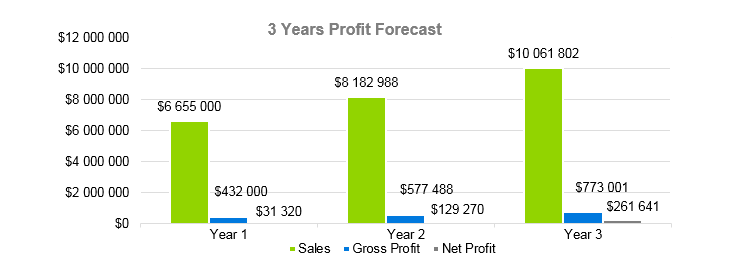
Company Summary
3.1 company owner.
Land Care is started and owned by Judi Smith. Judi has done her graduation in Horticulture. She is well known for her ideas of upkeeping garden spaces. During and after her academic years, she has won many landscaping competitions.
3.2 Why the landscaping business is being started
Judi was always an enthusiast of garden structure design. She decided to start a landscape business plan to utilize her skills and her passion for the benefit of her customers. As well as for earning a good living.
3.3 How the landscaping business will be started
Step1: Drafting landscaping business description
To ensure a successful startup it is essential to do everything with proper planning. Judi studied several landscaping business plan examples to make a landscaping business plan for her business. But due to a lack of experience in marketing and financial analysis, she decided to hire a professional to write a business plan landscape company for her. The landscape business plan she got written is provided in this lawn care business plan sample .
Step2: Define the brand
Judi acquired the licenses and permits required to start her own landscaping business plan . Meanwhile, she defined her services, business values & aims, and customer care policies to get identified by the target market.
Step3: Set up everything from machinery to workforce
After that, Judi started to back up her business with a strong workforce and the latest landscaping tools. She rented a building to set up her office. Meanwhile, she hired a co-manager to get some help in conducting interviews and tests to hire the most competent employees. Then she purchased the required inventory to run her business plan landscape company .
Step4: Promote, market, establish a web presence
The last thing to do was to reach out to the target market. Judi utilized the latest methods including online and social media campaigns to attract target customers. The detailed advertisement plan Judi employed to get introduced to a large audience will be provided in later sections.
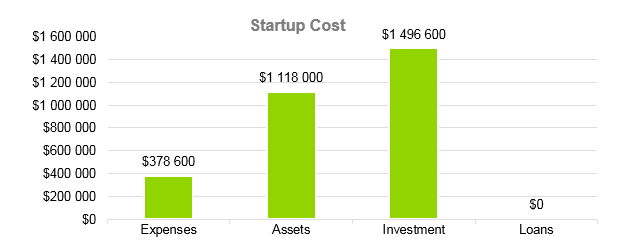
When you are owning your own landscaping business plan you can implement your creative ideas to the fullest. However, it is still necessary to write down the services you want to provide your customers in a landscape business plan template. As it will enable you to get the required inventory and to hire the employees with the relevant skills.
- Stone walls
- Ground cover
- Landscape stairs
- Plant anchors
- Turf installation
- Rotovating soil
- Hydroseeding
- Grasscycling
- Maintenance of rock and gravel landscape
- Planting Trees/ Shrubs/ Flowers/ Vegetables Our last service will include cultivating plants on your lawn. We’ll plant trees, shrubs, flowers, vegetables, and fruits that would be considered best for your soil.
Marketing Analysis of Landscaping Business
Before opening a business plan landscape company it is essential to carry out an accurate marketing analysis. This is to know the market opportunities and your target customers. Exploring the groups of your target customers should be done before even researching on how to write a business plan for landscaping. It is because a thorough knowledge of your customers will enable you in introducing the services that would interest them.
Marketing analysis is a stepwise process. If you are looking for a complete business plan for a landscaping company, you can take help from here. In this landscape business plan and landscaping business model we’re providing marketing analysis done for Land Care.
5.1 Market Trends
Landscaping services are in great demand. Firstly because they freshen and beautify the outdoor spaces. And second due to the awareness in people to keep their surroundings green. According to IBISWorld, the landscaping business plan has seen a growth rate of 1.8% during the past five years i.e. from 2016 to 2021. And the landscape business plan is expected to grow by another 1% in 2021.
The latest stats calculated in 2021 also reports the total market size of landscaping services as $99.7 billion. Thus, the market stats are satisfactory to initiate your startup.
5.2 Marketing Segmentation
The potential customers of Land Care are divided into the following groups:
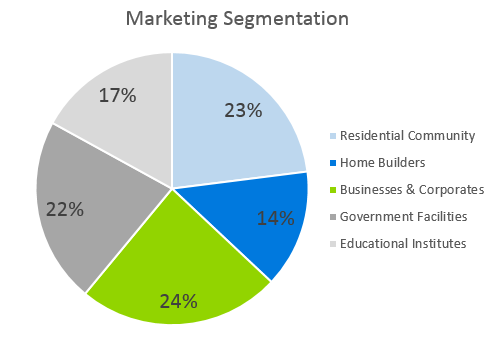
5.2.1 Residential Community
Our primary customers will be the residents living in our vicinity. In our city, most of the families belong to the working class and others do not have a great number of young enthusiasts to install a lawn themselves. Therefore, to beautify and maintain their outdoor they’ll need to hire professional services.
5.2.2 Home Builders
Our second target customers will be the construction companies and contractors who build homes. Landscaping and lawn installation increases the value of the property. Therefore, they are expected to avail of our landscape design services.
5.2.3 Businesses & Corporates
Nowadays, all small and large buildings of businesses and corporates contain decorative landscaped lawns. As that helps in creating a refreshing environment. This group is expected to become our potential customers as they’ll also need regular maintenance and care.
5.2.4 Government Facilities
Government properties, offices, public parks, bus stations, and even some streets are also marked by landscaped lawns and designs. Therefore, they will also be hiring our services.
5.2.5 Educational Institutes
Almost all educational institutions ranging from schools to universities contain beautiful lawns. This is to create a pleasant and natural atmosphere to promote learning. Thus, such institutions are also expected to avail of all our services.
5.3 Business Target
- To earn a net profit margin of $10.7k per month by the end of the second year and $21.8k per month by the end of the three years of our launch
- To achieve an average rating above 4.8 within a year of our launch
- To achieve a Net Promoter Score above 80%
- To achieve and maintain a CSAT score above 95%
Immigration Business Plan
5.4 product pricing.
Our prices are a little higher than our competitors. However, we still expect to get more customers as we provide a 50% discount on the maintenance of lawns that are installed/ designed by us.
Marketing Strategy
No matter how efficient and skillful you are, you can never get customers without an effective marketing plan for the landscaping business plan . Thus, to make sure that your customers know about you, you should start advertising before starting a business plan landscape company . Here we’re listing how Judi decided to market her startup.
6.1 Competitive Analysis
The competitive aspects we’ll have to outperform our competitors are listed here:
- We’ll establish a website and social media account to display our works and to facilitate our customers in booking our services and in giving feedback.
- We’ll use the latest tools to ensure quick work delivery.
- We are highly client-oriented. Our skillful workers will be working in collaboration with customers to ensure that they get what they wanted.
6.2 Sales Strategy
- We’ll set up four different forms of landscaped lawns in our workspace to give an idea of what to expect from us.
- We’ll advertise our services through Google Local ads service and social media sites.
- We’ll make our website SEO to get topmost positions in Google searches.
- We’ll offer a 50% discount on all of our services for the first 20 days of our launch.
- We’ll offer a 50% discount on lawn maintenance/ care services for the lawns that are installed/ designed by us.
6.3 Sales Monthly
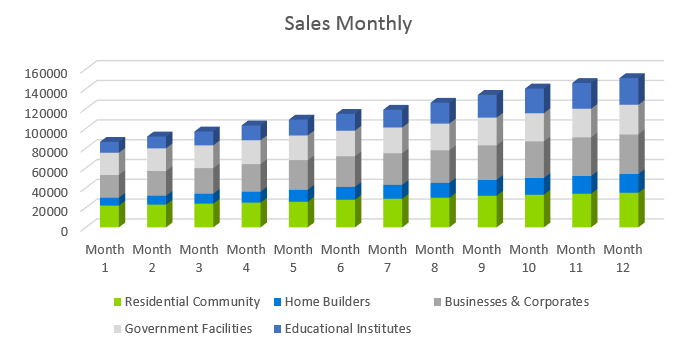
6.4 Sales Yearly

6.5 Sales Forecast
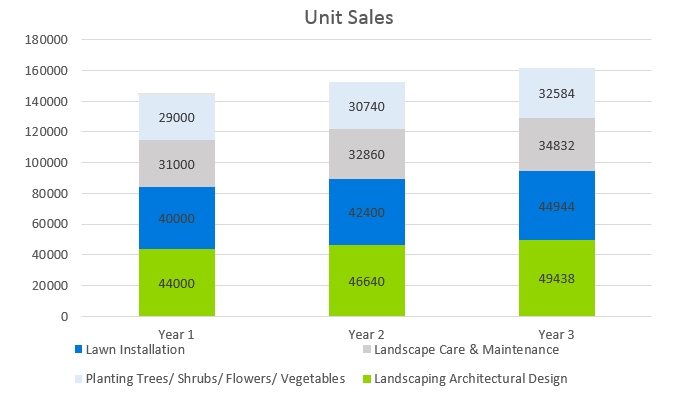
Personnel plan
While writing a landscape business plan you should include a detailed list of the employees you’ll hire to run your business plan landscape company . The list should also include expected/ average salaries so that you can arrange for the finances accordingly.
The personnel plan developed for Land Care is provided here as an example.
7.1 Company Staff
- 1 Co-Manager to help in overall operations
- 5 Landscapers to design, construct & beautify the outdoor area
- 4 Gardeners to fertilize the soil, mow lawn & plant plants
- 1 Social Media Manager to manage company’s sites
- 1 Technician to upkeep the machinery
- 1 Accountant to maintain financial records
- 1 Sales Executive to execute the marketing strategy
- 1 Receptionist/ Call operator
7.2 Average Salary of Employees
Financial plan.
The financial plan is a crucial component when you make a landscaping business plan. In your financial plan, you should analyze projected profits and losses, gross margins, cash flows, and balance sheets to find out
- Where to invest more in order to get the desired goals?
- What financial decisions should be taken to achieve long term success?
- How to ensure financial stability for your business plan landscape company ?
To help you in making a landscaping financial plan that satisfies all the above-mentioned requirements, we’re providing the financial plan sample made for Land Care.
8.1 Important Assumptions
8.2 break-even analysis.

8.3 Projected Profit and Loss
8.3.1 profit monthly.
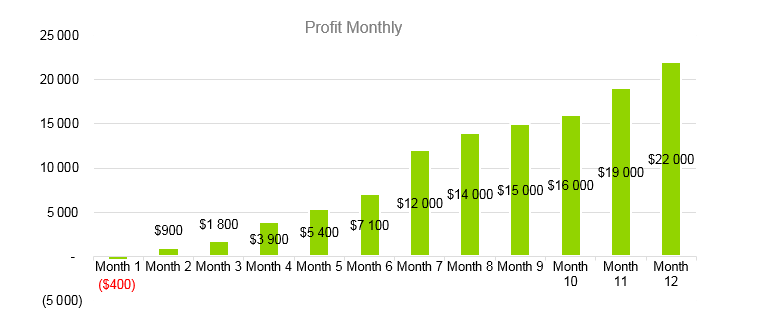
8.3.2 Profit Yearly
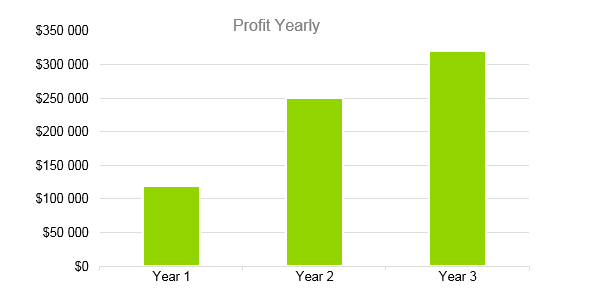
8.3.3 Gross Margin Monthly
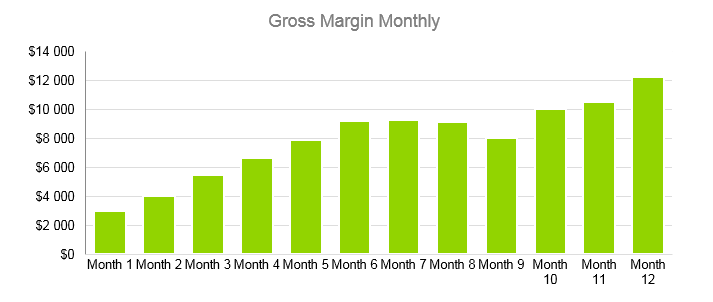
8.3.4 Gross Margin Yearly
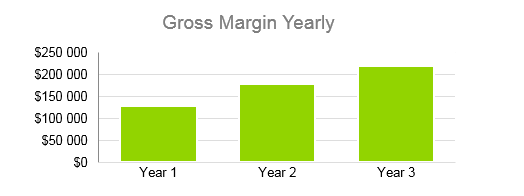
8.4 Projected Cash Flow
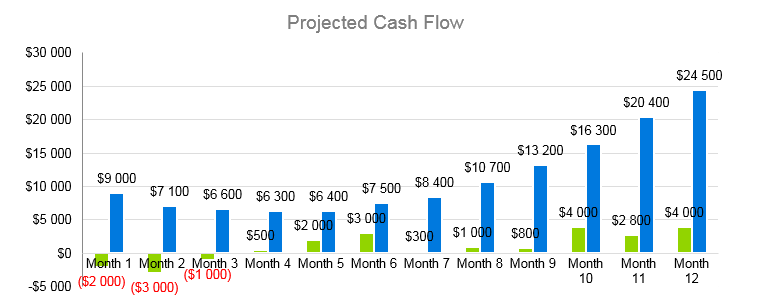
8.5 Projected Balance Sheet
8.6 business ratios.
Download Landscaping Business Plan in pdf
OGS capital professional writers specialized also in themes such as garden nursery business plan , janitorial services business plan , pressure washing business plan , real estate flipping business plan , handyman business plan and many other business plans.
OGSCapital’s team has assisted thousands of entrepreneurs with top-rate business plan development, consultancy and analysis. They’ve helped thousands of SME owners secure more than $1.5 billion in funding, and they can do the same for you.

Add comment
E-mail is already registered on the site. Please use the Login form or enter another .
You entered an incorrect username or password
Comments (0)
mentioned in the press:
Search the site:
OGScapital website is not supported for your current browser. Please use:

- Online Invoice Generator
- All Features call_made
- Estimates and Invoices
- Saved Invoices
- Secure Access
- Construction Invoice
- Consulting Invoice
- Freelance Invoice
- Rental Invoice
- Free Auto Repair & Mechanic Invoice Templates
- Graphic Design
- Photography Invoice
- Contractor Invoice
- Printable Invoice
- Pro Forma Invoice
- Word Invoice
- Excel Invoice
- Invoice PDF
- Google Sheets
- Itemized Bill
- Online Invoice Generator call_made
- Rent Receipt
- Cash Receipt
- Donation Receipt
- Receipt Maker call_made
- Free Quote Templates
- Estimate Maker call_made
- Profit Margin Calculator & How to Use It
- TRY IT FREE NOW call_made
- Support call_made
- Login call_made
How To Write a Business Plan: A Step-By-Step Guide
April 23, 2024.

No matter how unique your ideas are, launching a successful business without a well-crafted plan is tough. That’s why learning how to write a business plan is key to seeing success from the start.
An actionable business plan helps you and potential investors understand exactly where you want to go and how to get there. And if you aren’t trying to secure funding, a lean business plan can summarize the highlights to help you in other areas. Here’s everything you need to write a business plan that clarifies your company’s vision.
Business Plan Basics
A business plan outlines the company’s products or services, how it makes money, and its customers. It should also identify the business’s long-term goals and how it’ll achieve them.
But what does a business plan look like? There’s no singular format, but most contain the following core elements:
- Executive Summary . The executive summary is a high-level summary of your business plan’s key points. Include this early in the document, but write it last so you can accurately describe what’s in it.
- Company Description . This section covers your company’s mission, leadership team, and goals. If your business has operated for several years, include a history.
- Market Analysis . This is where you’ll write out your market research. Gather data on your industry. That includes target customer segments and the current competitive landscape. This info demonstrates the viability of your business idea.
- Product and Service Offerings . Describe your company’s offerings and what sets them apart from competitors. This is your unique value proposition.
- Marketing Plan . Outline your marketing tactics and overall strategy. Mention your plan for pricing, promoting, selling, and distributing your products. This helps investors know you have a strategy in place to grow your business.
- Logistics and Operations Plan . After describing your products and how you plan to generate demand, lay out how you intend to drive, accept payment for, and support sales.
- Management Overview . Potential investors want to know who they’re betting on. This section provides crucial information about who’s in charge. Include their track records of success, relevant expertise, and roles and responsibilities.
- Financial Analysis and Projections . If you have them, include any historical financial details and performance metrics. This includes assets, liabilities, expenses , projected financial statements, cash flow statements, and anything else offering insights.
- Appendix . This final section is a catch-all for any miscellaneous but valuable background information. Examples might be licenses or patents.’
RELATED ARTICLE — How to Keep Track of Business Expenses
How To Create a Business Plan

With a clear understanding of these documents, it’s time to learn how to write one. Here’s how to put together a strong business plan for your company:
- Carry out a Market Analysis on target demographics, competitors, industry trends, and market.
- In the Company Description and Products and Service Offerings sections, explain what makes your offerings unique.
- Outline your Marketing Plan and sales strategy. Describe your target market and ideal customer. Include factors like geographic region, age range, and education level.
- Map out your Financial Analysis and Projections. If you’re an established business, include data like profit-and-loss statements, a balance sheet delineating your assets and liabilities, and cash flow statements or projections. If you’re still in the early stages, focus just on financial projections instead. Mention anticipated startup costs and your current cash flow.
- Your Logistics and Operations Plan explains how you’ll execute your ideas. Describe any relationships with suppliers, office space, or equipment. Make sure to mention production logistics and any shipping and fulfillment plans. This demonstrates that you understand the day-to-day operations of producing your product.
- Introduce yourself and/or your Management Team and principal hires. Emphasize past successes in related sectors and any unique expertise your staff has.
- Regardless of what order you prepare your business plan in, write the Executive Summary last. Do this by turning your market research and value proposition into tangible objectives and key milestones. This section is typically the first your readers see, so it should make them want to read more.
Be sure to get feedback from colleagues, industry contacts, and friends and family. The more eyes you get on your business plan, the less likely you are to make mistakes or leave out details.
RELATED ARTICLE — How to Offer Net 30 Terms
What Are Business Plans For?
Writing and adhering to a business plan allows you to think through every aspect of your business. This helps you clarify your vision and shows where your ideas aren’t as developed.
But business plans don’t just clarify the company’s mission and direction. Entrepreneurs hope to answer this tough question with a business plan: how to attract investors. A well-written document can instill confidence by showing how supported it is. This is the main reason many business owners create a comprehensive overview.
And investors aren’t the only ones you’re trying to impress. An inspiring business plan attracts top talent in your industry. It proves that your team is organized, knows what it wants, and has ideas for the future.
Exploring Different Types of Business Plans

Business plans can be categorized based on type and style. Let’s explore three of the most common types.
A traditional business plan is the most common. This is what lenders and investment funds want to see before making any decisions. Traditional business plans are typically long. That’s because they provide a thorough overview of your company’s abilities, finances, and prospects
If you’re not courting investors, you might prefer a lean business plan. This type of document is shorter, focusing on the highlights instead of completeness. A lean business plan is great for brainstorming or onboarding new team members with reduced time and effort. But, because they’re less comprehensive, lean business plans aren’t ideal for seeking outside investment. Investors might not see how viable your business is without the added details.
Finally, if your organization is a nonprofit, focus on the impact you hope to make for your chosen cause, not how you’ll grow revenue. But donors may want to see a more detailed business plan before making sizable donations.
RELATED ARTICLE — How to Write an Invoice in 5 Steps
Caveats To Watch Out For
An actionable step-by-step business plan requires a strong understanding of how it will help you reach your company’s goals. Now that you know how to start a business plan, here are some common mistakes to avoid when you start writing:
- Putting on Rose-colored Glasses . When you believe in your company and its mission, it’s easy to be too optimistic about future prospects. You might also overlook potential roadblocks. Be sure to keep one foot on the ground to avoid misrepresenting your company’s potential.
- Focusing Too Much on the Details . If your company is new or not yet established, focus on high-level strategy and vision. Save the details for when you’ve generated some actionable data.
- Setting Fuzzy Goals . Keep milestones concrete and measurable to meaningfully track progress.
- Overcomplicating . There’s nothing wrong with being comprehensive, but creating an overly intricate strategy makes it harder to execute. Keep it simple.
- Setting It in Stone . Your business plan won’t be much of a guide if you’re constantly making changes. But it’s important to move on from ineffective strategies or unachievable goals. Striking the right balance between stable ideas and flexible methods ensures your business plan is a help, not a hindrance.
5 Tips for an Effective Business Plan

Now that you know what to avoid, let’s learn some tips for making your business plan as effective as possible:
- Clearly Articulate Your Value Proposition . What unsolved problem does your company provide the solution for?
- Don’t Skimp on Market Research . A seemingly great idea won’t sell if no one is interested in buying it.
- Set Quantifiable Goals You Can Track . It’s difficult to measure progress toward vague, qualitative milestones.
- Hype up Your Team . Lenders and investors want to see that qualified personnel run your company.
- Manage Expectations . Don’t make promises you can’t keep. Surpassing your targets is impressive; falling short isn’t.
Business Expense Tracker
Make it painless to include expenses in your business plan by tracking them using our in-app receipt scanner.
Share this with your network
You may also like, related posts.

Bookkeeping Versus Accounting: Differences Explained

How To Calculate Retained Earnings And Why It’s Important

Revenue Versus Income: Definition and Differences

How To Calculate Cash Flow: Key Formulas and Practical Examples

What Is the Difference Between Gross and Net Pay?

How To Register a Business in the US: A Comprehensive Guide

The 8 Most Common Business Structure Types and How To Choose One

How to Offer Net 30 Terms (for Small Businesses & Contractors)
Get started for free, send your first invoice right now (it's free), featured in.
Filter by Keywords
Project Management
How to write a business case: the formula for getting project approval from stakeholders.
Praburam Srinivasan
Growth Marketing Manager
April 29, 2024
Do you feel you’ve found a solution to one of your company’s most pressing problems? Do you want to go straight to your seniors and tell them about your idea, basking in the glory of your eureka moment? 💡
Before you do that, take a deep breath and consider if your solution requires a significant financial commitment or a shift into critical business functions . If it does, you should learn how to write a business case to properly present your idea to the higher-ups.
Never done that before? No worries. In this article, we’ll explore:
- The concept of a business case
- The difference between a business case and a business plan
- The process of building a compelling business case
- Some real-life examples to understand how business cases help win project approval
Importance of a business case in project management
What is the difference between a business case and a business plan, 1. executive summary, 2. project definition, 3. financial appraisal, 4. project goals and success criteria , 5. project scope and schedule, 6. risks and mitigation strategies, step 1: problem identification, step 2: stakeholder identification, step 3: drafting background information and project definition, step 4: cost-benefit analysis and financial appraisal, step 5: evaluation of alternatives, step 6: describing the project scope and implementation approach, step 7: drafting the executive summary, step 8: putting it all together, lean startup example, venture capital funding example, outsourcing example, supply chain example, 1. drafting it alone, 2. not taking stakeholder feedback, 3. not reviewing or proofreading, create a compelling business case with clickup.
What Is a Business Case?
A business case explains how the rewards of investing in a business idea or initiative outweigh the risks and costs .
It’s one of the many project management documents (like a project charter or a project plan ) you may have to create when seeking the green light to proceed with a project. A well-crafted business case can be crucial for obtaining approval from your client, management, or other stakeholders in the early stages of your project’s lifecycle . 🟢
The key role of a business case is to justify an investment . It plays other important roles that make project management more efficient . Some of them include:
- Providing clarity: Drafting a business case requires careful planning and research, which brings clarity of thought and improves your understanding of the initiative or project you’re going to propose
- Resource optimization: A business case helps ensure that the company’s resources are being used productively and contributing to its long-term strategic objectives
- Removing doubt: By comparing different solutions, the document eliminates any doubt that an alternative way to fix a business problem is better than what you’re proposing
Preparing a business case can take a lot of time and effort, so it only makes sense when a project or an initiative requires a significant financial commitment. For all other approvals, you can use the project charter. Some scenarios in which a business case can make sense include:
- A new project
- New product line
- Introduction of a new customer persona to your marketing strategy
- Major changes to the supply chain, like introducing new suppliers or distributors
While a business case may seem like a synonym for a business plan , based on its definition, content, and name, there are major differences between them. The most notable ones are:
- Use case: A business plan is made for an entirely new business, while a business case is created when asking for a substantial financial commitment within an existing business
- Purpose: A business plan aims to hammer out the complete business strategy, while a business case tries to explain the advantages of a specific initiative
- A company’s mission and vision
- Financial projections
- SWOT Analysis
- Market analysis
- Go-to-market strategy
- Team profile
A business case, on the other hand, includes only financial projections, risks, and costs of a project
- Level of detail: Given the scope of information they need to cover, business plans tend to be much more detailed than business cases
Key Elements of a Business Case
While the exact structure of a business case will vary based on a specific situation, here are some of the essential components:
The executive summary provides a quick overview of the critical details covered in your business case.
Given that managers and executives are usually strapped for time, the executive summary will often be the only part of the document they actually read. That’s why it’s crucial to get this part of the document right and leave a powerful first impression.
The project definition sets the context for your business case by explaining the problem you aim to solve. It highlights an unfulfilled business requirement, outlines why it’s not being met, and finally presents your solution for addressing the mentioned shortcomings.
This is the crux of the matter—the financial appraisal part outlines the ROI your proposed initiative or project will likely generate for the business. It also covers the expected cost of executing your project or implementing your solution.
This part of the business case defines all the objectives and key results (OKRs) you want to achieve through the proposed project or solution. It also explains how those goals align with the company’s short-term and long-term goals. Lastly, it establishes success criteria for your project in the form of KPIs and key metrics .
The project scope sets limits and boundaries for your project by allocating resources and budgets and developing a schedule for completion.
A business case has to list all the risks associated with implementing the proposed solution and the mitigation strategies for dealing with them. It also weighs in on alternative approaches and their respective risks to explain why your initiative should be the preferred option.
How to Write a Business Case in 8 Steps
Writing a business case is an elaborate task that requires extensive research and numerous analyses, from SWOT and cost-benefit analysis to stakeholder analysis. It’s no walk in the park, but it becomes much easier with an exceptional project management platform like ClickUp .
ClickUp equips project managers and business professionals with all the tools they need to craft a business case that will win the hearts and minds of their superiors—from ready-made templates to AI-powered document management features. Let’s find out how to write a business case in eight steps with the help of ClickUp.
Many business ventures fail because they create solutions to non-existing problems. To prevent this scenario, make sure you consider the following:
- Objective(s) your company wants to achieve. Examples include achieving a revenue target , meeting an unaddressed customer need, or achieving a competitive advantage
- Problem(s) holding your company from achieving its desired objectives. Examples include a lack of operational efficiency , incorrect customer targeting, and supply chain issues
- The solution you want to propose to solve the problem and meet the objectives
- Evidence and case studies to prove that your proposed solution can indeed solve the problem
A structured way to identify your business problems is to use the ClickUp Root Cause Analysis Template . Classify everything going wrong with your business into multiple “Why” columns and then add their root causes in the relevant color-coded blocks. Once you analyze the root causes, you can tailor your solution to target and fix them.

After pinpointing the problem, the next step is identifying the stakeholders to whom you’ll pitch your business case. A stakeholder is anyone who has a say in approving your business case . Depending on the scope and complexity of your business case, one or all of the following stakeholders may play a role in its approval:
- The Chief Executive Officer (CEO) of the company
- The head of the finance department
- The head of business operations
- The head of the marketing and sales department
- The representative of a client
Discuss your initiative with the stakeholders to see whether they’re interested in it or not. It can also help you understand their perspective on the problem you’re aiming to solve. After all, you don’t want to put your efforts into a full business case only for the stakeholders to reject it. 🙅♂️
The easiest way to identify key stakeholders is to leverage the ClickUp Stakeholder Analysis Template . This framework can help you gauge the influence and support level of all stakeholders who will play a role in approving your business case. This information can also come in handy when you want to collect feedback from a stakeholder.

Once you’ve identified your problem and the involved stakeholders, it’s time to start drafting your business case.
The first part is the project definition section, which sets the background for presenting your case before stakeholders . It covers the problem your business case proposes to solve and explains why solving the problem is important. The section should cover the following:
- The problem you identified and its impact on business functions
- How your project or solution can fix it
- The goals your project or initiative wants to achieve
- How project goals align with the company’s near-term objectives
- The success criteria for your project or initiative
- How its success will move the company towards its long-term strategic goals
The best tool for drafting this part of the document is ClickUp Docs —ClickUp’s built-in text editor and documentation management platform.
With ClickUp Docs’ collaborative editing possibilities, you and your stakeholders can work on the business case document in real time, ensuring its speedy and accurate completion. Stakeholders can also comment on areas for improvement . Finally, you can add a cover image to make your business case look more appealing or use slash commands to quickly add compelling blocks of formatted text.
After setting the background, the next step is the financial appraisal part. This section will be examined carefully during your pitch and serves to capture the stakeholders’ interest in your business case. For maximum accuracy, consult with a colleague from the finance department while drafting this part of the document.
Some of the information you may want to cover here includes:
- Projections about financial gains
- Costs to be incurred by the project
- Cash flow forecast
- Cost-benefit analysis and return on investment (ROI)
- Sensitivity analysis to explain the margin of error in your numbers
Besides the financial aspects, this section also deals with risk analysis . Information on all potential risk factors identified through SWOT analysis, Monte Carlo analysis, and other risk identification strategies are outlined along with their respective mitigation strategies . It’ll be best to discuss the project risks with stakeholders identified in the first step—they can often share hidden insights and perspectives.
ClickUp provides a number of tools to help you conduct each of these analyses. For instance, you can use the ClickUp Cost Benefit Analysis Template to complete your cost-benefit analysis.
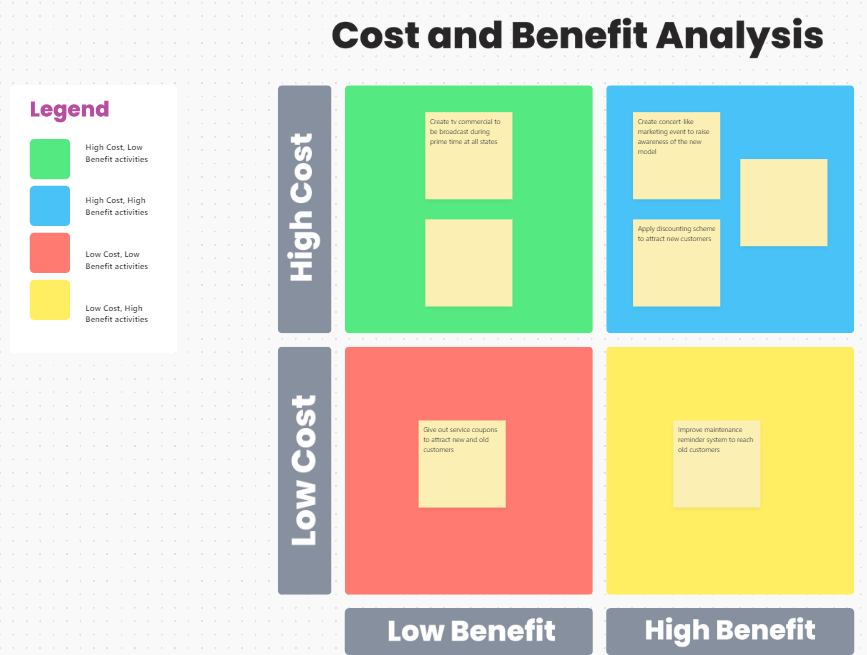
Similarly, the ClickUp SWOT Analysis Template can save you from jotting down rows of data to identify your initiative’s strengths, weaknesses, opportunities, and threats. It is a visually rich template that lets you easily identify high-impact activities and functions.

In this section, you should evaluate the alternatives to your proposed solution in the business case. Highlight the pros and cons of each option so the stakeholders can have a complete overview of every possible solution. Make sure to include your proposed solution in the comparison as well to explain why it’s better than all the alternatives.
If you need help examining and comparing the alternatives, fall back on the ClickUp Comparison Matrix Template . Use it to record all the information about each possible alternative in different fields and then compare them on a Kanban board. Its visual format makes decision making easier, while its fully customizable fields allow you to record as many comparison parameters as you wish.
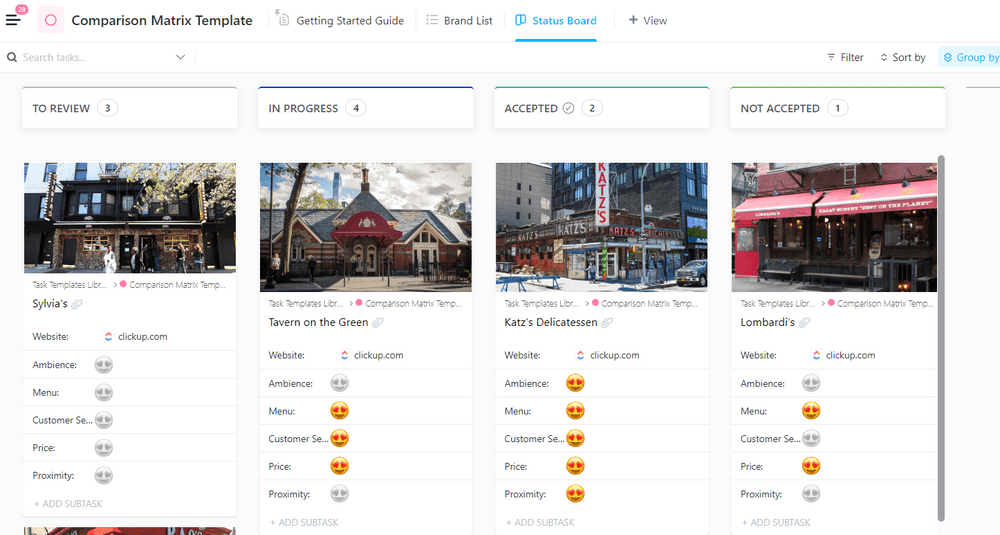
After you detail all the financial aspects of your project and compare it to alternatives, define a project scope in your business case. This section sets boundaries for the pending work and limitations on resources needed to complete it. Crucial information covered in it includes:
- Budget and resource allocation: Financial and other resources, like team members, workspace, equipment, etc., that should be allocated to the project
- Deadlines: Time required to complete each part of the project
- Dependencies and relationships : Details of current business functions that may be affected by the project
- Deliverables: What you plan to deliver by the end of your project
- Exclusions: What’s not a part of your project
Once you define the project scope, outline the exact steps for implementing it. The easiest way to do this is to use the ClickUp Scope of Work Template . It allows you to record every aspect of the project scope in a well-organized manner to share with your stakeholders and get their opinions.

Once all major sections of your business case have been completed, you need to draft an executive summary to digest the crucial details from each section. This summary should be concise, ideally no longer than two pages. It will appear as the first item in your business case, providing stakeholders with a quick overview of your proposed project.
If you need help drafting your executive summary, team up with ClickUp Brain , a neural network and AI writing assistant built into ClickUp Docs. In mere seconds, it can generate a pitch-perfect summary of any business case document prepared until now.
Once you have your executive summary draft, use the ClickUp Executive Summary Template to format and organize it in a structured and presentable manner.

Now, it’s time to put together and structure all the sections drafted to this point to finalize your business case. That’s where the ClickUp Business Case Analysis Template can be a lifesaver.
The template includes dedicated sections to record each part of the business case. All sections are arranged in a structured manner to ensure that when you pitch your case, it makes a lasting impact on your stakeholders.

Real-Life Examples of Business Cases
Now that you know how to write a business case, let’s check out some real-life examples of how business cases allow companies to approve major projects and make strategic decisions:
A lean startup operating in the healthcare space is facing workforce issues, which are preventing it from launching its product on time. The head of the product development team wants to hire three more engineers to speed up the product development process .
However, since it’s a lean startup with budget constraints , the team head needs approval from the startup founders before making the decision. So, the product team compiles a business case for hiring additional employees , and here are the main elements of their proposal:
- A brief overview of how insufficient staffing is delaying product development and pushing the product launch beyond the planned deadline
- Elaboration of how three new engineers can bring product development back on track
- Cost-benefit analysis of the move
- Exploration of the involved risks
- Presentation of alternatives and their associated risks
- Scope of the change, like the nature of work the new engineers will perform
A venture capital-funded fintech startup decides to launch a new product line of credit cards . It will allow the startup to onboard a slew of new customers but will also require significant financial investment for marketing and lending purposes. So the company prepares a business case for this new product line in an effort to obtain funding for it. Here’s what they detail in their business case:
- The need for this new product line and how it complements the company’s other offerings
- The market opportunity with revenue projections and cost-benefit analysis
- Risks involved in the project, like competition, mass default, and regulatory scrutiny
- Alternatives available, like launching prepaid debit cards, which probably wouldn’t be as useful for customer acquisition
- Scope of the project, like team members working on it, the budget allocated, launch schedule, and timeline
A SaaS software vendor based out of Silicon Valley wants to reduce customer service spending without compromising service quality . The product manager of one of their leading products comes up with the idea of outsourcing customer service . So, they decide to prepare a business case before proposing the solution to the management. The business case outlines:
- The problem, which is a significant share of revenue going into customer service operations and how outsourcing can help bring it down
- Risks associated with outsourced customer service and mitigation strategies for them, like having an escalation mechanism for unresolved support tickets
- Alternatives and their risks, like using AI chatbots to automate customer service , which can be frustrating for customers who need human guidance
- Cost-benefit analysis of making the change
- Scope of change, like how many of the customer support employees will be laid off
A construction company in Virginia is facing raw material supply issues . The cement supplier they work with repeatedly fails to meet the demand, so the project supervisor decides to add some redundancy by onboarding a new vendor.
This change can greatly influence the project, so the supervisor prepares a business case to propose the initiative to the management. The case addresses the following:
- How the new cement supplier can keep the project from being delayed
- The supplier’s reliability, as demonstrated by the years of industry presence, major companies for which they have supplied cement, etc.
- Alternative suppliers, their capacity, and reliability information
- Cost-benefit analysis of making the change, since the rates of this supplier are slightly higher than those of the existing vendor
- Scope of change, including how much of the supplies will be delivered by the new supplier, for how long, and at what price
Potential Business Case Challenges and How to Overcome Them
There are a number of mistakes project managers make when drafting a business case, which can jeopardize the approval of the entire project or initiative. Now that we’ve covered the complete process of writing a compelling business case, let’s look at the most common pitfalls and explore ways to avoid them.
The details of a business case require extensive research and knowledge of different business functions. No project manager can do it all alone without making mistakes or errors of judgment, so look for help from different departments in your company, whether it’s finance, marketing, or operations. 💁
Another crucial mistake when building a business case is presenting the document to stakeholders out of the blue. When you don’t involve relevant stakeholders at any stage in your business case development process, you increase the risk of it being rejected. That happens because:
- You don’t know their expectations
- They didn’t have any role in your business case, which keeps them detached from your work
To avoid this scenario, involve stakeholders at different stages of your business case drafting process and get your progress reviewed regularly.
The last thing you want when pitching your business case is a typo or a misrepresentation of facts. That can leave a bad impression on the stakeholders listening to your pitch. They may not take you seriously and ultimately reject your project proposal .
To ensure a bulletproof document, you should always review and proofread your entire business case before submitting it . Pay special attention to numbers and facts and double-check that they’re correct. Then, go ahead with your pitch.
A solid business case is the first step to getting project approval from your stakeholders. However, building it requires careful planning and the right tools to streamline the entire process. Fortunately, ClickUp equips you with everything you need at each step of building your business case—from ready-made templates and documentation tools to AI-powered writing assistance.
Sign up for ClickUp today and write a business case that will earn support and trust for your project or initiative.
Questions? Comments? Visit our Help Center for support.
Receive the latest WriteClick Newsletter updates.
Thanks for subscribing to our blog!
Please enter a valid email
- Free training & 24-hour support
- Serious about security & privacy
- 99.99% uptime the last 12 months
How to Write an Online Business Plan in 2024
Written by Vanessa Petersen on July 26, 2023 Blog , Sell Online .
You’ve committed to turning your ecommerce or online business idea into something real. You want your small business to produce revenue and change the course of your life, but what’s your first step in realizing your dream? Developing a plan. If you’re not sure about how to write an online business plan, you’ve come to the right place.
One of the most essential tasks involved in starting any kind of business is to write a business plan. An online business plan won’t look that different from a traditional business plan and will include many of the same elements.
In this post, we’ll show you how to write an online business plan, including all the components and sections. We’ll also walk through how WooCommerce can help you put your plan to action and achieve your business goals.
Why write a business plan?
Starting your own business is a great experience and something that will shape your life, fill you with self-confidence and independence, and inspire other people around you. A new business is also a serious endeavor that will take time, money, sweat, lots of decisions, and a degree of risk.
A traditional business plan template helps you document and keep track of your business goals, challenges, opportunities, and all the steps and processes involved with making your idea work. It will help you conduct thorough market research and set you up for success.
When you write a business plan, it can confirm that you’ve found the best online business to start , or provide clarity about the need to pivot.

It details all the things you will need to do in order to successfully launch and grow your business, and may include revenue projections, timelines for specific goals, concept art for products, and architectural drawings for any brick and mortar aspects of your business.
Business plans help create a structure for your company’s development and keep you grounded in reality, focused, and not distracted by less important matters.
If you have more than one person helping run the business, the business plan also keeps everyone unified around the same set of goals and objectives.
Another reason to write a business plan is for situations where you are presenting your idea to someone else and asking them to invest. In that scenario, your business plan is also a sort of sales document. It makes the argument for why your business idea is so good and well-considered that an investor should want to be a part of it.
But even if you’re self-funding your entire business — which is more common with online businesses — you still want to write the plan for the reasons given earlier.
The benefits of running an online business
Starting an online business or ecommerce store offers many of the same great benefits as any other business, but without as much risk. If you’re thinking of starting a business, here’s why an online one is a great option:
It has low startup costs
Without a storefront, you eliminate so many costs of running a business. With all the bills that come with having property — like rent, parking, furnishings and decor, etc. — there’s a much higher investment required to start a brick-and-mortar-based business. Online businesses still have startup costs, but they are much lower.
It gives you freedom over your schedule
With an online business, you have more freedom to set your own hours, because you don’t always have to be open during the usual times. You can build your business to suit the lifestyle you want. Rearrange your time to get things done in the fastest possible way and take time off when you need it.
You can start small
Once you have a location, it’s yours, and you have to make it work. With an online business, you can start very small, offering just a few products or even just a single service. You can more easily test the waters without making huge commitments with inventory, and other physical investments.
You can more easily pivot
If your online or ecommerce business doesn’t do as well as you expected, it’s easier to pivot and adapt to something new because you haven’t committed so much to making your original idea work. There are many business success stories where the business owner adjusted their idea after gaining some experience, and then it took off. It’s a lot easier to do that when you aren’t tied to a physical location.
But, there’s one thing online businesses have in common with every other type of business: You need a robust business plan to help guide your idea from concept to a successful reality that makes money and fulfills your dreams and goals.
So, let’s get into business planning.

How do I write my own online business plan?
Most formal business plans and business plan templates include seven sections, plus an executive summary. You’ll need to keep in mind who you’re writing your business plan for. If you are taking this to potential investors or will be seeking a business loan, your business plan needs to sell the idea of your business as a great investment opportunity and communicate the skills, expertise, and commitment you personally bring to the table.
Here are the key sections of a traditional business plan format:
- Executive summary
- Company description
- Market analysis
- Organization and management
- Service and product line
- Sales and marketing plans
- Financial projections
- Funding request (if working with investors or partners)
Here’s a brief look at each step of creating an online business plan:
Draft an executive summary
In the executive summary, the first section of almost every business plan template, you’ll present your vision and focus on building excitement. If the business plan is a sales document, the executive summary is the lead. It gets the reader engaged and excited to hear more.
Your executive summary should achieve two goals:
- Deliver the basic facts about your business
- Motivate the reader to keep going and get them excited about your idea
What facts should you include? Whatever helps the reader understand your business idea. Describe the industry and niche. Mention the target market. Briefly state the needs or problems your products and services will be solving. Touch on the potential for growth in terms of revenue and customers.
For motivation, describe your mission statement and company values. What will set you apart from the competition? What is your value proposition as a business owner? What makes you different? Again — keep this brief. You’ll elaborate later.
It might be a good move to write all the other sections first, then finish with the executive summary so it will be the most concise and best version of how you describe your business.

Write a company description
Here, you’ll give a brief overview of your company. What are your strengths, skills, and areas of expertise as a business owner that will position you for success? If you have a compelling story behind why you’re starting your business, you can include that too.
Conduct a SWOT analysis
If you’re not sure where to start, consider doing a SWOT analysis , which is a diagram outlining your strengths, weaknesses, opportunities, and threats.
It’s a common part of many business plans and will help paint a realistic picture of what your business can achieve, and what stands in the way. You won’t include all of this in the company description, but your strengths and opportunities may fit here.
Create a mission and vision statement
The company description is also the place to create a mission statement and a vision statement. What’s the difference between these?
The vision is where you’re going, the mission is how you’ll get there. A vision statement paints a picture of a future reality for your customers and perhaps the world at large, as a result of your company’s influence. A mission statement expresses how you will achieve that.
The company description can elaborate on your vision and mission beyond just a single sentence, and later you can fine-tune what you write into a succinct pair of statements. Feeling some writer’s block? See company description templates by industry for some inspiration.
Include any unique attributes
If your company will involve particular attributes such as manufacturing, supply chains, dropshipping, affiliates, coaching or advising, online courses, or other relevant particulars, include that in your company description, too.
State your business location, industry, niche, and other details
Also, state the location of your business, even though it’s online. Name your industry and niche target market again, and describe the nature of your company. For example, is it an ecommerce business, a consulting firm, delivery service, wholesale, or ad-based website? These are just some of many types of online business structures.
You may also want to include whether your business is in any special class of business that might position it for special loan or grant opportunities like women-owned businesses or veteran-owned businesses.
After reading your description, readers should have a good understanding of what your business is about, why it exists, and how it works. Here’s a detailed look at company descriptions , with an example.
Perform a market analysis
A market analysis uses industry research to assess the scope of your business’s target market and describe the current competition in your industry. It can help you estimate the potential for success and prepare for the challenges you may face when you launch your online business or ecommerce shop.
Doing this research, and including it your business plan, can also help you:
- Identify industry trends
- Pinpoint opportunities
- Diminish risks and reduce costs
- Generate new ideas for products and services
- Learn from the failures and shortcomings of your competitors
- Find ways to stand out from your competitors
- Discover new markets
- Refine your marketing plans
Now let’s dig into the elements involved in a thorough market analysis.
Understand your audience
Here, you will explain in detail who your target customers are and why they want or need what you’ll be selling. What problems or needs does your product solve? What will motivate people to buy from you? And why can’t they get it somewhere else just as easily? An ecommerce business competes against other ecommerce businesses as well as brick-and-mortar stores and shopping malls. Stores with omnichannel strategies compete with both. Why would someone choose you?
Share your key customer demographics, psychographics, and interests. Who will you be serving? What drives them?
What are their values? If your product, service, or personal brand will appeal to a customer segment that also shares particular values, that’s a strength, not a weakness, and you can use that to win them over.
Perform customer segmentation
Break down different categories of target customers your business plans to serve. One category could be age. Another might be life situations such as retirees, parents, divorcees, or living with older relatives. You could create a segment of people with particular health conditions, or who live certain lifestyles.

But you can also get way more specific than that. Runners are different from hikers, who are different from bikers, yoga enthusiasts, and gym enthusiasts. Different supplements, philosophies about food, motivations for eating various foods — all of these present near endless possibilities for more narrowly defining your customer segments, all under the broad category of ‘health.’ And you might serve multiple segments.
The more customer segments you know, the more effectively you can market to them. In an online store, good product descriptions call out the various customer segments that product is designed for.
Also, give a sense of the potential size of your target market. How many people need what you’re selling? Show how this market is large enough to justify your business and drive revenue. You might do this by studying revenue reports from other companies in your industry. Or look at specific products related to yours and research their sales and revenue performance.
You may also perform a survey of some kind, or an online quiz, and use that to express the needs your potential customers have that aren’t currently being met.
Perform a competitive analysis
Study your competition. What are they doing well? What areas are they underserving? Where are they underperforming? Make note of what other companies in your industry are struggling with or failing at so that you can deliver something more valuable and gain a competitive advantage.
It could be product quality, customer service, or selection. Maybe their ecommerce store is badly designed and hard to use. Perhaps there’s a huge industry serving the masses, but customers who have more particular tastes or needs aren’t being well-served by the big companies. Those customers might spend more on something that delivers what they really want.
Maybe your key competition has been rocked by scandal. Maybe a company went out of business, was sold, or closed down due to retirement and there’s an opening in the market you want to leverage.
The main point of the competitive analysis is to persuade investors that there’s an underserved market that your business plans to cater to. You must be able to promise something that no one else is currently delivering. Otherwise, why should your business exist? Put them at ease by demonstrating proper market research.
Refer to your SWOT analysis and present any potential threats from the competition here, too.
Outline management and organizational structure
Next, present your management and legal structure. Is your company an LLC, sole proprietorship, S corporation, partnership, or some other arrangement? Who’s in charge of what? If you have different departments, list out the leadership for each one. If relevant, you might even include some information about the expertise of your leaders concerning the areas under their charge and the tasks they’ll be performing.
Remember — if your business plan will be used to persuade investors to help fund your business idea, this sort of information will reassure them that your company has strong and competent leadership.
If there’s a chain of command, use a diagram or other method for laying out who reports to whom.

List your products and services
What are you selling? You’ll touch on this briefly in the earlier sections, but here is where you’ll expand on the details. If you have an array of similar products, such as food flavors or clothing variations, list as many as seem relevant. But focus on the spirit of the business plan — you’re simply communicating what your business is about, not listing every SKU in your projected inventory.
Also, include information about your products such as quality, durability, expirations, patents, and whatever else will give a clear picture of what you’re selling.
For service businesses and memberships that may include multiple packages, bundles, or tiers, describe each of these so your readers get a sense of how you’ll appeal to different types of customers and price points.
Develop a sales and marketing strategy
Having products is great, but how do you intend to sell them? How will people find your business? How will anyone know you exist? And once they know, what will motivate them to buy from you and not from your competition? What is your unique value proposition — the thing that sets you apart from your direct competitors?
You’ll need to develop an initial marketing plan to help promote your business, products, and services to your target customers.
And remember, competition isn’t limited just to other businesses. Sometimes, competition is against the customer’s time, or their budget, or mere indifference — the conflict between doing something and doing nothing. Your SWOT analysis should touch on several of these potential barriers to the success of your online business.
Your marketing plan will obviously change over time, but give your readers and potential investors a sense of how you plan to launch and grow your business.

Discuss media channels you plan to use, such as pay-per-click (PPC) ads , social media , email marketing , affiliate marketing , direct mail, referrals, joint ventures, search engine optimization (SEO), webinars, influencer marketing , and live events. Describe the ones you actually plan to use, and explain the core strategy you’ll begin with and how you will measure success.
Also, include a sense of your marketing budget. If you will have a dedicated marketing team, or actual sales professionals using a particular process or sales script, discuss that as well.
For ecommerce businesses, include a discussion of how you plan to leverage platforms like WooCommerce, which features a host of extensions that can help manage your business , engage customers, save money, and promote growth .

Make financial projections
You’ve made a lot of claims in your business plan, but how will your investors be convinced of your future success? At some point, you have to show them the money.
If this is a brand new business with no income, where will your finances come from for the first year? Give realistic financial projections for anticipated profits and losses, as well as growth expectations for the first five years. Include financial documents if you have them, including profit and loss statements, balance sheets, and cash flow statements. Include costs of employment, manufacturing, and other investments both one-time and ongoing.
Your financial projections should reference your:
- market analysis
- anticipated sales volume
Investors will feel more confident when they can see your business plan does not rely entirely on just one or two ‘wins.’ For example, if your entire plan hinges on selling on eBay or Amazon , what happens if Amazon suspends your store, changes the terms, or you struggle to get noticed there?
If your plan depends on winning over a few Instagram influencers, what if they don’t come through? It’s really easy to say what you hope will happen. But actually making it happen is another thing. Business success happens more easily when you apply a multi-channel marketing and sales approach.
Your financial projections will feel based in reality, when you can demonstrate some prior successes, either in other businesses you’ve already launched, test audiences, local sales you made, prior experience, or data from other businesses.
Explain your funding request — if applicable
If you intend to ask investors to help fund your business idea, present your request in the final main section of your business plan. If you’ve already secured funding from other sources, include that here as well. An investor will feel better knowing they are not the only one who believes in the potential of your business.
Will your funding request be for a one-time payment, monthly, annually, or at some other interval? How do you plan to repay their investment? Will you allow them to charge interest? How much ROI can you promise them?
How WooCommerce can help
WooCommerce can help you build a scalable online business that supports your business plan. No matter what you’re selling, WooCommerce offers a suite of flexible tools that allows you to customize your store to meet your needs and goals.

Here are just some of the benefits your business will enjoy when you choose to build your store with WooCommerce:
- Sell absolutely anything you can imagine . From physical items and digital downloads to subscriptions, memberships, bookings, courses, and affiliate products, WooCommerce provides everything you need. Want to run a wholesale store? You can do that, too!
- Harness the power of WordPress . Since WooCommerce is a plugin specifically for WordPress, you can take advantage of powerful features like the block editor and blogging capabilities.
- Capture payments securely. Choose from a large number of payment gateways, from popular options like PayPal and Stripe, to more niche processors for specific locations and types of regulated products. And with tools like WooPayments , you can keep customers on-site, capture a variety of currencies, and even accept digital wallets like Apple Pay and Google Pay.
- Customize your shipping options. Offer free shipping, charge based on weight, set fixed prices, or calculate shipping costs based on real-time carrier rates. You can even use extensions like Table Rate Shipping to create complicated shipping rules based on conditions that you set. And with WooCommerce Shipping , you benefit from discounted shipping labels and the ability to print right from your dashboard.
- Connect to your social media channels. Use extensions to sync your store with social media platforms like Facebook, Instagram, and Pinterest. You can even sell on those platforms alongside your store without having to update inventory and information manually.
- Integrate with marketing tools. Quickly connect your store to any number of marketing tools, from email platforms like MailPoet to CRMs like Jetpack CRM . You can also implement a number of marketing strategies, from abandoned cart emails to loyalty programs.
- Keep track of your numbers. Ecommerce accounting is a big part of running an online business. While you can easily view data in your dashboard, you can also sync with tools like QuickBooks to make your accountant’s life a little bit easier.
- Manage inventory. Update your inventory levels manually or connect to tools like Scanventory to sync with your warehouse. Running low or out of stock? Add a wishlist option so customers get an alert as soon as it’s available.
As you can see, WooCommerce is well-equipped to handle any type of online store and support you as you grow. Here are a few more reasons that WooCommerce should be your go-to choice for implementing the ecommerce side of your online business plan:
WooCommerce itself is free! Many extensions for WooCommerce can also be found for free in the WordPress.org plugins library or on the Woo Marketplace . If you need to start your website with a limited budget, but want to build on a platform that can grow to support a thriving, high-traffic store, WooCommerce is an excellent option.

You have full control over your store
Unlike other ecommerce solutions that are tied to the platform’s own web hosting, WooCommerce is designed to be used with WordPress along with any hosting provider of your choice. You are also free to use whatever payment processor you want without any additional fees from WooCommerce. You can also customize your site’s appearance and functionality more extensively than you can with other ecommerce platforms and with less (or no) coding knowledge.

Thousands of free and premium extensions
There are over 800 free and premium extensions for WooCommerce on WooCommerce.com alone and over 1,000 in the WordPress.org plugins library . There are also hundreds of independent developers and agencies that offer premium and custom extensions for WooCommerce so that you can customize your store with the exact features you need.

Excellent support and large community of users
WooCommerce is used by over 3.9 million stores — 23% of all online stores worldwide . The support team is available to answer questions and the documentation library is extensive and thorough. There are also plenty of independent resources for learning how to use WordPress and WooCommerce.
Dedicate time and resources to put your online business plan in action
A successful business plan is one that empowers and guides the business owner to launch their online or ecommerce business, and possibly secure funding. But it only works if you use it.
One advantage of starting an ecommerce store or online business is that you aren’t as locked down by deadlines. With a physical location, once you start paying the rent, you better have your business plan ready to put into action.
But the beauty of being online is that you have more flexibility on the front end. Despite having more wiggle room with your timelines, you still need to keep your momentum going forward. Staying on track with your business projects and goals is one of the keys to reaching profitability sooner and turning your business plan into reality. A few quick tips:
- Schedule your time. Block out hours and specific days to work on your business.
- Treat it like a job, not a hobby. Build on your momentum week after week.
- Always keep learning. Research your industry, competition, target audience, and potential customers. Learn marketing — you can never know too much.
- Try stuff! Take risks, make calls, create campaigns, write content.
Your business plan template should give you a concrete list of tasks and business objectives. Once you write a business plan, then you can implement it.
Frequently asked questions about writing an online business plan
What are the seven steps of a business plan.
The seven key elements of a business plan are the executive summary, company description, market analysis, organization and management, services and products, marketing plan, and financial projections. If you’re making a funding request, that would be an eighth section.
Where can I find business plan templates?
You can find a free business plan template online, for general business plans as well as for specific industries. However, since each business is different and your plan must be authentic and specific to your company — a business plan template can only get you so far.
If you need design inspiration for your own custom business plan template or want to start with a pre-designed template that you can customize, you can purchase one for a relatively low cost through a stock resources site like Envato Market or Creative Market .

Do I need a business plan if I am already running an online business or ecommerce shop?
Business plans aren’t only for people who are launching new businesses. You can create a business plan at any time to help you maintain or change the direction of your store or just to get a better picture of the health of your business. Below are a few different types of business plans that you might want to consider for your established online business:
- Operational business plan. Outlines the structure of your business operations, staffing, and logistics.
- Feasibility plan. Feasibility plans are like mini business plans that cover new business ideas and outline steps for implementation.
- Growth business plan. This plan is for businesses that want to demonstrate opportunities and plans for growth to attract investors.
- Maturing business plan. This plan is for businesses looking to merge with or acquire other companies, significantly expand, or go public.
- Strategic business plan. Any time your business wants to shift strategies regarding products or marketing or any other major changes to your previous business plan, you’ll want to create a new strategic business plan to address your new goals and the steps involved in achieving them.
What software should I use for my online business plan?
Your business plan should include some images, graphs, and graphic elements in the layout, so you’ll want to at least use word processing software to put your business plan together. If you have access to Google Workspace, Microsoft 365, Canva, or Adobe Creative Cloud, you’ll have some other options that might lead to a more professional layout.

Here’s a list of free and paid software that can help you put together your online business plan outline:
What do investors want to see in a business plan?
The most important piece of information to show investors in your business plan is potential for profitability. Investors don’t want to throw money at a sinking ship, no matter how cool and exciting the business sounds.
Most investors also want to make sure that they’ll see a decent return on their investment in a relatively short time period — probably around 5-7 years. How much of a return they’ll expect will depend on your industry and what kind of investor they are.
Investors will also want to see that you clearly understand your business, your industry, and that you have concrete, actionable steps for achieving, maintaining, and growing profitability. They’ll want to make sure that the key people on your team also understand your business and the roles they play and they’ll want to see that each person has a good amount of experience in their field and the required skill sets to fulfill their job duties, if not go above and beyond.
Any details you can include that highlight unique aspects of your business will also be important. Any area where you have a competitive edge, are offering a unique or proprietary solution, have established any celebrity endorsements, have the backing of other investors, or have secured special grants will be of special interest to investors.
Create your plan for success
Now that you understand what goes into creating a formal business plan, it’s time to write one! Take the time to think through and consider each aspect of the list included in this article, and you’ll be well on your way to finding success.
And WooCommerce is here to support your business every step of the way, with powerful and flexible tools that help your business grow. Start selling online today !

Share this:
- 30-day money-back guarantee
- Support teams across the world
- Safe and secure online payments
Unlimited Lawn Care
Hours updated over 3 months ago
Highlights from the Business
Locally owned & operated
Discounts available
Free estimates
Offers customized solutions
Photos & videos
See all 13 photos

Services Offered
Verified by Business
About the Business
As a locally owned lawn care company since 1998, nobody knows the local grasses and how to treat them better than our experts. With Unlimited Lawn Care on your side, you can rest assured you'll have a beautiful, healthy lawn--guaranteed! …
People also searched for
commercial services
lawn fertilization
lawn pest control
lawn weed removal
residential services
home services
Location & Hours
Suggest an edit
6 W Oxmoor Rd
Homewood, AL 35209
Serving Homewood Area
Amenities and More
Ask the community.
Ask a question
Yelp users haven’t asked any questions yet about Unlimited Lawn Care .
Recommended Reviews
- 1 star rating Not good
- 2 star rating Could’ve been better
- 3 star rating OK
- 4 star rating Good
- 5 star rating Great
Select your rating
Overall rating
After canceling my service without a contract they sen me a bill for $221.00. Said I was on a budget plan and my monthly fee I was paying dis not cover the services. They refused to provide me any document where they had made me aware of this policy. I had requested a monthly rate quote whe I signed up. Would not allow me to speak to a supervisor. Said they were the supervisor. They said they would turn me over to collections and it would go on my credit report. They need this on their record that they are trying to rip people off.
Business owner information
Customer Support
Business Manager
Apr 30, 2024
We're sorry to hear about your experience, and we apologize for any confusion or frustration caused. We take your feedback seriously and have addressed this issue internally. We understand your concerns and have taken immediate action to rectify the situation. We've canceled any outstanding charges and ensured that your account has been closed. Please accept our sincerest apologies for any inconvenience caused. If you have any further questions or concerns, please don't hesitate to reach out to us directly at 770-744-0275. Thank you for bringing this matter to our attention.
2 other reviews that are not currently recommended
Browse Nearby
Things to Do
Landscaping
Contractors
Other Lawn Services Nearby
Find more Lawn Services near Unlimited Lawn Care
Service Offerings in Homewood
Commercial Services
Lawn Fertilization
Lawn Pest Control
Lawn Weed Removal
Related Cost Guides
Backflow Services
Fire Protection Services
Lawn Services
Television Service Providers
Window Repair
- 5 More Cost Guides
People Also Viewed

Mighty Green Lawn Care

Ace Tree Service
Joe’s Professional Tree Service

At Your Service
A & A Tree Service

Alabama Professional Services

The Tree Man

Waddles Landscape

Sunrise Lawn Service

The Grass Guys
Unlimited Lawn Care is a Yelp advertiser.

IMAGES
VIDEO
COMMENTS
4. Sales & Marketing Strategy. The next section of your landscaping business plan gives you a chance to highlight your strategic plan for acquiring new clients. Start by exploring your unique selling point, the suitability of the proposed marketing strategies, and the overall marketing budget.
Writing an Effective Landscaping Business Plan. The following are the key components of a successful landscaping business plan:. Executive Summary. The executive summary of a landscaping business plan is a one to two page overview of your entire business plan. It should summarize the main points, which will be presented in full in the rest of your business plan.
A landscaping business plan allows you to set your company up for success. It helps you figure out if you have a viable business idea, creates a roadmap for launching your business, and organizes your thoughts. Your landscaping business plan should include the following seven sections: Executive summary. Business description. Market analysis.
A Sample Landscaping Business Plan Template. 1. Industry Overview. It is not enough to own a property that is well designed and built; the hallmark of any property is the beauty of the lawns and gardens. Landscapers are in the business of giving total esthetic effect in and around our neighborhoods.
Get your lawn care business plan template. Download your free template today. 1. Create a cover page and table of contents. If you're writing a lawn care business plan to attract potential investors, you'll need to include: A cover page with your lawn care business name, logo, address, and contact details.
In terms of detail, it is important to include enough information to give a clear overview of your landscaping business. However, you don't want to include so much detail that the plan becomes cumbersome. A good rule of thumb is to keep the business plan to around 30 pages. As for frequency, it is generally a good idea to update your business ...
Landscaping costs average around $4 to $12 per square foot on average. Landscape design work can cost $7,000 or more depending on the complexity and size of the project. Make sure that your ...
As a landscaping business has a large scale of functioning, you need to include this section in your plan. 6. Financial Plan. Writing a financial plan is a necessary step toward creating a well-rounded business plan. A financial plan helps your business in becoming cost-effective and profitable.
4. Write a Business Plan for Your Company. Once you get the tasks above checked off, you can start creating an official business plan. Your plan will be your company's roadmap for the next year or two. It will also be necessary if you intend to apply for any business financing. A business plan includes the following components:
Your marketing plan should include, at minimum, how you plan to use social media, customer referrals, online ratings, in-person events like lawn and garden shows, and direct mail. 6. Financial Plan. The way you spend and manage money is one of the most important aspects of survival and growth as a business.
1. Write a landscaping business plan. A business plan is like the map to your success. It keeps you moving in the right direction and helps attract investors to secure funding. Your landscaping business plan should include: A cover page that includes your landscaping business name, logo, and contact information.
How to Write a Business Plan for a Landscaping Company. Your business plan should include 10 sections as follows: Executive Summary. Your executive summary provides an introduction to your business plan, but it is normally the last section you write because it provides a summary of each key section of your plan.
5.2.1 Sales Forecast. The first month will be used to set up the office, purchase the necessary lawn care equipment, hire and train an employee. Additionally, during the last two weeks of the month, Steve will be canvassing the neighborhood to build up a customer list. Month two will see some business.
1. Don't worry about finding an exact match. We have over 550 sample business plan templates. So, make sure the plan is a close match, but don't get hung up on the details. Your business is unique and will differ from any example or template you come across. So, use this example as a starting point and customize it to your needs.
3. The products and services section. When writing a business plan for a landscaping company, it is important to include an accurate and thorough description of the products and services offered. You should provide potential investors or lenders with a clear picture of the scope of work that will be done by the company.
Annually reviewing and adjusting your company's business plan helps you to scale your landscape business strategically. This article describes what to include in a landscape business plan and provides a free landscape business plan template to get started. >> Download Aspire's FREE landscape business plan template. 1. Executive summary.
Landscape Design and Maintenance Business Plan. Emerald Outdoor Design is a full-service landscape design and implementation firm with the goal to bring beauty to your home that adds to serenity in your life. If you're ready to take your landscaping knowledge and turn it into a business, you need a plan. Before you start writing a business ...
Invest in necessary equipment and software. Create a targeted marketing plan to create brand awareness and reach a wider client base. Recruit and hire employees to help the lawn care business ...
A comprehensive plan is necessary for all lawn care business owners. Not only does it help you stay organized, but it also allows you to set your goals, maintain focus, and pinpoint areas of improvement. A good plan outlines how you think about your work's financial, sales, marketing, and technical aspects and how you can use them to succeed.
How to Write a Landscaping Business Plan in 7 Steps: 1. Describe the Purpose of Your Landscaping Business. The first step to writing your business plan is to describe the purpose of your landscaping business. This includes describing why you are starting this type of business, and what problems it will solve for customers.
Pete's Perfect Landscaping provides a variety of landscaping services including pruning, trimming, planting, mulching, debris removal, and lawn maintenance. Easily complete your Landscaping Company business plan! Download the landscaping company business plan template (including a customizable financial model) to your computer here <-.
The landscaping business plan sample below will give you an idea of what one should look like. It is not as comprehensive and successful in raising capital for your landscaping as Growthink's Ultimate Landscaping Business Plan Template, but it can help you write a landscaping business plan of your own.
Create a business plan. Running your own landscaping business involves more than just focusing on your landscaping talents. In order to become an entrepreneur, you'll need to develop your business ...
The landscape business plan she got written is provided in this lawn care business plan sample. Step2: Define the brand. Judi acquired the licenses and permits required to start her own landscaping business plan. Meanwhile, she defined her services, business values & aims, and customer care policies to get identified by the target market.
Describe Your Services or Products. The business plan should have a section that explains the services or products that you're offering. This is the part where you can also describe how they fit ...
Here's everything you need to write a business plan that clarifies your company's vision. Business Plan Basics. A business plan outlines the company's products or services, how it makes money, and its customers. ... That includes target customer segments and the current competitive landscape. This info demonstrates the viability of your ...
Use case: A business plan is made for an entirely new business, while a business case is created when asking for a substantial financial commitment within an existing business; Purpose: A business plan aims to hammer out the complete business strategy, while a business case tries to explain the advantages of a specific initiative
Developing a plan. If you're not sure about how to write an online business plan, you've come to the right place. One of the most essential tasks involved in starting any kind of business is to write a business plan. An online business plan won't look that different from a traditional business plan and will include many of the same elements.
Specialties: We take care of all landscaping areas Retaining walls, Walkways, Flagstone patios, Lighting,flower beds, Full irrigation,specialist on drip systems. Lawn installation, Decrotive rocks, Bark, Trees, and Shrubs installation, Yard clean up. And full Hardscape installation. Established in 1996. Santana landscaping started as family business now has grown to a more established business ...
1 review and 13 photos of UNLIMITED LAWN CARE "After canceling my service without a contract they sen me a bill for $221.00. Said I was on a budget plan and my monthly fee I was paying dis not cover the services. They refused to provide me any document where they had made me aware of this policy. I had requested a monthly rate quote whe I signed up.